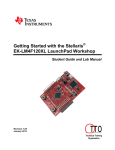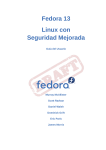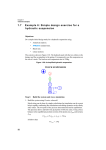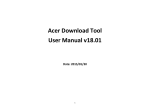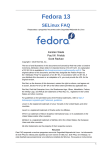Download Downloading - All IT eBooks
Transcript
www.allitebooks.com www.allitebooks.com ExploringSEforAndroid www.allitebooks.com TableofContents ExploringSEforAndroid Credits Foreword AbouttheAuthors AbouttheReviewers www.PacktPub.com Supportfiles,eBooks,discountoffers,andmore Whysubscribe? FreeaccessforPacktaccountholders Preface Whatthisbookcovers Whatyouneedforthisbook Whothisbookisfor Conventions Readerfeedback Customersupport Downloadingtheexamplecode Errata Piracy Questions 1.LinuxAccessControls Changingpermissionbits Changingownersandgroups Thecaseformore Capabilitiesmodel Android’suseofDAC GlancingatAndroidvulnerabilities Skypevulnerability GingerBreak www.allitebooks.com Rageagainstthecage MotoChopper Summary 2.MandatoryAccessControlsandSELinux Gettingbacktothebasics Labels Users Roles Types Accessvectors Multilevelsecurity Puttingittogether Complexitiesandbestpractices Summary 3.AndroidIsWeird Android’ssecuritymodel Binder Binder’sarchitecture Binderandsecurity Zygote–applicationspawn Thepropertyservice Summary 4.InstallationontheUDOO Retrievingthesource FlashingimageonanSDcard UDOOserialandAndroidDebugBridge Flippingtheswitch It’salive Summary 5.BootingtheSystem Policyload www.allitebooks.com Fixingthepolicyversion Summary 6.ExploringSELinuxFS Locatingthefilesystem Interrogatingthefilesystem Theenforcenode Thedisablefileinterface Thepolicyfile Thenullfile Themlsfile Thestatusfile AccessVectorCache Thebooleansdirectory Theclassdirectory Theinitial_contextsdirectory Thepolicy_capabilitiesdirectory ProcFS JavaSELinuxAPI Summary 7.UtilizingAuditLogs Upgrades–patchesgalore Theauditsystem Theauditddaemon Auditdinternals InterpretingSELinuxdeniallogs Contexts Summary 8.ApplyingContextstoFiles Labelingfilesystems fs_use fs_task_use www.allitebooks.com fs_use_trans genfscon Mountoptions Labelingwithextendedattributes Thefile_contextsfile Dynamictypetransitions Examplesandtools Fixingup/data Asidenoteonsecurity Summary 9.AddingServicestoDomains Init–thekingofdaemons Dynamicdomaintransitions Explicitcontextsviaseclabel Relabelingprocesses Limitationsonapplabeling Summary 10.PlacingApplicationsinDomains Thecasetosecurethezygote Fortifyingthezygote Plumbingthezygotesocket Themac_permissions.xmlfile keys.conf seapp_contexts Summary 11.LabelingProperties Labelingviaproperty_contexts Permissionsonproperties Relabelingexistingproperties Creatingandlabelingnewproperties Specialproperties www.allitebooks.com Controlproperties Persistentproperties SELinuxproperties Summary 12.MasteringtheToolChain Buildingsubcomponents–targetsandprojects Exploringsepolicy’sAndroid.mk Buildingsepolicy Controllingthepolicybuild Diggingdeeperintobuild_policy Buildingmac_permissions.xml Buildingseapp_contexts Buildingfile_contexts Buildingproperty_contexts CurrentNSAresearchfiles Standalonetools sepolicy-check sepolicy-analyze Summary 13.GettingtoEnforcingMode UpdatingtoSEPolicymaster Purgingthedevice SettingupCTS RunningCTS Gatheringtheresults CTStestresults Auditlogs Authoringdevicepolicy adbd bootanim debuggerd www.allitebooks.com drmserver dumpstate installd keystore mediaserver netd rild servicemanager surfaceflinger system_server toolbox untrusted_app vold watchdogd wpa Secondpolicypass init shell init_shell.te Fieldtrials Goingenforcing Summary A.TheDevelopmentEnvironment VirtualBox UbuntuLinux12.04(precisepangolin) VirtualBoxextensionpackandguestadditions VirtualBoxextensionpack VirtualBoxguestadditions Savetimewithsharedfolders Thebuildenvironment OracleJava6 www.allitebooks.com Summary Index www.allitebooks.com ExploringSEforAndroid ExploringSEforAndroid Copyright©2015PacktPublishing Allrightsreserved.Nopartofthisbookmaybereproduced,storedinaretrievalsystem, ortransmittedinanyformorbyanymeans,withoutthepriorwrittenpermissionofthe publisher,exceptinthecaseofbriefquotationsembeddedincriticalarticlesorreviews. Everyefforthasbeenmadeinthepreparationofthisbooktoensuretheaccuracyofthe informationpresented.However,theinformationcontainedinthisbookissoldwithout warranty,eitherexpressorimplied.Neithertheauthors,norPacktPublishing,andits dealersanddistributorswillbeheldliableforanydamagescausedorallegedtobecaused directlyorindirectlybythisbook. PacktPublishinghasendeavoredtoprovidetrademarkinformationaboutallofthe companiesandproductsmentionedinthisbookbytheappropriateuseofcapitals. However,PacktPublishingcannotguaranteetheaccuracyofthisinformation. Firstpublished:February2015 Productionreference:1190215 PublishedbyPacktPublishingLtd. LiveryPlace 35LiveryStreet BirminghamB32PB,UK. ISBN978-1-78439-059-4 www.packtpub.com Credits Authors WilliamConfer WilliamRoberts Reviewers JoshuaBrindle HiromuYakura CommissioningEditor UshaIyer AcquisitionEditor ReshmaRaman ContentDevelopmentEditor ArvindKoul TechnicalEditor ShinyPoojary CopyEditors ShivangiChaturvedi VikrantPhadke NehaVyas ProjectCoordinator NehaBhatnagar Proofreaders PaulHindle StephenSilk Indexer PriyaSane ProductionCoordinator ConidonMiranda CoverWork ConidonMiranda Foreword ThefirsttalkofSELinuxonAndroidstartedalmostassoonasAndroidwasannounced. Theinterestatthattimewasmainlyshownbyacademiccirclesanddevelopersof SELinuxitself.AsalongtimeuserofSELinuxinserverdeployments,Iknewitsbenefits fromasecuritypointofviewandalsoknewhowmuchAndroidcouldbenefitfromthem. Atthattime,ImayhavebeencoyaboutthereasonsIwantedtocommitsomeoftheinitial patchestotheSELinuxproject.LookingbackatthecodereviewsforthoseAndroidOpen SourceProject(AOSP)changes,Inowrememberhowmuchresistancetherewasinthe beginning.Spaceondeviceswasatapremium,anditwasconsideredavictoryifwe couldsaveafewkilobytes.AndhereweretheSELinuxlibrariesandpoliciesthat increasedthesystemsizebythirtykilobytes!Theperformanceimpacthadnotevenbeen measuredatthattime. TheworkcontinuedunabatedwithSELinuxcontributors,suchasStephenSmalley, RobertCraig,JoshuaBrindle,andanauthorofthisbook,WilliamRoberts,aswellaswith thehelpofmycoworkersGeremyCondraandNickKralevichatGoogle.Slowly,through theherculeaneffortsofeveryoneinvolved,theprojectmaterializedandbecamemoreand morecomplete.SinceAndroid4.4KitKat,SELinuxisshippedinenforcingmode,andall Androiduserscanbenefitfromtheaddedprotectionthatitaffords. Thetaledoesn’tendthere!Now,it’syourturntolearn.Thisbookisthefirstreference availableforthespecificflavorofSELinuxfoundinAndroid.It’smysincerehopethat thisbookimpartstheknowledgeyouneedtounderstandandcontributetoitscontinued development.WilliamRobertshasbeensubmittingcodetoAOSPsincethebeginningof SELinuxforAndroid,andhisandDr.Confer’sknowledgeiscontainedinthesepages.It’s uptoyoutoreaditandhelpwritethenextchapterofthissaga. KennyRoot MountainView,CA AbouttheAuthors WilliamConferhasbeenengineeringembeddedandmobilesystemssince1997.Hehas workedforSamsungMobileasamanagingstaffengineerandcurrentlyteachescomputer scienceatSUNYPolytechnicInstitute.Heholdsapatentinlow-costcharacterrecognition forextremelyresource-limiteddevicesandhasmultipleotherpatentspendingformobile technologies. Mywife,Ása,sacrificedendlesslytohelpgivemethespaceandtimeneededforthis work,andIowehermorethanIcansay.MythreedaughtersalsoensuredIcouldn’t alwaysbeworkingonthisbookanddistractedmeinthebestpossibleways.Icouldn’trest ifIdidn’tthankallmyfall2014studentsfromSUNYPolytechnicInstitutewhoputup withmewhenIwassidetrackedbythisbook.Finally,andmostimportantly,mygreatest thanksgoestomycoauthor(andfriend,student,andteacher),WilliamRoberts,without whomIwouldhavetohavefoundanother. WilliamRobertsisasoftwareengineerwhoisfocusedonOS-levelsecurityandplatform enhancements.HeisoneoftheengineerswhofoundedtheSamsungKNOXproductand anearlyadopterofSEforAndroid.Hehasmadecontributionstoseveralopensource projects,suchasSEforAndroid,theAndroidOpenSourceProject,theLinuxKernel, CyanogenMod,andOpenSC.HisrecentinterestshavetakenhimtoSmartCard technologiesandthevirtualizationofsmartcards.Inhissparetime,heworkswithDr. ConferontheMiniatproject(http://www.miniat.org),avirtual,embeddedarchitecture simulator. IwouldliketothankDr.WilliamConfer,thecoauthor,forhelpingmewritethisbook;his contributionswereinvaluable.Also,Iwouldliketothankmywifeforsupportingmeand givingmethetimetodothis,eventhoughwewererenovatingthehouse.Also,Iwould liketothankmyfamilyandfriendsfortheirencouragementalongtheway. www.allitebooks.com AbouttheReviewers JoshuaBrindleistheCTOandcofounderofQuarkSecurityInc.,acompanyfocusedon solvingmobileandcross-domainsecurityproblems.Joshuahas12yearsofprofessional experienceintheareaofdevelopmentforgovernment,academic,andopensource softwarethatfocusesonsecurityinLinux.Joshuahascontributedtonumerousopen sourceprojects,bothasaprojectmaintainerandasadeveloper.Hisworkcanbefoundon allSELinuxsystemsandnearlyallLinuxsystems.Joshua’srecentexperiencefocuseson buildingsecuremobiledevicesusingtechnologiessuchasSecurityEnhancementsfor Android,mobiledevice,andapplicationmanagement. HiromuYakuraisastudentatNadaHighSchool,Japan.Heistheyoungestpersonto holdthenationalinformationsecurityqualificationfromJapan.Hehasgivenlectures aboutSEforAndroidatmanyconferences.Heisalsofamiliarwiththesecurity competition,CapturetheFlag(CTF),andhasparticipatedinDEFCONCTF2014asa teambinja. Iwouldliketoexpressmygratitudetomyfamilyfortheirunderstandingandsupport. www.PacktPub.com Supportfiles,eBooks,discountoffers,and more Forsupportfilesanddownloadsrelatedtoyourbook,pleasevisitwww.PacktPub.com. DidyouknowthatPacktofferseBookversionsofeverybookpublished,withPDFand ePubfilesavailable?YoucanupgradetotheeBookversionatwww.PacktPub.comandas aprintbookcustomer,youareentitledtoadiscountontheeBookcopy.Getintouchwith usat<[email protected]>formoredetails. Atwww.PacktPub.com,youcanalsoreadacollectionoffreetechnicalarticles,signup forarangeoffreenewslettersandreceiveexclusivediscountsandoffersonPacktbooks andeBooks. https://www2.packtpub.com/books/subscription/packtlib DoyouneedinstantsolutionstoyourITquestions?PacktLibisPackt’sonlinedigital booklibrary.Here,youcansearch,access,andreadPackt’sentirelibraryofbooks. Whysubscribe? FullysearchableacrosseverybookpublishedbyPackt Copyandpaste,print,andbookmarkcontent Ondemandandaccessibleviaawebbrowser FreeaccessforPacktaccountholders IfyouhaveanaccountwithPacktatwww.PacktPub.com,youcanusethistoaccess PacktLibtodayandview9entirelyfreebooks.Simplyuseyourlogincredentialsfor immediateaccess. Preface ThisbookintroducestheSecurityEnhancements(SE)forAndroidopensourceproject andwalksyouthroughtheprocessofsecuringnewembeddedsystemswithSEfor Android.Toourknowledge,thisbookisthefirstsourcetodocumentsuchaprocessinits entiretysothatstudents,DIYhobbyists,andengineerscancreatecustomsystemssecured bySEforAndroid.Generally,onlyoriginalequipmentmanufacturers(OEMs)dothis,and quitecommonly,thetargetdeviceisaphoneortablet.Wetrulyhopeourbookwillchange that,engagingawideaudienceindevelopmentsotheycanuseandunderstandthese modernsecuritytools. Weworkedveryhardtoensurethistextisnotjustastep-by-steptechnologybook. Specifically,we’vechosenamodelthatdirectsyoutofailyourwaytosuccess.Youwill firstgainappropriatetheoreticalunderstandingofhowsecurityisgainedandenforced. Thenwewillintroduceasystemthathasneverbeensecuredthatway(notevenbyus, priortowritingthisbook).Next,we’llguideyouthroughallourintelligentguesswork, embracingunexpectedfailuresforthenewlyfoundidiosyncrasiestheyexpose,and eventuallyenforcingourcustomsecuritypolicies.Itrequiresyoutolearntoresolve differencesbetweenmajoropensourceprojectssuchasSELinux,SEforAndroid,and GoogleAndroid,eachofwhichhasindependentgoalsanddeploymentschedules.This preparesyoutosecureotherdevices,theprocessforwhichisalwaysdifferent,but hopefully,willnowbemoreaccessible. Whatthisbookcovers Chapter1,LinuxAccessControls,discussesthebasicsofDiscretionaryAccessControl (DAC),howsomeAndroidexploitsleverageDACproblems,anddemonstratetheneed formorerobustsolutions. Chapter2,MandatoryAccessControlsandSELinux,examinesMandatoryAccessControl (MAC)anditsmanifestationinSELinux.Thischapteralsoexplorestangiblepolicyto controlSELinuxobjectinteraction. Chapter3,AndroidIsWeird,introducestheAndroidsecuritymodelandinvestigates binder,zygote,andthepropertyservice. Chapter4,InstallationontheUDOO,walksthroughbuildinganddeployingAndroid fromsourcetotheUDOO-embeddedboardandturnsonSELinuxsupport. Chapter5,BootingtheSystem,followsthebootprocessfromthepolicyloading perspectiveandcorrectsissuestogetSELinuxtoausablestateontheUDOO. Chapter6,ExploringSELinuxFS,examinestheSELinuxFSfilesystemandhowitprovides thekernel-to-userspaceinterfaceforhigher-levelidioms. Chapter7,UtilizingAuditLogs,investigatestheauditsubsystem,revealinghowto interpretSELinuxauditlogsforthebenefitofpolicywriting. Chapter8,ApplyingContextstoFiles,teachesyouhowfilesystemsandfilesystemobjects gettheirlabelsandcontexts,demonstratingtechniquestochangethem,includingdynamic typetransitions. Chapter9,AddingServicestoDomains,emphasizesprocesslabeling,notablytheAndroid servicesrunandmanagedbyinit. Chapter10,PlacingApplicationsinDomains,showsyouhowtoproperlylabeltheprivate datadirectoriesofapplications,aswellasapplicationruntimecontextsviaconfiguration filesandSELinuxpolicy. Chapter11,LabelingProperties,demonstrateshowtocreateandlabelnewandexisting properties,andsomeoftheanomaliesthatoccurwhendoingso. Chapter12,MasteringtheToolChain,covershowthevariouscomponentsthatcontrol policyonthedeviceareactuallybuiltandcreated.ThischapterreviewstheAndroid.mk components,detailinghowtheheartofthebuildandconfigurationmanagementworks. Chapter13,GettingtoEnforcingMode,utilizesalltheskillsyoulearnedintheearlier chapterstorespondtoauditlogsfromCTSandgettheUDOOinenforcingmode. Appendix,TheDevelopmentEnvironment,walksyouthroughthenecessarystepsof settingupaLinuxenvironmentsuitableforyoutofollowalltheactivitiesinthisbook. www.allitebooks.com Whatyouneedforthisbook Hardwarerequirementsinclude: AUDOO-embeddeddevelopmentboard An8GBMiniSDcard(whileyoucanuseacardwithgreatercapacity,wedonot recommendedit) Aminimumof16GBofRAM Atleast80GBoffreeharddrivespace Softwarerequirementsinclude: AnUbuntu12.04LTSdesktopsystem OracleJDK6.0version6u45 SomeadditionalmiscellaneousLinuxsoftwareisrequired,butthesearedescribedin thebookandareavailableforfree. Whothisbookisfor Thisbookisintendedfordevelopersandengineerswhoaresomewhatfamiliarwith operatingsystemconceptsasimplementedbyLinux.Theycouldbehobbyistswantingto securetheirAndroid-poweredcreations,OEMengineersbuildinghandsets,orengineers fromemergingareaswhereAndroidisseeinggrowth.AbasicbackgroundinC programmingwillbehelpful. Conventions Inthisbook,youwillfindanumberoftextstylesthatdistinguishbetweendifferentkinds ofinformation.Herearesomeexamplesofthesestylesandexplanationsoftheir meanings. Codewordsintext,databasetablenames,foldernames,filenames,fileextensions, pathnames,dummyURLs,userinput,andTwitterhandlesareshownasfollows:“Now let’sattempttoexecutethehello.txtfileandseewhathappens.” Ablockofcodeissetasfollows: caseINTERFACE_TRANSACTION: { reply.writeString(DESCRIPTOR); returntrue; } Anycommand-lineinputoroutputiswrittenasfollows: $sutestuser Password: testuser@ubuntu:/home/bookuser$ Newtermsandimportantwordsareshowninbold.Wordsthatyouseeonthescreen, forexample,inmenusordialogboxes,appearinthetextlikethis:“Exittheconfiguration menusbyselectingExituntilyouareaskedtosaveyournewconfiguration.” Note Warningsorimportantnotesappearinaboxlikethis. Tip Tipsandtricksappearlikethis. Readerfeedback Feedbackfromourreadersisalwayswelcome.Letusknowwhatyouthinkaboutthis book—whatyoulikedordisliked.Readerfeedbackisimportantforusasithelpsus developtitlesthatyouwillreallygetthemostoutof. Tosendusgeneralfeedback,simplye-mail<[email protected]>,andmentionthe book’stitleinthesubjectofyourmessage. Ifthereisatopicthatyouhaveexpertiseinandyouareinterestedineitherwritingor contributingtoabook,seeourauthorguideatwww.packtpub.com/authors. Customersupport NowthatyouaretheproudownerofaPacktbook,wehaveanumberofthingstohelp youtogetthemostfromyourpurchase. www.allitebooks.com Downloadingtheexamplecode Youcandownloadtheexamplecodefilesfromyouraccountathttp://www.packtpub.com forallthePacktPublishingbooksyouhavepurchased.Ifyoupurchasedthisbook elsewhere,youcanvisithttp://www.packtpub.com/supportandregistertohavethefilesemaileddirectlytoyou. Errata Althoughwehavetakeneverycaretoensuretheaccuracyofourcontent,mistakesdo happen.Ifyoufindamistakeinoneofourbooks—maybeamistakeinthetextorthe code—wewouldbegratefulifyoucouldreportthistous.Bydoingso,youcansaveother readersfromfrustrationandhelpusimprovesubsequentversionsofthisbook.Ifyoufind anyerrata,pleasereportthembyvisitinghttp://www.packtpub.com/submit-errata, selectingyourbook,clickingontheErrataSubmissionFormlink,andenteringthe detailsofyourerrata.Onceyourerrataareverified,yoursubmissionwillbeacceptedand theerratawillbeuploadedtoourwebsiteoraddedtoanylistofexistingerrataunderthe Erratasectionofthattitle. Toviewthepreviouslysubmittederrata,goto https://www.packtpub.com/books/content/supportandenterthenameofthebookinthe searchfield.TherequiredinformationwillappearundertheErratasection. Piracy PiracyofcopyrightedmaterialontheInternetisanongoingproblemacrossallmedia.At Packt,wetaketheprotectionofourcopyrightandlicensesveryseriously.Ifyoucome acrossanyillegalcopiesofourworksinanyformontheInternet,pleaseprovideuswith thelocationaddressorwebsitenameimmediatelysothatwecanpursuearemedy. Pleasecontactusat<[email protected]>withalinktothesuspectedpirated material. Weappreciateyourhelpinprotectingourauthorsandourabilitytobringyouvaluable content. Questions Ifyouhaveaproblemwithanyaspectofthisbook,youcancontactusat <[email protected]>,andwewilldoourbesttoaddresstheproblem. Chapter1.LinuxAccessControls Androidisanoperatingsystemcomposedoftwodistinctcomponents.Thefirst componentisaforkedmainlineLinuxkernelandsharesalmosteverythingincommon withLinux.Thesecondcomponent,whichwillbediscussedlater,istheuserspace portion,whichisverycustomandAndroidspecific.SincetheLinuxkernelunderpinsthis systemandisresponsibleforthemajorityofaccesscontroldecisions,itisthelogical placetobeginadetailedlookatAndroid. Inthischapterwewill: ExaminethebasicsofDiscretionaryAccessControl IntroduceLinuxpermissionsflagsandcapabilities Tracesyscallsaswevalidateaccesspolicies Makethecaseformorerobustaccesscontroltechnology DiscussAndroidexploitsthatleverageproblemswithDiscretionaryAccessControl Linux’sdefaultandfamiliaraccesscontrolmechanismiscalledDiscretionaryAccess Control(DAC).Thisisjustatermthatmeanspermissionsregardingaccesstoanobject areatthediscretionofitscreator/owner. InLinux,whenaprocessinvokesmostsystemcalls,apermissioncheckisperformed.As anexample,aprocesswishingtoopenafilewouldinvoketheopen()syscall.Whenthis syscallisinvoked,acontextswitchisperformed,andtheoperatingsystemcodeis executed.TheOShastheabilitytodeterminewhetherafiledescriptorshouldbereturned totherequestingprocessornot.Duringthisdecision-makingprocess,theOSchecksthe accesspermissionsofboththerequestingprocessandthetargetfileitwishestoobtainthe filedescriptorto.EitherthefiledescriptororEPERMisreturned,dependentonwhether thepermissioncheckspassorfailrespectively. Linuxmaintainsdatastructuresinthekernelformanagingthesepermissionfields,which areaccessiblefromuserspace,andonesthatshouldbefamiliartoLinuxand*NIXusers alike.Thefirstsetofaccesscontrolmetadatabelongstotheprocess,andformsaportion ofitscredentialset.Thecommoncredentialsareuserandgroup.Ingeneral,weusethe termgrouptomeanbothprimarygroupandpossiblesecondarygroup(s).Youcanview thesepermissionsbyrunningthepscommand: $ps-eopid,comm,user,group,supgrp PIDCOMMANDUSERGROUPSUPGRP 1initrootroot... 2993system-service-rootrootroot 3276chromium-browsebookusersudofusebookuser ... Asyoucansee,wehaveprocessesrunningastheusersrootandbookuser.Youcanalso seethattheirprimarygroupisonlyonepartoftheequation.Processesalsohavea secondarysetofgroupscalledsupplementarygroups.Thissetmightbeempty,indicated bythedashintheSUPGRPfield. Thefilewewishtoopen,referredtoasthetargetobject,target,orobjectalsomaintainsa setofpermissions.TheobjectmaintainsUSERandGROUP,aswellasasetofpermission bits.Inthecontextofthetargetobject,USERcanbereferredtoasownerorcreator. $ls-la total296 drwxr-xr-x38bookuserbookuser4096Aug2311:08. drwxr-xr-x3rootroot4096Jun818:50.. -rw-rw-r--1bookuserbookuser116Jul2213:13a.c drwxrwxr-x4bookuserbookuser4096Aug416:20.android -rw-rw-r--1bookuserbookuser130Jun1917:51.apport-ignore.xml -rw-rw-r--1bookuserbookuser365Jun2319:44hello.txt -rw-------1bookuserbookuser19276Aug416:36.bash_history ... Ifwelookattheprecedingcommand’soutput,wecanseethathello.txthasaUSERof bookuserandGROUPasbookuser.Wecanalsoseethepermissionbitsorflagsonthelefthandsideoftheoutput.Therearesevenfieldstoconsideraswell.Eachemptyfieldis denotedwithadash.Whenprintedwithls,thefirstfieldscangetconvolutedby semantics.Forthisreason,let’susestattoinvestigatethefilepermissions: $stathello.txt File:`hello.txt' Size:365Blocks:8IOBlock:4096regularfile Device:801h/2049dInode:1587858Links:1 Access:(0664/-rw-rw-r--)Uid:(1000/bookuser)Gid:(1000/bookuser) Access:2014-08-0415:53:01.951024557-0700 Modify:2014-06-2319:44:14.308741592-0700 Change:2014-06-2319:44:14.308741592-0700 Birth:- Thefirstaccesslineisthemostcompelling.Itcontainsalltheimportantinformationfor theaccesscontrols.Thesecondlineisjustatimestamplettingusknowwhenthefilewas lastaccessed.Aswecansee,USERorUIDoftheobjectisbookuser,andGROUPis bookuseraswell.Thepermissionflags,(0664/-rw-rw-r--),identifythetwowaysthat permissionflagsarerepresented.Thefirst,theoctalform0664,condenseseachthree-flag fieldintooneofthethreebase-8(octal)digits.Thesecondisthefriendlyform,-rw-rw-r-,equivalenttotheoctalformbuteasiertointerpretvisually.Ineithercase,wecanseethe leftmostfieldis0,andtherestofourdiscussionswillignoreit.Thatfieldisforsetuid andsetgidcapabilities,whichisnotimportantforthisdiscussion.Ifweconvertthe remainingoctaldigits,664,tobinary,weget110110100.Thisbinaryrepresentation directlyrelatestothefriendlyform.Eachtriplemapstoread,write,andexecute permissions.OftenyouwillseethispermissiontriplerepresentedasRWX.Thefirsttriple arethepermissionsgiventoUSER,thesecondarethepermissionsgiventoGROUP,andthe thirdiswhatisgiventoOTHERS.TranslatingtoconventionalEnglishwouldyield,“The user,bookuser,haspermissiontoreadfromandwritetohello.txt.Thegroup, bookuser,haspermissiontoreadfromandwritetohello.txt,andeveryoneelsehas permissiononlytoreadfromhello.txt.”Let’stestthiswithsomereal-worldexamples. Changingpermissionbits Let’stesttheaccesscontrolsintheexamplerunningprocessesasuserbookuser.Most processesruninthecontextoftheuserthatinvokedthem(excludingsetuidandgetuid programs),soanycommandweinvokeshouldinheritouruser’spermissions.Wecan viewitbyissuing: $groupsbookuser bookuser:bookusersudofuse Myuser,bookuser,isUSERbookuser,GROUPbookuserandSUPGRPsudoandfuse. Totestforreadaccess,wecanusethecatcommand,whichopensthefileandprintsits contenttostdout: $cathello.txt Hello,"ExploringSEforAndroid" Hereisasimpletextfilefor yourenjoyment. ... Wecanintrospectthesyscallsexecutedbyrunningthestracecommandandviewingthe output: $stracecathello.txt ... open("hello.txt",O_RDONLY)=3 ... read(3,"Hello,\"ExploringSEforAndroid\"\n"...,32768)=365 ... Theoutputcanbequiteverbose,soIamonlyshowingtherelevantparts.Wecanseethat catinvokedtheopensyscallandobtainedthefiledescriptor3.Wecanusethatdescriptor tofindotheraccessesviaothersyscalls.Laterwewillseeareadoccurringonfile descriptor3,whichreturns365,thenumberofbytesread.Ifwedidn’thavepermissionto readfromhello.txt,theopenwouldfail,andwewouldneverhaveavalidfiledescriptor forthefile.Wewouldadditionallyseethefailureinthestraceoutput. Nowthatreadpermissionisverified,let’strywrite.Onesimplewaytodothisistowritea simpleprogramthatwritessomethingtotheexistingfile.Inthiscase,wewillwritethe linemynewtext\n(refertowrite.c.) Compiletheprogramusingthefollowingcommand: $gcc-omywritewrite.c Nowrunusingthenewlycompiledprogram: $strace./mywritehello.txt Onverification,youwillsee: ... open("hello.txt",O_WRONLY)=3 write(3,"mynewtext\n",12)=12 ... Asyoucansee,thewritesucceededandreturned12,thenumberofbyteswrittento hello.txt.Noerrorswerereported,sothepermissionsseeminchecksofar. Nowlet’sattempttoexecutehello.txtandseewhathappens.Weareexpectingtoseean error.Let’sexecuteitlikeanormalcommand: $./hello.txt bash:./hello.txt:Permissiondenied Thisisexactlywhatweexpected,butlet’sinvokeitwithstracetogainadeeper understandingofwhatfailed: $strace./hello.txt ... execve("./hello.txt",["./hello.txt"],[/*39vars*/])=-1EACCES (Permissiondenied) ... Theexecvesystemcall,whichlaunchesprocesses,failedwithEACCESS.Thisisjustthe sortofthingonewouldhopeforwhennoexecutepermissionisgiven.TheLinuxaccess controlsworkedasexpected! Let’stesttheaccesscontrolsinthecontextofanotheruser.First,we’llcreateanewuser calledtestuserusingtheaddusercommand: $sudoaddusertestuser [sudo]passwordforbookuser: Addinguser`testuser'... Addingnewgroup`testuser'(1001)... Addingnewuser`testuser'(1001)withgroup`testuser'... Creatinghomedirectory`/home/testuser'... ... VerifytheUSER,GROUP,andSUPGRPoftestuser: $groupstestuser testuser:testuser SincetheUSERandGROUPdonotmatchanyofthepermissionsona.S,allaccesseswillbe subjecttotheOTHERSpermissionschecks,whichifyourecall,isreadonly(0664). Startbytemporarilyworkingastestuser: $sutestuser Password: testuser@ubuntu:/home/bookuser$ Asyoucansee,wearestillinbookuser’shomedirectory,butthecurrentuserhasbeen changedtotestuser. Wewillstartbytestingreadwiththecatcommand: $stracecathello.txt ... open("hello.txt",O_RDONLY)=3 ... read(3,"mynewtext\n",32768)=12 ... Similartotheearlierexample,testusercanreadthedatajustfine,asexpected. Nowlet’smoveontowrite.Theexpectationisthatthiswillfailwithoutappropriate access: $strace./mywritehello.txt ... open("hello.txt",O_WRONLY)=-1EACCES(Permission denied) ... Asexpected,thesyscalloperationfailed.Whenweattempttoexecutehello.txtas testuser,thisshouldfailaswell: $strace./hello.txt ... execve("./hello.txt",["./hello.txt"],[/*40vars*/])=-1EACCES (Permissiondenied) ... Nowweneedtotestthegroupaccesspermissions.Wecandothisbyaddinga supplementarygrouptotestuser.Todothis,weneedtoexittobookuser,whohas permissionstoexecutethesudocommand: $exit exit $sudousermod-Gbookusertestuser Nowlet’scheckthegroupsoftestuser: $groupstestuser testuser:testuserbookuser Asaresultoftheprevioususermodcommandtestusernowbelongstotwogroups: testuserandbookuser.Thatmeanswhentestuseraccessesafileorotherobject(such asasocket)withthegroupbookuser,theGROUPpermissions,ratherthanOTHERS,will applytoit.Inthecontextofhello.txt,testusercannowreadfromandwritetothefile, butnotexecuteit. Switchtotestuserbyexecutingthefollowingcommand: $sutestuser Testreadbyexecutingthefollowingcommand: $stracecat./hello.txt ... open("./hello.txt",O_RDONLY)=3 ... read(3,"mynewtext\n",32768)=12 ... www.allitebooks.com Asbefore,testuserisabletoreadthefile.Theonlydifferenceisthatitcannowreadthe filethroughtheaccesspermissionsofOTHERSandGROUP. Testwritebyexecutingthefollowingcommand: $strace./mywritehello.txt ... open("hello.txt",O_WRONLY)=3 write(3,"mynewtext\n",12)=12 ... Thistime,testuserwasabletowritethefileaswell,insteadoffailingwiththeEACCESS permissionerrorshownbefore. Attemptingtoexecutethefileshouldstillfail: $strace./hello.txt execve("./hello.txt",["./hello.txt"],[/*40vars*/])=-1EACCES (Permissiondenied) ... TheseconceptsarethefoundationofLinuxaccesscontrolpermissionbits,usersand groups. Changingownersandgroups Usinghello.txtforexploratoryworkintheprevioussections,wehaveshownhowthe ownerofanobjectcanallowvariousformsofaccessbymanagingthepermissionbitsof theobject.Changingthepermissionsisaccomplishedusingthechmodsyscall.Changing theuserand/orgroupisdonewiththechownsyscall.Inthissection,wewillinvestigate thedetailsoftheseoperationsinaction. Let’sstartbygrantingreadandwritepermissionsonlytotheownerofhello.txtfile, bookuser. $chmod0600hello.txt $stathello.txt File:`hello.txt' Size:12Blocks:8IOBlock:4096regularfile Device:801h/2049dInode:1587858Links:1 Access:(0600/-rw-------)Uid:(1000/bookuser)Gid:(1000/bookuser) Access:2014-08-2312:34:30.147146826-0700 Modify:2014-08-2312:47:19.123113845-0700 Change:2014-08-2312:59:04.275083602-0700 Birth:- Aswecansee,thefilepermissionsarenowsettoonlyallowreadandwriteaccessfor bookuser.Athoroughreadercouldexecutethecommandsfromearliersectionsinthis chaptertoverifythatpermissionsworkasexpected. Changingthegroupcanbedoneinasimilarfashionwithchown.Let’schangethegroupto testuser: $chownbookuser:testuserhello.txt chown:changingownershipof`hello.txt':Operationnotpermitted Thisdidnotworkasweintended,butwhatistheissue?InLinux,onlyprivileged processescanchangetheUSERandGROUPfieldsofobjects.TheinitialUSERandGROUP fieldsaresetduringobjectcreationfromtheeffectiveUSERandGROUP,whicharechecked whenattemptingtoexecutethatprocess.Onlyprocessescreateobjects.Privileged processescomeintwoforms:thoserunningasthealmightyrootandthosethathavetheir capabilitiesset.Wewilldiveintothedetailsofcapabilitieslater.Fornow,let’sfocuson theroot. Let’schangetheusertoroottoensureexecutingthechowncommandwillchangethe groupofthatobject: $sudosu #chownbookuser:testuserhello.txt Now,wecanverifythechangeoccurredsuccessfully: #stathello.txt File:`hello.txt' Size:12Blocks:8IOBlock:4096regularfile Device:801h/2049dInode:1587858Links:1 Access:(0600/-rw-------)Uid:(1000/bookuser)Gid:(1001/testuser) Access:2014-08-2312:34:30.147146826-0700 Modify:2014-08-2312:47:19.123113845-0700 Change:2014-08-2313:08:46.059058649-0700 Birth:- Thecaseformore YoucanseetheGROUP(GID)isnowtestuser,andthingsseemreasonablysecurebecause inordertochangetheuserandgroupofanobject,youneedtobeprivileged.Youcanonly changethepermissionbitsonanobjectifyouownit,withtheexceptionoftherootuser. Thismeansthatifyou’rerunningasroot,youcandowhateveryouliketothesystem, evenwithoutpermission.Thisabsoluteauthorityiswhyasuccessfulattackoranerroron arootrunningprocesscancausegravedamagetothesystem.Also,asuccessfulattackon anon-rootprocesscouldalsocausedamagebyinadvertentlychangingthepermissions bits.Forexample,supposethereisanunintendedchmod0666commandonyourSSH privatekey.Thiswouldexposeyoursecretkeytoallusersonthesystem,whichisalmost certainlysomethingyouwouldneverwanttohappen.Therootlimitationispartially addressedbythecapabilitiesmodel. Capabilitiesmodel FormanyoperationsonLinux,theobjectpermissionmodeldoesn’tquitefit.Forinstance, changingUIDandGIDrequiressomemagicalUSERknownasroot.Supposeyouhavea longrunningservicethatneedstoutilizesomeofthesecapabilities.Perhapsthisservice listenstokerneleventsandcreatesthedevicenodesforyou?Suchaserviceexists,andit’s calledueventdorusereventdaemon.Thisdaemontraditionallyrunsasroot,which meansifitiscompromised,itcouldpotentiallyreadyourprivatekeysfromyourhome directoryandsendthembacktotheattacker.Thismightbeanextraordinaryexample,but it’smeanttoshowcasethatrunningprocessesasrootcanbedangerous.Supposeyou couldstartaserviceastherootuserandhavetheprocesschangeitsUIDandGIDto somethingnotprivileged,butretainsomesmallersetofprivilegedcapabilitiestodoits job?ThisisexactlywhatthecapabilitiesmodelinLinuxis. ThecapabilitiesmodelinLinuxisanattempttobreakdownthesetofpermissionsthat roothasintosmallersubsets.Thisway,processescanbeconfinedtothesetofminimum privilegestheyneedtoperformtheirintendedfunction.Thisisknownasleastprivilege,a keyideologywhensecuringsystemsthatminimizestheamountofdamageasuccessful attackcando.Insomeinstances,itcanevenpreventasuccessfulattackfromoccurringby blockinganotherwiseopenattackvector. Therearemanycapabilities.Themanpageforcapabilitiesisthedefactodocumentation. Let’stakealookattheCAP_SYS_BOOTcapability: $mancapabilities ... CAP_SYS_BOOT Usereboot(2)andkexec_load(2). Thismeansaprocessrunningwiththiscapabilitycanrebootthesystem.However,that processcan’tarbitrarilychangeUSERSandGROUPasitcouldifitwasrunningasrootor withCAP_DAC_READ_SEARCH.Thislimitswhatanattackercando: <FROMMANPAGE> CAP_DAC_READ_SEARCH Bypassfilereadpermissionchecksanddirectoryreadandexecute permissionchecks. NowsupposethecasewhereourrestartprocessrunswithCAP_CHOWN.Let’ssayitusesthis capabilitytoensurethatwhenarestartrequestisreceived,itbacksupafilefromeach user’shomedirectorytoaserverbeforerestarting.Let’ssaythisfileis~/backup,the permissionsare0600,andUSERandGROUParetherespectiveuserofthathomedirectory. Inthiscase,wehaveminimizedthepermissionsasbestwecan,buttheprocesscouldstill accesstheusersSSHkeysanduploadthoseeitherbyerrororattack.Anotherapproachto thiswouldbetosetthegrouptobackupandruntheprocesswithGROUPbackup. However,thishaslimitations.Supposeyouwanttosharethisfilewithanotheruser.That userwouldrequireasupplementarygroupofbackup,butnowtheusercanreadallofthe backupfiles,notjusttheonesintended.Anastutereadermightthinkaboutthebind mounts,howevertheprocessdoingthebindmountsandfilepermissionsalsorunswith somecapability,andthussuffersfromthisgranularityproblemaswell. Themajorissue,andthecaseforanotheraccesscontrolsystemcanbesummarizedbyone word,granularity.TheDACmodeldoesn’thavethegranularityrequiredtosafelyhandle complexaccesscontrolmodelsortominimizetheamountofdamageaprocesscando. ThisisparticularlyimportantonAndroid,wheretheentireisolationsystemisdependent onthiscontrol,andaroguerootprocesscancompromisethewholesystem. www.allitebooks.com Android’suseofDAC IntheAndroidsandboxmodel,everyapplicationrunsasitsownUID.Thismeansthat eachappcanseparateitsstoreddatafromoneanother.Theuserandgrouparesettothe UIDandGIDofthatapplication,sonoappcanaccesstheprivatefilesofanapplication withouttheapplicationexplicitlyperformingchmodonitsobjects.Also,applicationsin Androidcannothavecapabilities,sowedon’thavetoworryaboutcapabilitiessuchas CAP_SYS_PTRACE,whichistheabilitytodebuganotherapplication.InAndroid,ina perfectworld,onlysystemcomponentsrunwithprivileges,andapplicationsdon’t accidentallychmodprivatefilesforalltoread.Thisissuewasnotcorrectedbythecurrent AOSPSELinuxpolicyduetoappcompatibility,butcouldbeclosedwithSELinux.The properwaytosharedatabetweenapplicationsonAndroidisviabinder,andsharingfile descriptors.Forsmalleramountsofdata,theprovidermodelsuffices. GlancingatAndroidvulnerabilities WithournewlyfoundunderstandingoftheDACpermissionmodelandsomeofits limitations,let’slookatsomeAndroidexploitsagainstit.Wewillcoveronlyafew exploitstounderstandhowtheDACmodelfailed. Skypevulnerability CVE-2011-1717wasreleasedin2011.Inthisexploit,theSkypeapplicationleftaSQLite3 databaseworldreadable(somethinganalogousto0666permissions).Thisdatabase containedusernamesandchatlogs,andpersonaldatasuchasnameande-mail.An applicationcalledSkypwnedwasabletodemonstratethiscapability.Thisisanexample ofhowbeingabletochangethepermissionsonyourobjectscouldbebad,especially whenthecaseopensREADtoOTHERS. GingerBreak CVE-2011-1823showcasesarootattackonAndroid.Thevolumemanagementdaemon (vold)onAndroidisresponsibleforthemountingandunmountingoftheexternalSD card.ThedaemonlistensformessagesoveraNETLINKsocket.Thedaemonnever checkedwherethemessagesweresourcedfrom,andanyapplicationcouldopenand createaNETLINKsockettosendmessagestovold.Oncetheattackeropenedthe NETLINKsocket,theysentaverycarefullycraftedmessagetobypassasanitycheck. Thechecktestedasignedintegerforamaximumbound,butnevercheckeditfor negativity.Itwasthenusedtoindexanarray.Thisnegativeaccesswouldleadtomemory corruptionand,withapropermessage,couldresultintheexecutionofarbitrarycode.The GingerBreakimplementationresultedinanarbitraryusergainingrootprivileges,a textbookprivilegeexecutionattack.Oncerooted,thedevice’ssandboxeswerenolonger valid. Rageagainstthecage CVE-2010-EASYisasetuidexhaustionviaforkbombattack.Itsuccessfullyattacksthe adbdaemononAndroid,whichstartslifeasrootanddowngradesitspermissionsifrootis notneeded.Thisattackkeepsadbasrootandreturnsarootshelltotheuser.InLinux kernel2.6,thesetuidsystemcallreturnsanerrorwhenthenumberofrunningprocesses RLIMIT_NPROCismet.Theadbdaemoncodedoesnotcheckthereturnofsetuid,which leavesasmallracewindowopenfortheattacker.Theattackerneedstoforkenough processestoreachRLIMIT_NPROCandthenkillthedaemon.Theadbdaemondowngrades toshellUIDandtheattackerrunstheprogramasshellUSER,thusthekillwillwork.Atthis point,theadbserviceisrespawned,andifRLIMIT_NPROCismaxedout,setuidwillfail andadbwillstayrunningasroot.Then,runningadbshellfromahostreturnsaniceroot shelltotheuser. MotoChopper CVE-2013-2596isavulnerabilityinthemmapfunctionalityofaQualcommvideodriver. AccesstotheGPUisprovidedbyappstodoadvancedgraphicsrenderingsuchasinthe caseofOpenGLcalls.Thevulnerabilityinmmapallowstheattackertommapkerneladdress space,atwhichpointtheattackerisabletodirectlychangetheirkernelcredential structure.ThisexploitisanexamplewheretheDACmodelwasnotatfault.Inreality, outsideofpatchingthecodeorremovingdirectgraphicsaccess,nothingbutprogramming checksofthemmapboundscouldhavepreventedthisattack. Summary TheDACmodelisextremelypowerful,butitslackoffinegranularityanduseofan extraordinarilypowerfulrootuserleavessomethingtobedesired.Withtheincreasing sensitivityofmobilehandsetuse,thecasetoincreasethesecurityofthesystemiswellfounded.Thankfully,AndroidisbuiltonLinuxandthusbenefitsfromalargeecosystem ofengineersandresearchers.SincetheLinuxKernel2.6,anewaccesscontrolmodel calledMandatoryAccessControls(MAC)wasadded.Thisisaframeworkbywhich modulescanbeloadedintothekerneltoprovideanewformofaccesscontrolmodel.The veryfirstmodulewascalledSELinux.ItisusedbyRedHatandotherstosecuresensitive governmentsystems.Thus,asolutionwasfoundtoenablesuchaccesscontrolsfor Android. www.allitebooks.com Chapter2.MandatoryAccessControls andSELinux InChapter1,LinuxAccessControls,weintroducedsomeoftheshortcomingsofa discretionaryaccesscontrolsystem.Inthesesystems,theownerofanobjecthasfull controloveritspermissionsflagsandcandemonstrategreatercapabilities(forexample, theabilitytochown)whenexecutingasrootorwithcertaincapabilities.Inthischapter, wewill: ExaminethefundamentalsofMAC IntroducesomeindustrydriversforSELinux Discusslabels,users,roles,andtypes Exploretheimplementationoftangiblepolicytoallowandconstrainobject interaction IdealMACsystemsmaintainthepropertyofprovidingdefinitiveaccesscontrolson kernelresources,suchasfiles,irrespectiveofanobject’sowner.Forinstance,withaMAC system,theownerofanobjectmightnothavefullcontrolofitspermissions.InLinux,the MACframeworkworksorthogonallytothecurrentDACcontrols.Thismeansthatthe MACcontrolsdonotinterferewiththeDACcontrols.Inotherwords,toavoidpotential conflictsbetweentheMACandDACsystems,thekernelvalidatesaccessusingtheDAC permissionsbeforecheckingtheMACpermissions.IftheDACpermissionsresultina permissionsviolation,thentheMACpermissionsareneverchecked.Thekernelwill validateaccessagainsttheMACpermissionsprovideronlywhentheDACpermissions pass.FailureateitherlevelwillresultinareturnofEACCESS.IftheDACandtheMAC permissionspass,thenthekernelresource(forexample,afiledescriptor)issentbackto userspace. InLinux,aframeworkcalledtheLinuxSecurityModule(LSM)frameworkwasmerged duringtheLinux2.6.xseriesofkernels.Thisframeworkallowsyoutoenablethe mandatoryaccesscontrolsystemsinabuildtimeselectionbytetheringtheLSMhooksto thesecurityprovider.SecurityEnhancedLinux(SELinux)isthefirstconsumerofthis MACsecurityframeworkwithinthekernelandisanimplementationofamandatory accesscontrolsystem.SELinuxshipsinawidevarietyofLinuxsystems,suchasRedHat EnterpriseLinux(RHEL)andconsequentlyFedora.Recently,ithasbegunshipping withAndroid.ThesourcecodeforSELinuxcanbefoundintheLinuxsourcecodetree underkernel/security/selinuxforthosewishingtoreviewit. Gettingbacktothebasics SELinuxisareimplementationofadesignengineeredbytheU.S.governmentandThe UniversityofUtahknownastheFLUXAdvancedSecurityKernel(FLASK).The SELinuxandFLASKarchitectureprovideacentralpolicyfileutilizedwhiledetermining theresultsofaccesscontroldecisions.Thiscentralpolicyisinawhitelistform.This meansthatallaccesscontrolrulesmustbedefinedexplicitlybythepolicyfile.This policyfileisabstractedandservedbyasoftwarecomponentcalledasecurityserver. WhentheLinuxkernelneedstomakeanaccesscontroldecisionandSELinuxisenabled, thekernelinteractswiththesecurityserverbymeansoftheLSMhooks. Inarunningsystem,aprocessistheactiveentitythatgetstimeontheCPUtoperform tasks.Theusermerelyinvokestheseprocessestodotheworkontheirbehalf.Thisisan importantconcept.Aswetypethisbook,wetrustthatthewordprocessorsrunningonour machineswithourcredentialsaren’topeningourSSHkeysandembeddingtheminthe documentmetadata.Rightnow,theprocessisincontrolofthecomputingresources,not theuser.Theprocessistherunningentity,itistheprocessthatmakessystemcallstothe kernelforresources,notthephysicalhumanbeing.Withthisinmind,theveryfirstactor inthisSELinuxsystemistheprocess,typicallyreferredtoasthesubject.Itisthesubject thataccessesfiles.Itisthesubjectthatthesecurityserverwillusetomakeaccess decisionson. Consequently,thesubjectutilizeskernelresources.Thiskindofkernelresourceisan exampleofatarget.Thesubjectperformsactionsonthetarget.Naturally,oneshouldask, “Whatactionsdoesasubjectperform?”Theseareknownasaccessvectorsandtypically correlatetothenameofthesyscallperformed.Forexample,thesubjectcouldperforman openonthetarget.Itisimportanttonotethattargetscouldbeprocessesaswell.For instance,ifthesystemcallisptrace,thesubjectcouldbesomethingalongthelinesofa debugger,andthetargetwouldbetheprocessyouwishtodebug.Asubjectisfrequentlya process,butatargetcouldbeaprocess,socket,file,orsomethingelse. Labels SELinuxprovidessemanticsfordescribingpoliciesrelatedtothetargetsandsubjects usinglabels.Labelsarethemetadataassociatedwithanobjectthatmaintainsthesubject’s andtarget’saccessinformation.Thedataassociatedwiththisobjectisastring.Returning tothedebuggerexample,thegdbprocessmighthaveasubjectlabelstringofdebugger, andthetargetmighthavealabelofdebugee.Theninthesecuritypolicy,somesemantic couldbeusedtoexpressthatprocesseswiththesubjectlabeldebuggerareallowedto debugapplicationswithtargetlabeldebugee. Fortunately,andperhapsunfortunately,SELinuxdoesnotusesuchsimplelabels.Infact, thelabelsaremadeupoffourcolon-delimitedfields:user,role,type,andlevel.This additionalcomplexityaffordsveryflexiblecontroloptions. Users Theveryfirstfieldinalabelidentifiestheuser.Theuserfieldisusedaspartofthedesign foruser-basedaccesscontrols(UBAC).However,thisisnottypicallyassociatedwith humanusersasitiswiththeconceptofusersinDAC.SELinuxuserstypicallydefinea groupoftraditionalusers.Acommonexampleistoidentifyallnormalusersasthe SELinuxuser,user_u.Perhapsaseparateuserforsystemprocesses,suchassystem_u.By conventioninthedesktopSELinuxcommunity,userportionsofthestringaresuffixed witha_u. Roles Thesecondfieldinalabelisrole.Theroleisusedaspartofthedesignforrole-based accesscontrols(RBAC).Rolesareusedtoprovideadditionalgranularitytotheuser.For instance,supposewehavetheuserfield,sysadm_u,reservedforadministrators.The administratormightbeinseparatetasks,anddependingonthetasks,therole(and therefore,privileges)ofusersinsysadm_umaychange.Forexample,whenan administratorneedstomountandunmountfilesystems,therolefieldmightchangeto mount_admin_r.Whenanadministratorissettingtheiptablesrules,therolemight changetonet_admin_r.Rolesallowtheisolationofprivilegeswithinthescopeofthe tasksbeingperformed. Types Typeisthethirdfieldofthecolon-delimitedlabel.Thetypefieldisevaluatedduringthe typeenforcement(TE)portionofSELinux’saccesscontrolmodel.TEisthemajor componentthatdrivesSELinux’ssecuritycapabilities,anditisatthispointwherethe policystartstotakeeffect. SELinuxisbasedonawhitelistsystemwhereeverythingisdeniedbydefaultandrequires explicitapprovalfromthepolicyforaninteractiontooccur.Thisapprovalisinitially determinedfromthepolicyviaanallowrulethatreferencesboththesubject’sandtarget’s type.SELinuxtypescanalsobeassignedattributes.Attributesallowyoutogive numeroustypesacommonsetofrules.Attributescanhelpminimizetheamountoftypes, andcanbeusedinfashionsimilartothatofaninheritancemodel. Accessvectors Dataisaccessedbyprocessesviasystemcallsandpossibleuserdefinedaccessmethods. Theuserdefinedaccessmethodsareusuallycontrolledviaauserspaceobjectmanager. Theseaccesspaths,alsoknownasvectors,makeupasetofactionsthatcanbeappliedto theobject.Forinstance,ifaprocessopensafile,writessomedataintothefile,andthen readsitback,theaccessvectorsexercisedwouldbeopen,read,andwrite.Ifaprocess debugsanotherprocess,theaccessvectorwouldbeptrace. Multilevelsecurity SELinuxalsosupportsamultilevelsecurity(MLS)model,whichpayshomagetothe Bell-LaPadula(BLP)model,butalternatemodelscouldbeused.TheBLPmodelwas createdtoformalizetheDepartmentofDefense’ssecuritypolicies.Forexample,aperson withasecretclearanceshouldnotbeabletoreadtop-secretmaterial.However,let’s supposethispersonhasabrilliantideathatultimatelyneedstobeprotectedatthetopsecretlevel;thatdatacouldthenbe“up-classified”totop-secret.Thisisreferredtoas“no readuporwritedown”. TheSELinuximplementationofthisfieldhassubfields.Thefirstfieldissensitivity,and willalwaysbepresent.Inthecontextofthepreviousexample,pertinentsensitivities includesecretandtopsecret.Thesecondsubfieldiscategory,andmightnotbepresent. Thesefieldsalsomakesenseinthecontextofgovernmentclassification.Thedataitself mightbecompartmentalized,sowhilethesensitivityisthesame,suchastopsecret,the datashouldonlybedisseminatedtopeoplewithinthesamecompartmentorcategory. Sensitivitiesaredefinedinahierarchicalfashionviathedominancekeyword.Inatypical policy,s0isthelowestsensitivityandsNwheren>0isthehighest.Thus,s1hasa greatersensitivitythans0.Categoriesaresets.Thecontrolsassociatedwiththelevel, whichiscomprisedofsensitivitiesandpotentiallycategories,followsettheoryconcepts, suchasdominanceandequality.InMLSsecurity,allinteractionsareallowedbydefault, unliketypeenforcement.Boththesensitivityandthecategorycanberanged,and categoriescanbeenumerated.Thus,alabelmighthavesomenumberofsensitivitiesand differentnumberofcategories. Puttingittogether SELinuxlabelsarequiteflexibleandsometimescomplex.It’softenbeneficialtostart withacontrivedexamplethatfocusesontypeenforcement.Later,wecanaddadditional fieldslaterastheneedforfinergranularitybecomesmoreapparent.Conveniently,youcan projectthismodeltoscenariosineverydaylifetoprovidesomesenseoftangibilitytothe material.DanWalsh,aprominentSELinuxfigure,postedablogpostusingpetsasan analogy.Let’scontinueonwiththatpremise,butwewillmakesomemodificationsaswe goanddefineourownexamples.It’sbesttostartwithsimpletypeenforcementasitisthe easiesttounderstand. Note YoucanreadDanWalsh’soriginalblogpostintroducingthepetanalogyat http://opensource.com/business/13/11/selinux-policy-guide. Supposeweownacatandadog.Wedon’twantthecattoeatdogfood.Wedon’twantthe dogtoeatcatfood.Atthispoint,wehavealreadyidentifiedtwosubjects,acatandadog, andtwotargets,catfoodanddogfood.Wealsohaveidentifiedanaccessvector,eating. Wecanuseallowrulestoimplementourpolicy.Possiblerulescouldlooklikethis: allowcatcat_chow:foodeat; allowdogdog_chow:foodeat; Let’susethisexampletostartanddefineabasicsyntaxforexpressingtheaccesscontrols wewouldliketoenforce.Thefirsttokenisallow,statingwewishtoallowaninteraction betweenasubjectandatarget.Thedogisassignedthetype,dog,andthecat,cat.Thecat foodisassignedthetypecat_chow,andthedogfood,dog_chow.Theaccessvectorinthis caseiseat.Withthisbasicsyntax,whichisalsovalidSELinuxsyntax,werestrictthe animalstothefoodtheyshouldeat.Noticethe:foodannotationafterthetype.Thisisthe classfieldofthetargetobject.Forinstance,theremightalsobedog_chowtreatand cat_chowclassesthatcouldindicateourdesiretoallowaccesstotreatsinafashionthatis potentiallydifferentfromthewayweallowaccesstofoodsthatarenottreats. Let’ssaywegettwomoredogs,andourscenariohasthreedogs.Thedogsareofdifferent sizes:small,medium,andlarge.Wewanttomakesurenoneofthesenewdogseatothers’ food.Wecoulddosomethinglikecreateanewtypeforeachofthedogsandpreventdogs fromeatingthefoodofotherdogs.Itwouldlooksomethinglikethis: allowcatcat_chow:foodeat; allowdog_smalldog_small_chow:foodeat; allowdog_mediumdog_medium_chow:foodeat; allowdog_largedog_largechow:foodeat; Thiswouldwork;however,thetotalnumberoftypeswouldbedifficulttomanage,and thatwouldcontinuetogrowifweallowthelargedogtoeatthesmallerbreeds’food. WhatwecoulddoisuseMLSsupporttoassignasensitivitytoeachtargetordogfood bowl.Let’sassumethefollowing: Thecat’sfoodbowlhassensitivity,tiny Thesmalldog’sfoodbowlhassensitivity,small Themedium-sizeddog’sfoodbowlhassensitivity,medium Thelargedog’sfoodbowlhassensitivity,large Wealsoneedtomakesurethatthesubjectsarelabeledwiththepropersensitivityaswell: Thecatshouldhavesensitivity,tiny Thesmalldogshouldhavesensitivity,small Themedium-sizeddogshouldhavesensitivity,medium Thelargedogshouldhavesensitivity,large Atthispoint,weneedtointroduceadditionalsyntaxtoallowtheinteractions,sinceby default,MLSallowseverythingandTEdenieseverything.We’llusemlsconstrain,to restrictinteractionswithinthesystem.Therulecouldlooklikethis: mlsconstrainfoodeat(l1eql2); Thisconstraintonlyallowssubjectstoeatfoodwiththesamesensitivitylevel.SELinux definesthekeywordsl1andl2.Thel1keywordisthelevelofthetargetandl2isthe levelofthesource.Becausetherulesarepartofawhitelist,thisalsopreventssubjects fromeatingfoodthatdoesnothavetheequivalentsensitivitylevel. Now,let’ssaywegetyetanotherlargedog.Nowwehavetwolargebreeddogs.However, theyhavedifferentdietsandneedtoaccessdifferentfoods.Wecouldaddanewtypeor modifyanexistingtype,butthiswouldhavethesamelimitationsthatledustouse sensitivitiestopreventaccess.Wecouldaddanothersensitivity,butitmightgetconfusing thattherearelarge1andlarge2sensitivities.Atthispoint,categorieswouldallowusto getabitmoregranularinourcontrols.Supposeweaddacategorydenotingthebreed.Our MLSportionofourlabelwouldlooksomethinglikethis: large:golden_retriever large:black_lab Thesecouldbeusedtopreventtheblacklabfromeatingthegoldenretriever’sfood.Now supposeyou’resurprisedwithanotherdog,aSaintBernard.Let’ssaythisnewBernard caneatanylargedog’sfood,buttheotherlargedogscan’teathisfood.Wecouldlabelthe foodbowlsandthedogs. DogBreed Subjectlabel Targetlabel GoldenRetriever Dog:large:golden_retriver dog_chow:large:golden_retriver BlackLab Dog:large:black_lab dog_chow:large:black_lab SaintBernard Dog:large:saint_bernard,black_lab,golden_retriever dog_chow:large:saint_bernard Cat Cat:tiny cat_chow:tiny Theexistingmlsconstraintneedsmodification.IftheSaintBernardranoutoffoodand wenttotheBlackLab’sdish,theSaintBernardwouldnotbeabletoeatfromitsincethe levelsarenotequal(Dog:large:saint_bernard,black_lab,golden_retrieverisnot thesameasdog_chow:large:black_lab).Remember,thelevelsaresets,soweneedto introducesomenotionthatifthesubjectssetdominatesthetargetset,thatinteraction shouldbeallowed. Thiscouldbeaccomplishedwiththedomkeyword: mlsconstrainfoodeat(l1doml2); Thedominatekeyword,dom,differsfromequality,indicatingl1isasupersetofl2In otherwords,thelevelsassociatedwiththetarget,l2,areamongthepotentiallylargerset oflevelsassociatedwiththesubject,l1.Atthispoint,weareabletokeepallthefood separatedandusedhoweverweseefit. Aftergettingallthesedogs,yourealizeit’stimetofeedthem,soyougetabagofdog foodandputsomeineachbowl.However,beforeyoucanadddogfoodtothebowls,we needsomeallowrulesandlabelsthatwillletyou.Remember,SELinuxisawhitelistbasedsystem,andeverythingmustbeexplicitlyallowed. Wewilllabelthehumanwiththehumanlabelanddefinesomerules.Ohyeah…don’t forgettofeedthecat,aswell: allowhumandog_chow:foodput; allowhumancat_chow:foodput; Wewillalsoneedtolabelhumanwithallthesensitivitiesandcategories,butthiswould becomecumbersomewhenweneedtoaddadditionaldogs,breeds,andbreedsizestoour system.Wecouldjustbypasstheconstraintifthetypeishuman.Withthisapproach,we alwaystrusthumantoputthecorrectfoodintheappropriatebowl: mlsconstrainfoodeat(l1doml2); mlsconstrainfoodput(t1==human); NotetheadditionofputintheaccessvectorsoftheMLSconstraint.Viola!Thehuman cannowfeedhisever-growingpackofanimals. Soyourbirthdayrollsaround,andyoureceiveanautomaticdogfeederasapresent.You labelthefooddispenser,dispenserandmodifytheMLSconstraints: mlsconstrainfoodeat(l1doml2); mlsconstrainfoodput(t1==humanort1==dispenser); Again,weseeaneedtocondensethenumberoftypesandgetorganizedtopreventhaving toduplicatelines.Thisiswhereattributesarequitehandy.Wecanassignanattributeto ourhumananddispensertypesbyfirstdefiningtheattribute: attributefeeder; Thenwecanaddittothetype: typeattributehuman,feeder; typeattributedispenser,feeder; Thiscouldalsobedoneattypedeclaration: typehuman,feeder; typedispenser,feeder; Atthispoint,wecouldmodifytheMLSstatementstolooklikethis: mlsconstrainfoodeat(l1doml2); mlsconstrainfoodput(t1==feeder); Nowlet’ssupposeyouhireamaidservice.Youwanttoensureanyonesentbythemaid serviceisabletofeedyourpets.Forthatmatter,let’sletyourfamilymembersfeedthem, aswell.Thiswouldbeagoodusecasefortheusercapabilities.Wewilldefinethe followingusers:adults_u,kids_u,andmaid_u.Thenwe’llneedtoaddaconstraint statementtoallowinteractionsbytheseusers: mlsconstrainfoodput(u1==adults_uoru1==maid_u); Thiswouldpreventthekidsfromfeedingthedogs,butletthemaidsandadultsfeedthem. Nowsupposeyouhireagardener.Youcouldcreateyetanotheruser,gardener_u,oryou couldcollapsetheusersintoafewclassesanduseroles.Let’ssupposewecollapse gardener_uandmaid_uintostaff_u.Thereisnoreasonthegardenershouldbefeeding thedog,sowecoulduserole-basedtransitionstomovethestaffbetweentheirduties.For instance,supposestaffcanperformmorethanoneservice,thatis,thesamepersonmight gardenandclean.Inthiscase,theymighttakeontheroleofgardener_rormaid_r.We couldusetherolecapabilityofSELinuxtomeetthisneed: mlsconstrainfoodput(u1==adults_uor(u1==staff_uandr1== animal_care_r); Staffmayonlyfeedthedogswhenthey’reintheanimal_care_rrole.Howtogetintoand backoutofthatroleisreallytheonlycomponentmissing.Youneedtohaveawelldefinedsystemforhowthestaffcanmoveintotheanimalcareroleandtransitionback out.ThesetransitionsinSELinuxoccureitherautomaticallyviadynamicroletransitions orviasourcecodemodifications.We’llassumethatanyhumanentity(gardener,adults, kids)allstartinthehuman_rrole. Dynamicroletransitionsworkwithatwo-partrule,thefirstpartallowsthetransitionto occurviaanallowrule: allowhuman_ranimal_care_r; Theroletransitionstatementsareasfollows: role_transitionhuman_rdog_chowanimal_care_r; role_transitionhuman_rcat_chowanimal_care_r; Thiswouldbeagoodcasetoattributethedog_chowandcat_chowtypestoanew attribute,animal_chow,andrewritetheprecedingroletransitionsto: typeattributedog_chow,animal_chow; typeattributecat_chow,animal_chow; role_transitionhuman_ranimal_chowanimal_care_r; Withtheseroletransitions,youcanonlygofromthehuman_rroletoanimal_care_r.You wouldneedtodefinetransitionstogetbackaswell.It’salsoimportanttonotethatyou mightdefineotherroles.Supposeyoudefinetherolegardener_r,andwhensomeoneis inthatrole,theycannottransitiontoanimal_care_r.Supposeyourjustificationforthis policyisthatgardenersmightworkwithchemicalsunsafeforpets,sotheywouldneedto washtheirhandsbeforefeedingpets.Insuchasituation,theyshouldonlybeableto transitiontoanimal_care_rfromthehand_wash_rrole. Complexitiesandbestpractices Asyoucannowappreciate,SELinuxiscomplex,andcanbethoughtofasageneral purpose“metaprogrammingpolicylanguage”.You’reliterallyprogrammingwhat interactionsareallowedtooccurinaverycomplexOSsuchasLinux,wherethe interactionsthemselvesareoftencomplex.Justlikeaprogramminglanguage,youcando thingswithdifferentstylesandmethodsthatwillyielddifferingresults.Perhapsusinga switch()inthatprogramwillmakeitcleanerandeasiertounderstandratherthanan else-ifblock,eventhoughfunctionallyyouwillendupwiththesamething.SELinuxis thesame;youcanoftenaccomplishthingswithoneportionoftheenforcement mechanismsthatwouldbemoreappropriatelyaccomplishedusinganalternate mechanism.Inlaterchapters,wewillcovertheprocessoflabelingthetargetandsubject, oneofthemoredifficultpartsofthesystem. Whensomeoneauthorsaprogram,theyoftenhaveasetofrequirementsinplacethatthe softwareshouldperform.Thesearetherequirementsofthesoftware.InSELinux,you shoulddothesamething.Youshouldgatherthesecurityrequirementsandunderstandthe threatmodelsyouwishtoprotectyourselffrom.AwelldesignedSELinuxpolicywould meetthesegoals.Agreatdesignwoulddoitinawaythatiseasytoextend.That’s ultimatelywherecarefulandjudicioususeofthecombinationofUBAC,RBAC,TE,and MLSwillhelpachievetherequirementsanddesigngoals. Summary Inthischapter,wecoveredthemajorworkingportionsofSELinuxthatincludetype enforcement,multilevelandmulticategorysecurity,aswellasusersandroles. Additionally,wesawhowtoapplythesetechnologiestoimplementincreasinglycomplex accesspoliciestoatangibleexample.Inthenextchapter,wewillmoveoutsideofthe kernelanddiscoverhowAndroidworksinitsveryuniqueuserspace. Chapter3.AndroidIsWeird Itreallyis.AlthoughitisbuiltonthefamiliarLinuxkernel,Androidhasacompletely customuserspace,andwhilemanyofitsfunctionalitiesarerewritesoftheirGNU cousins,someareeitherneworhavesignificantlydifferentfunctionsthantheirdesktop counterparts.Becauseofthesedifferences,thesesystemshadtobemodifiedtosupport SELinux.Inthischapter,wewill: IntroducetheAndroidsecuritymodel Investigatebinder,zygote,andthepropertyservice CoverwhichSELinuxelementswereaddedtocomplementthesesystemsandwhy Thecoverageofthesesystemswillbemoderate,butwewillpresentmoreintricatedetails ofeachsystemlater,whenappropriate,inourexploratoryinvestigationofSEforAndroid. Android’ssecuritymodel Android’scoresecuritymodelisbasedonLinuxDAC,includingcapabilities.Android, however,usestheLinuxconceptofUID/GIDinaverynon-traditionalway.Eachprocess onthesystemhasitsownUIDratherthantheUIDofwhoeverlaunchedit.TheseUIDs (generallyunique)providesandboxingandprocessisolation.Thereareafew circumstances,though,whereprocessescanshareUIDsandGIDs.Typically,whena processsharesaUIDwithanotherprocess,itisbecausetheybothneedthesamesetof permissionsonthesystemandsharedata.ThesamecouldbepossibleforGIDs.However, someGIDsinAndroidareactuallyusedtogainpermissiontoaccessunderlyingsystems, suchastheSDcardfilesystem.Inanutshell,theUIDisusedtoisolateprocessesandnot thehumanusersofthesystem.Infact,Androiddidn’thavesupportformultiplehuman usersuntilitsJellyBean4.3release.Itwasalwaysintendedfordeviceswithasingle humanuser…atleastinoperation. Withinthissecuritymodel,therearetwoprocessclasses.Thefirstiscalledsystem componentservices.Thesearetheservicesdeclaredinthesysteminitscripts.Theytend tobehighlyprivilegedandthusalmostnevershareaUIDwithanotherprocess.An examplesystemcomponentservicewouldbetheRadioInterfaceLayerDaemon (RILD).RILDisresponsibleforprocessingmessagesbetweenAndroiduserspaceandthe modemonthedevice.Becauseofthenatureofwhatitdoes,ittypicallyrunsasUIDroot. Thereisnorequirementthatprocessesbepurenativecode.Systemserverhasnon-native components,runsasthesystemUID,andishighlyprivileged.Almostallofthesesystems shareacommontheme;theyhaveaUIDthatiseitherrootorissettotheownerofmany sensitivekernelobjects,suchassockets,pipes,andfiles. Thesecondclassisapplications.ApplicationsaretypicallywritteninJava,althoughthisis notarequirement;thisissimilartohowsystemcomponentservicesaretypicallywritten innativecodewithoutitbeingarequirement.TheseapplicationshaveUIDsassigned automaticallywhentheyareinstalled,andtheseUIDsarereservedbythesystemforthis purpose.ThepackagemanagerisresponsibleforissuingUIDstoapplications.These UIDshavenotiestoanythingsensitiveordangerousonthesystem,andtheapplications runwithnocapabilities.Inordertoaccessasystemresource,anapplicationmusthaveits supplementarygroupappendedtooritmustbearbitratedbyaseparateprocess. Asimpleexampleofutilizingthesupplementarygroupisseenwhenanapplicationneeds tousetheSDcard.ForapplicationstoaccesstheSDcard,theymusthaveSDCARD_RWin theirsupplementaryGIDs.ThesepermissionsareenforcedwithstandardLinuxDAC permissionsbythekernel.Thesupplementarygroupisassignedbythepackagemanager duringtheapplication’sinstallationbasedonadeclaredpermission.Applicationsin Androidmustdeclaresomethingcalleduses-permissionintheapplication’smanifest. ThispermissionappearsasastringwhichismappedtoasupplementaryGID.This mappingismaintainedinafileinthesystem,specifically /system/etc/permissions/platform.xml.Youwillseeanapplicationofthese permissionstringsinalaterchapter. Thesecondwayanapplicationgainsaccesstoasystemresourceisthroughanother process.Theapplicationwishingtouseasystemresourcemustgetanotherprocesstodo thisonitsbehalf.Mostrequestsarehandledbyaprocessknownasthesystemserver. Thesystemservercheckswhethertheapplicationmakingthearbitrationrequesthad declaredamatchingpermissionstringinitsmanifestfile.Ifitdid,it’sallowedtoproceed, otherwiseasecurityexceptionisthrown.EvenarbitratedaccessesinAndroiduseaDAC model,inessence.Whiletheobjectownercontrolstheaccessrulesontheobjectvia permissionstrings,anyconsumeroftheprotectedobjectcanjustrequestthepermission stringtogetaccess.Essentially,anyonecanwriteanapplicationrequestingany permissionstringstheywant.Whileinstallinganapplication,theuserispresentedwith thelistofpermissionsrequestedbytheapplication,whichtheychoosetoacceptorreject enmasse.Iftheuser’sintentistoinstalltheapplication,allrequestedpermissionsmustbe granted.Iftheuserisnotcareful,theymightinadvertentlyallowthatapplicationtoaccess protectedobjectsinawaythatcanthreatenthesecurityofthedevice,applications,oruser data.Theownersofthedevicesshouldalwaysensuretheyarecomfortablewiththe applicationusingthedeclaredpermissions. Note Forexamplesorfurtherdiscussion,referto http://developer.android.com/guide/topics/security/permissions.html. Binder ThearbitratedaccessmethoddiscussedbeforerequiressomeformofInterprocess Communication(IPC),andwhileAndroiddoesuseUnixdomainsockets,italsobrings itsownIPCmechanismthatisusedmorewidelythroughoutthesystem.ThisIPC mechanismiscalledbinderandisthecoreIPCmechanismintheAndroidoperating system.IthashistoricalrelevancefromtheBeOSandPalmOSimplementationsof OpenBinder,andsincetheinitialAndroiddevelopmentteamwascomprisedofmany OpenBinderengineers,binderwentwiththemtoAndroid.However,Androidhasa complete,fromscratchrewriteofthebindercodebasethatisspecifictoLinux. Note BinderiscurrentlynotcompletelymainstreamedintotheLinuxkernel,andmanyof Android’skernelchangesarestillstaged. Thereissomecontroversyaroundbinderanditsmainlineadoption.Somepeopleargue againsttheamountofheavyliftingitdoeswithinthedriverincontrasttocompeting implementationssuchasdbus.However,itwilllikelybealongtimebeforeweseethe resolutionofthisdebate.RegardlessofwhetherbinderstaysanAndroid-specific technology,ismainstreamedintheLinuxkernel,oriseventuallyreplacedbyanother technologyinAndroid,binderisheretostayfortheforeseeablefuture. Binder’sarchitecture BinderIPCfollowsaclient/serverarchitecture.Aservicepublishesaninterfaceand clientsconsumefromthatinterface.Clientscanbindtoservicesviaoneofthetwo methods:knownaddressorservicename. Eachbinderinterfaceinthesystemisknownasabindernode.Eachbindernodehasan address.Whenclientswanttouseaninterface,theymustbindtoabindernodeviathis address.ThisisanalogoustobrowsingawebpageviaitsIPaddress.However,unlikean IPaddressthatisusuallyfixedforlongdurationsoftime,thebinderaddresscouldchange basedonrestartsofthepublishingserviceorontheservicestartuporderattheboottime ofthedevice.Theorderofprocessesisn’tquiteguaranteed,thusthepublishingofprocess servicescanresultinadifferentbindertoken(asimplebinderobjecttoshareamong processes)beingassigned.Also,thisindirectionallowstheruntimeabilitytoreseat serviceimplementationsusingjustthepublishedservicenameswithoutthenecessityto utilizethetoken. ThewaythisredirectionfunctionsissimilartohowDNSprovidestheresolutionfrom nametoIPaddressfornetworkeddeviceaccesses.Binderhassomethingcalledthe contextmanager(alsoknownastheservicemanager).Thecontextmanagerlivesata fixednodeaddressof0.Publishingservicessendanameandabindertokentothecontext manager,andthen,whenclientsneedtofindaservicebyname,theycheckbindernode0 andresolvethenametothebindertoken.Abindertokenisthepropernameforthis address,orID,thatuniquelyaddressesabinderinterface.Afteraclientbindstothebinder object,whichisaprocessthatimplementsthebinderinterface,theprocessesthenperform bindertransactionsusingawell-establishedbinderprotocol.Thisprotocolallows synchronoustransactionsanalogtoamethodcall. Sincebinderisakerneldriver,ithassomenicefeaturesthatdeterminewhatonecando acrosstheinterface.Forstarters,itallowsthetransmissionoffiledescriptors.Italso managesathreadpoolfordispatchingservicemethods.Additionally,itemploysan approachreferredtoaszerocopywherebybinderdoesnotcopyanyofthetransaction databetweenprocesses…itsharestheminstead.Binderalsoaffordsreferencecountingof objectsandletsservicesquerytheclientapplication’sLinuxcredentialslikeUID,GID, andProcessID(PID).Binderalsoallowstheserviceandclienttoknowwhentheother hasterminatedviaitslinktodeathfunctionality. TypicallyinAndroid,youdon’tworkwithbinderdirectly.Instead,youworkwitha serviceratherviaaserviceanditsAndroidInterfaceDescriptionLanguage(AIDL) interface.ThefinalchapterwillprovidedetailedexamplesofAIDLinpracticeforour customSEforAndroidsystem,butinthemeantime,thefollowingisasimpleexampleof anAIDLinterfaceprovidingthemeansforremoteprocessestoexecutethe getAccountName()andputAccountName()functions: packagecom.example.sample; interfaceIRemoteInterface{ StringgetAccountName(); booleanputAccountName(inStringname); } ThebeautyinworkingwithanAIDLinterfaceisthatitisusedtogenerateasignificant amountofcodetomanagedataandprocessesthatwouldotherwisehavetobedoneby hand.Forexample,thefollowingisonlyasmallportionofthecodegeneratedfromthe precedingAIDLsample: @OverridepublicbooleanonTransact(intcode,android.os.Parceldata, android.os.Parcelreply,intflags)throwsandroid.os.RemoteException { switch(code) { caseINTERFACE_TRANSACTION: { reply.writeString(DESCRIPTOR); returntrue; } caseTRANSACTION_getAccountName: { data.enforceInterface(DESCRIPTOR); java.lang.String_result=this.getAccountName(); reply.writeNoException(); reply.writeString(_result); returntrue; } caseTRANSACTION_putAccountName: { data.enforceInterface(DESCRIPTOR); java.lang.String_arg0; _arg0=data.readString(); ... Binderandsecurity Thesecurityimplicationsofbinderarequitelarge.Youshouldbeabletocontrolwho becomesthecontextmanager,asaroguecontextmanagercouldcompromisethewhole systembysendingclientstorogueservices,ratherthantheproperones.Outsideofthat, youmightwanttocontrolwhichclientscanbindtowhichbinderobjects.Lastly,you mightwishtocontrolwhetherfiledescriptorscanbesentviabinder.Thebinderalsohas thecapabilitytoallowsomeonetofakecredentialsovertheinterface,whichisdesignedto beusedforgood.Forexample,someprivilegedsystemprocesses,suchasActivity ManagerService(AMS),performoperationsonbehalfofotherprocesses.The credentialsexposedinthiskindofmasqueradingareoftheprocessyouaredoingthework for,notoftheprivilegedentity.Thisisanalogoustoapowerofattorney,usedwhen someoneisactingonyourbehalf. Android’sbinderIPCmechanismwastraditionallycontrolledwithDACpermissions. However,aswesawinChapter1,LinuxAccessControls,thesepermissionshavesome flaws.ItfollowsthatbinderneedstobemodifiedtosupportSELinuxbecausethebinder driverdoesnototherwiseimplementhookstoanyadditionalsecuritymodules.Todothis, apatchwassenttoGooglebyStephenSmalleyimplementingthesefeatures.Thepatch implementsnewhooksforconsumersofwhatisknownastheLinuxSecurityModule (LSM)framework.ThisframeworkallowsLSMssuchasSELinuxtobeinvokedandthen makeaccessdecisions.Thedetailsofthispatchareoutsidethescopeofthisbook.It sufficesthatbinderwaspatched,andSELinuxcannowcontrolitscapabilitieswithMAC. Note StephenSmalleyisacomputersecurityresearcherattheTrustedSystemsResearch organizationoftheUnitedStatesNationalSecurityAgency(NSA)andleadstheSE Androidproject.ThepatchhesenttoGoogletomodifythebinderforSELinuxhookscan beviewedathttps://android-review.googlesource.com/45984. BecauseoftheintegrationofSELinuxandbinder,SEforAndroidhasanadditionalclass withaccessvectors(afancywayofsaying,“thingsitcando.”)Inpreviousexamplesfrom Chapter2,MandatoryAccessControlsandSELinux,thetargetclassisfood.Similarly,the SELinuxclassforbinderisbinder.Itdefinestheaccessvectorslistedinthefollowing bullets.Ifyourecall,theaccessvectorforfoodinChapter2,MandatoryAccessControls andSELinux,waseat.Thefollowingaccessvectorsareavailableforbinder: impersonate:Thiscreatesfakecredentialsoverabinderinterface call:Thisbindsaclienttoabinderinterfaceandusesit set_context_mgr:Thissetsthecontextmanager transfer:Thistransfersafiledescriptor Zygote–applicationspawn Non-nativeapplicationsinAndroidhistoricallymakeuseoftheDalvikvirtualmachine (VM)andrunaproprietarybytecodecalledDEX.Applicationsarealsospawnedfroma commonprocesscalledzygotethroughamechanismcalledforkandspecialize.Zygote itselfisaprocessthathastheDalvikVMandsomecommonclasses,suchas java.util.*,loadedintotheVM.Forkandspecializeisthemechanismofgoingfroma zygotetoachildprocessofzygotethatexecutessomeapplicationcode. Note VersionsofAndroidsinceAndroid4.4arereplacingthiswiththeAndroidRunTime (ART).ItisspeculatedthatAndroidLwillnotusetheDalvikVMatall. Thefirstpartofthisprocessinvolvesasocketconnection.Zygotelistensoverthissocket foranapplication’sspawnrequests.Someoftheargumentsincludethepackagenameof theapplicationthatshouldbeloadedandaflagthatindicateswhethertheapplicationis thesystemserverornot.Oncethespawncommandisreceived,theforkcanproceed. Note Agreatwaytostarttracingbackthisinitialsocketconnectioniswiththeapp_process tool.ThiscommandstartsaprocesswithDalvik.Formoreinformation,navigateto frameworks/base/cmds/app_process/app_main.cpp. Afterthefork,thenowparentzygotereturnstolistenonthesocketformorerequests.The childprocessisexecutingandafewthingsneedtohappen.Thefirstthingthatneedsto happenisaUIDandGIDswitch.ZygoterunswiththeUIDroot,andthustomeetthe Androidsecuritymodel,itmustsetthechildprocessUIDsandGIDstosomethingother thanroot.ThechildprocesswillsetUIDandGIDasdefinedbythepackagemanagerand thesupplementaryGIDs.Italsosetstheprocess’resourcelimitsandschedulingpolicy. Thenitclearsthecapabilitysetoftheapplicationtozero(nocapabilities).Inthecaseof thesystemserver,thecapabilitysetisnotclearedbutrathersetasoneofthearguments sentoverthesocket.Afterthispoint,thechildprocessruns.Codefurtheralonginthe zygoteloadstheclass,andothersysteminteractions,suchasintentdelivery,areusedto startanactivity.Thesepartsofzygotearebeyondthescopeofthisbook. Thepropertyservice ThepropertyserviceinAndroidprovidesasharedmappingofkey-valuepairsbetweenall processes.AllprocessesonanAndroidsystemsharesomepagesofmemorydedicatedto thissystem.However,themappinginallprocessesisREADONLYwiththeexceptionofinit processes,whichhaveaREAD/WRITEmapping.Thepropertyservicesystemresideswithin init,anditisthissystem’sjobtoupdateoraddvaluestothiskey-valuemap.Inorderto changeavalue,youmustgothroughpropertyservice,butanyonecanreadavalue.It’s imperativethatifyouusepropertyservice,youdonotstoresensitiveinformation.Itis primarilyintendedtobeusedforsmallvalues,notagenericlarge-valuestore.What followsisonlyaverybasicintroductiontothepropertyservice.Athoroughinvestigation willbeconductedlater. Tosetaproperty,youmustsendarequestusingaUnixdomainsockettotheproperty service.Propertyservicewillthenparsetherequestandsetthevalueifthepermissions allowittodoso.Propertieshaveperiod-delimitedsegments,likepackagenames,that havepermissionsassignedtoitstaticallyatbuildtime.Thepermissionsandproperty servicecodecanbefoundtogetheratsystem/core/property_service.c.Thearguments expectedoverthisinterfaceincludeacommand,thepropertyname,andtheproperty value.Forthosewhoarecurious,thesearealldefinedinthestructureprop_msg,whichis definedinbionic/libc/include/sys/_system_properties.h.Uponreceivingthe message,thepropertyservicechecksthepeersocket’scredentialsagainstthestaticmapof permissions.IftheUIDisroot,itcanwritetoanything,otherwiseitmustbeamatchfor eitherUIDorGID.InverynewAndroidversions,orthosewiththepatchappliedfrom https://android-review.googlesource.com/#/c/98428/,boththepermissioncheckingand hardcodedDAChavebeenreplacedbySELinuxcontrols. SincethepermissiontosetavalueiscontrolledbyuserspaceusingDAC,itfollowsthat thepropertysetmechanismssharetheinherentrootingvulnerabilityflaw.Withthisin mind,thepropertyservicecodewasaugmentedinSELinux.Sincethisisauserspace process,itusestheSELinuxAPIthroughthekerneltoprogramsomethingcalledauser spaceobjectmanager.ThisjustmeanstheuserspaceapplicationcheckswithSELinuxin thekerneltoensureitcanperformanactivity…inthiscase,setonaproperty. Summary Androidhassomeveryuniqueproperties.FromitsuseofthecommonUIDandGID modeltopromoteitssecuritygoals,toitscustombinderIPCmechanism,thesesystems haveimplicationsonthesecurityandfunctionalityofthedevice.Inthenextchapter,these systemswillcomebackintoplayaswegettheUDOOupandrunningandenableSEfor Androidonit. Chapter4.InstallationontheUDOO Inordertocontinueourexploration,wewillneedtogetatangiblesysteminplacetowork with.Inthischapter,wewill: BuildAndroid4.3fortheUDOOfromsource FlashanSDcardwithourbootimages GettheUDOOrunningwhilecapturinglogs EstablishanadbconnectiontotheUDOO RebuildthekernelwithSELinuxsupport VerifyourSELinuxUDOOimageworksasexpected WewillstartwiththepubliclyavailableUDOOAndroid4.3JellyBeansourcecode, whichcanbedownloadedfromhttp://www.udoo.org/downloads/.Itisassumedyouhavea UDOOandhaveverifiedthatitisfunctional.Itisrecommendedyoufollowthe instructionsontheUDOOwebsiteforgettingstartedwiththeAndroid4.3prebuiltimage asaninitialtest(formoreinformation,refertohttp://www.udoo.org/getting-started/). YouwillalsoneedanappropriatedevelopmentsystemforworkingwithAndroidanda UDOO,butthedetailsofthisarebeyondthescopeofthischapter.Anappendixhasbeen provideddetailingthesetupofastandardUbuntuLinux12.04systemtoensureyouhave thehighestprobabilityofsuccessduplicatingtheworkinthisbook. Retrievingthesource Let’sstartthisexercisebydownloadingtheAndroid4.3Jellybeansourcecodefromthe downloadlinksgivenintheprecedingsection,andextractthedownloadintoaworkspace usingthefollowingcommands: $mkdir~/udoo&&cd~/udoo $tar-xavf~/Downloads/UDOO_Android_4.3_Source_v2.0.tar.gz Oncethisisdone,youshouldreviewtheUDOOdocumentationandtheAndroidsource codebuildinginstructionsatthefollowingURLs: http://www.elinux.org/UDOO_compile_android_4-2-2_from_sources http://source.android.com/source/initializing.html TheinstructionsprovidedbytheprecedingURLdiscusshowtobuildAndroidwithOpen JDK7.However,theseinstructionsareforthecurrentreleaseofAndroid(Lpreview)and arenot100percentrelevant.ForAndroid4.3,youmustbuildwithOracleJava6,whichis archivedbyOracleandfoundat http://www.oracle.com/technetwork/java/javasebusiness/downloads/java-archivedownloads-javase6-419409.html. ItisassumedthatyouhaveaduplicateofthesystemdetailedintheAppendix,The DevelopmentEnvironment.Thatappendix,amongotherthings,walksyouthroughthe setupofOracleJava6asyouronlyJavainstance.However,forthosewhoprefertowork fromtheirexistingsystems,particularlythosewithmultipleJavaSDKs,pleasekeepin mindyouwillneedtoensureyoursystemisusingtheOracleJava6toolswhenworking throughtherestofthisbook. FinishsettingupyourenvironmentbychangingtotherootofyourUDOOsourcetreeand executethefollowingcommand: $.setupudoo-eng Oncetheenvironmentisconfigured,weneedtobuildthebootloader: $cdbootable/bootloader/uboot-imx $./compile.sh-c Agraphicalmenuwillappear.Ensurethesettingsareasfollows: DDRSize:Select1Giga,bussize64,andactiveCS\1(256Mx4) BoardType:SelectUDOO CPUtype:Selectquad-coreordual-coreoption,dependentonwhichsystemyou have.Wehappentobeusingthequad-coresystem. OStype:SelectAndroid Environmentdevice:MustselectSD/MMC Extraoptions:CLEANshouldbeselected Compileroptions:Pathstotoolchainscanbeselectedhere;justtakethedefaults Thefollowingscreenshotshowsthegraphicalmenudisplayedbytheprecedingcommand: Whenyouexit,besuretosave.Thenstartthecompilation: $./compile.sh Boardtypeselected:UDOO CPUType:QUAD/DUAL OStype:Android ... /home/bookuser/udoo/prebuilts/gcc/linux-x86/arm/arm-eabi-4.6/bin/arm-eabiobjcopy-Osrecu-bootu-boot.srec /home/bookuser/udoo/prebuilts/gcc/linux-x86/arm/arm-eabi-4.6/bin/arm-eabiobjcopy--gap-fill=0xff-Obinaryu-bootu-boot.bin Justtobesafe,verifyyourbuildwassuccessfulbyusinglsu-boot.bintoensurethe bootloaderimagenowexists.Now,buildAndroidusingthefollowingcommand: $croot $make–j42>&1|teelogz ThefirstcommandissomethingthatwassourcedinthesetupscriptsforAndroidand takesusbacktotherootofourprojecttree.Thesecondcommand,make,buildsthe system.YoushouldsettheoptionforjtotwiceyourCPU/corecountinmostcases. Becausemanyofyoumighthaveadual-coremachine,we’lluse–j4.Oneoftheauthors ofthisbookuses8CPUcores,forexample,andusestheflag-j16.Thefileredirection andteecommandscapturethebuildoutputtoafile.Thisisimportanttohelpanddebug anybuildissues.Thisbuild,dependingonyoursystemcantakealong,longtime.Onthe previouslymentioned8-coresystemwith16GBRAM,thistookalittleover35minutes. Onothersystems,we’veexperiencedbuildtimesover3hours. Inthiscase,capturingthelogsprovedveryuseful.Thebuildterminatedwithanerror,and bysearchingthelogsforerror,wefoundthefollowing: $greperrorlogz ... external/mtd-utils/mkfs.ubifs/mkfs.ubifs.h:48:23:fatalerror:uuid/uuid.h: Nosuchfileordirectory external/mtd-utils/mkfs.ubifs/mkfs.ubifs.h:48:23:fatalerror:uuid/uuid.h: Nosuchfileordirectory external/mtd-utils/mkfs.ubifs/mkfs.ubifs.h:48:23:fatalerror:uuid/uuid.h: Nosuchfileordirectory ... Byevaluatingthoseerrors,wediscoverwearemissingheadersforuuidandlzo1x.We canalsoopentheAndroidmakefile,external/mtd-utils/mkfs.ubifs/Android.mk,and determinethelikelylibrariesinvolvedfromthelineLOCAL_LDLIBS:=-lz-llzo2-lmluuid-m64.SearchingrevealsthespecificUbuntupackagewe’remissing;wewillinstall themandbuildagain.The$characterattheendofthesearchstringensuresweonlyget resultsendinginuuid/uuid.h.Withoutit,wemightmatchfilesendingin.htmlor.hpp: $sudoapt-filesearch-x“uuid/uuid.h$” uuid-dev:/usr/include/uuid/uuid.h $sudoapt-getinstalluuid-dev $make–j42>&1|teelogz Asuccessfulbuildshouldproducesomefinaloutputsimilartothefollowing: ... Running:mkuserimg.shout/target/product/udoo/system out/target/product/udoo/obj/PACKAGING/systemimage_intermediates/system.img ext4system293601280out/target/product/udoo/root/file_contexts Installsystemfsimage:out/target/product/udoo/system.img out/target/product/udoo/system.img+out/target/product/udoo/obj/PACKAGING/re covery_patch_intermediates/recovery_from_boot.pmaxsize=299747712 blocksize=4224total=294120167reserve=3028608 FlashingimageonanSDcard Withthebootloader,Androiduserspace,andLinuxkernelbuilt,it’stimetoinsertanSD cardandflashtheimages.InsertanSDcardintoyourhostcomputer,andensureit’s unmounted.InUbuntu,removablemediaaremountedautomatically,soyou’llneedto findthe/dev/sd*devicethatisyourflashdrive,andumountit.Fortheremainderofthe text,wewilluse/dev/sddastheflashdrive,butitisimportanttousethecorrectdevice foryoursystem.IfyouhaveusedthisSDcardforinstallingUDOObefore,thecardwill containmultiplepartitions,soyoumightsee/dev/sdd<num>mountednumeroustimes: $mount|grepsdd /dev/sdd7on/media/vendertypeext4(rw,nosuid,nodev,uhelper=udisks) /dev/sdd4on/media/datatypeext4(rw,nosuid,nodev,uhelper=udisks) /dev/sdd5on/media/57f8f4bc-abf4-655f-bf67-946fc0f9f25btypeext4 (rw,nosuid,nodev,uhelper=udisks) /dev/sdd6on/media/cachetypeext4(rw,nosuid,nodev,uhelper=udisks) $sudobash-c"umount/dev/sdd4&&umount/dev/sdd5&&umount/dev/sdd6&& umount/dev/sdd7" OncetheSDcardisproperlyunmounted,wecanflashourimage: $sudo-E./make_sd.sh/dev/sdd Tip Youmustusethe-Eparameteronsudotopreservealltheexportedvariablesfromthe Androidbuild.YoumustbeinthesameterminalsessionyoubuiltAndroidin.Otherwise youwillseetheerrorNoOUTexportvariablefound!Setupnotcalledin advance…. Oncethiscompletes(itwilltakeawhile),it’simportanttoflushtheblockdevicecaches backtothediskwiththecommand,sudosync.Then,youcanremovetheSDcard,insert itintotheUDOO,andboot! UDOOserialandAndroidDebugBridge NowthattheUDOOisbootingintoAndroid,wewanttomakesurewecanaccessitusing theserialportaswellastheAndroidDebugBridge(adb).You’llneedtheUDOOserial driversappropriateforyoursystem.ThedetailsofthisforMac,Linux,andWindowscan befoundat http://www.udoo.org/ProjectsAndTutorials/connecting-via-serial-cable/. Theserialportisthefirstformofcommunicationthatwillcomefromthesystem,anditis initializedbythebootloader.Itisacriticallinkfordebugginganykernelorsystem issuesthatyouencounterlateron.It’salsorequiredinordertoconfiguretheUSBportto allowadbconnectionsacrossCN3(theUSBOTGportontheUDOO).Toconfigurethe port,weneedtoconfigureanduseminicomtoconnectashelltothedevice.Startby pluggingamicroUSBcablefromCN6(themicroUSBportclosesttothepowerbutton) tothehostmachine.Next,let’sfindtheserialconnectionbylookingthroughdmesgforthe connectionmessageofaTTYoverUSB. $sudodmesg|tail-n5 [9019.090058]usb4-1:Manufacturer:SiliconLabs [9019.090061]usb4-1:SerialNumber:0078AEDB [9019.096089]cp210x4-1:1.0:cp210xconverterdetected [9019.208023]usb4-1:resetfull-speedUSBdevicenumber4usinguhci_hcd [9019.359172]usb4-1:cp210xconverternowattachedtottyUSB0 OurTTYterminalisonthelastline.Let’sconnectthroughitwithminicom: $sudominicom-sw SelectSerialPortSetup,typea,changeSerialDeviceto/dev/ttyUSB0,andtypefto togglethehardwareflowcontroloff: Toexit,hitEnter,selectSaveSetupandDFL,thenselectExitfromMinicom,andpress Enter.NowrunminicomtoconnecttoyourUDOO,andwatchitboot: $sudominicom-w Ifthedeviceisbootedandrunning,you’llgetafriendlyrootshell: Ifit’sbooting,you’llseethelogs.Justwaitfortherootshellprompt: NowweneedtoflipsomeGPIOpinstomovetheCN3microUSBintodebugmode: root@udoo:/#echo0>/sys/class/gpio/gpio203/value root@udoo:/#echo0>/sys/class/gpio/gpio128/value Then,resettheSAM3X8Eprocessorthatwasusingthatbus,byremovingandreplacing theJ16jumper.NowpluginamicroUSBcablefromthehosttoCN3.Youshouldnow seeaUSBdeviceaswellasadb: $lsusb Bus001Device009:ID18d1:4e42GoogleInc. $adbdevices Listofdevicesattached 0123456789ABCDEFoffline YouneedtoselectAllowUSBdebuggingwhenthepromptappearsontheUDOO Androidside.Whenyoudothis,thedeviceshouldgofromofflinetoonline;thiswayyou canuseadb. Nowtesttheconnectionandgrabthescreenshotoveradb: $adbshell root@udoo:/# $adbshellscreencap-p|perl-pe's/\x0D\x0A/\x0A/g'>screen.png Thisisthescreenshot: Atthispoint,wehaveaworkingdevelopmentsystem.Wehaveearlybootlogsanda rescueshellthroughtheserialconsole.Wealsohaveanadbbridgewithwhichwecanuse thestandardAndroiddebuggingtools!There’snothinglefttodobutgetthissystem securedwithSELinux! Flippingtheswitch NowthatweareenablingSELinuxontheUDOO,weneedtoverifyitisn’tturnedon.The waytodothisistochecktheknownfilesystemtypesinthe/procfilesystem.SELinux hasitsownpsuedo-filesystem,soifit’senabled,weshouldseeitinthelist: $adbshellcat/proc/filesystems nodevsysfs nodevrootfs nodevbdev nodevproc nodevcgroup nodevcpuset nodevtmpfs nodevdebugfs nodevsockfs nodevpipefs nodevanon_inodefs nodevrpc_pipefs nodevdevpts ext3 ext2 ext4 cramfs nodevramfs vfat msdos nodevnfs nodevjffs2 nodevfuse fuseblk nodevfusectl nodevmtd_inodefs nodevubifs ThereisnoevidenceofSELinuxhere,solet’sfindthekernelconfigurationandturniton. Executethiscommandfromthe~/udoo/kernel_imxdirectory,andeventuallyyouwillbe greetedwithagraphicaleditingscreen: $makemenuconfig First,youwillneedtoenableAuditingsupport,asthisisadependencyofSELinux. UnderGeneralsetup|AuditingSupport,enableAuditSupportandEnablesystemcallauditing.Usetheupanddownarrowkeystohighlightanentry,andpressthe spacebartoenableit.Whenanitemisenabled,youwillseeanasterisk(*)nexttoit: GobacktothemainmenubyselectingExit…it’snotveryintuitive.EntertheFile systemsmenu,andforeachofthethreefilesystems,Ext2,Ext3,andExt4,ensurethat ExtendedattributesandSecurityLabelsareenabled.Then,gobacktothemainmenu byselectingExit: Fromthatscreen,exitbacktothemainmenuandgotoSecurityOptions.Onceinthe SecurityOptionssubmenu,enabletheEnabledifferentsecuritymodelsandSocketand NetworkingSecurityHooksoptions: Oncetheseareenabled,moreoptionswillappear.EnableNSASELinuxSupportand ensuretheotherselectionsandvaluesfromthefollowingscreenshotareduplicated: Finally,setDefaultsecuritymoduletoSELinux: OnceyouselectDefaultsecuritymodule,anewwindowwillappearfromwhichyoucan selectSELinux.ExittheconfigurationmenusbyselectingExituntilyouareaskedto saveyournewconfiguration: Savethenewconfigurationandwritethesechangestotheoriginatingkernelconfiguration file.Otherwise,itwillbeoverwrittenonsubsequentbuilds.Todothis,we’llneedto discoverwhichconfigurationfilewasusedinthedefaultbuild,whichwebuiltearlier beforewemadeourownconfigurationwithmakemenuconfig: $grepdefconfiglogzmake-Ckernel_imximx6_udoo_android_defconfig ARCH=armCROSS_COMPILE=`pwd`/prebuilts/gcc/linux-x86/arm/arm-eabi4.6/bin/arm-eabi- Youcanseethatimx6_udoo_android_defconfigwasusedasthedefaultconfiguration. Copyyourcustomconfigurationandbuildagain: $cp.configarch/arm/configs/imx6_udoo_android_defconfig $croot $make–j4bootimage2>&1|teelogz AquicksanitycheckofthelogfileisalwaysagoodideatoverifySELinuxwasactually builtintothekernel: $grep-iselinuxlogz HOSTCCscripts/selinux/mdp/mdp HOSTCCscripts/selinux/genheaders/genheaders GENsecurity/selinux/flask.hsecurity/selinux/av_permissions.h CCsecurity/selinux/avc.o ... Now,withabuiltkernelsupportingSELinux,inserttheSDcardintothehostandrunthe followingcommands: $sudo-E./make_sd.sh/dev/sdd $sudosync Tip Don’tforgettoumountanyautomountedpartitionsfromtheSDcardaswedidbefore. PlugtheSDcardintotheUDOO,andfireitup.Youshouldseelogsovertheserial consoleaswedidbefore: Eventually,theserialconnectionshouldtakeustoarootshell. It’salive HowdoweknowthatwehavesuccessfullyenabledSELinuxinthekernel?Earlierinthis chapter,youranthecommand,adbshellcat/proc/filesystems.We’regoingtodo thesamethingandlookforanewfilesystemcalledselinuxfs.Ifthatispresent,it indicateswehaveenabledSELinuxsuccessfully.Runthefollowingcommandintheserial terminal: #cat/proc/filesystems|grepselinux nodevselinuxfs Wecanseethatselinuxfsispresent!Anothercommonpracticeistocheckdmesgforany SELinuxoutput.Todothis,executethefollowingcommandviatheserialterminal: #dmesg|grep-iselinux <6>SELinux:Initializing. <7>SELinux:Startinginpermissivemode <7>SELinux:Registeringnetfilterhooks <3>SELinux:policydbversion26doesnotmatchmyversionrange15-23 <4>SELinux:Couldnotloadpolicy:Invalidargument Summary Thiswasaveryexcitingchapter.YoulearnedhowtoenableSELinuxinthekernel configuration,bootthe“secured”system,andhowtoverifyitspresence.Wealsolearned howtoflashandbuildimagesfortheUDOOingeneralandhowtoconnecttoitviaserial andadbconnections.Inthenextchapters,wewillfocusonhowtomaketheUDOO usablewithSEforAndroidcapabilities. Chapter5.BootingtheSystem NowthatwehaveanSEforAndroidsystem,weneedtoseehowwecanmakeuseofit, andgetitintoausablestate.Inthischapter,wewill: Modifythelogleveltogainmoredetailswhiledebugging Followthebootprocessrelativetothepolicyloader InvestigateSELinuxAPIsandSELinuxFS Correctissueswiththemaximumpolicyversionnumber ApplypatchestoloadandverifyanNSApolicy YoumighthavenoticedsomedisturbingerrormessagesdmesginChapter4,Installation ontheUDOO.Torefreshyourmemory,herearesomeofthem: #dmesg|grep–iselinux <6>SELinux:Initializing. <7>SELinux:Startinginpermissivemode <7>SELinux:Registeringnetfilterhooks <3>SELinux:policydbversion26doesnotmatchmyversionrange15-23 ... ItwouldappearthateventhoughSELinuxisenabled,wedon’tquitehaveanerror-free system.Atthispoint,weneedtounderstandwhatcausesthiserror,andwhatwecandoto rectifyit.Attheendofthischapter,weshouldbeabletoidentifythebootprocessofan SEforAndroiddevicewithrespecttopolicyloading,andhowthatpolicyisloadedinto thekernel.Wewillthenaddressthepolicyversionerror. Policyload AnAndroiddevicefollowsabootsequencesimilartothatofthe*NIXbootingsequence. Thebootloaderbootsthekernel,andthekernelfinallyexecutestheinitprocess.Theinit processisresponsibleformanagingthebootprocessofthedevicethroughinitscriptsand somehardcodedlogicinthedaemon.Likeallprocesses,inithasanentrypointatthe mainfunction.Thisiswherethefirstuserspaceprocessbegins.Thecodecanbefoundby navigatingtosystem/core/init/init.c. Whentheinitprocessentersmain(refertothefollowingcodeexcerpt),itprocesses cmdline,mountssometmpfsfilesystemssuchas/dev,andsomepseudo-filesystems suchasprocfs.ForSEforAndroiddevices,initwasmodifiedtoloadthepolicyintothe kernelasearlyinthebootprocessaspossible.ThepolicyinanSELinuxsystemisnot builtintothekernel;itresidesinaseparatefile.InAndroid,theonlyfilesystemmounted inearlybootistherootfilesystem,aramdiskbuiltintoboot.img.Thepolicycanbefound inthisrootfilesystemat/sepolicyontheUDOOortargetdevice.Atthispoint,theinit processcallsafunctiontoloadthepolicyfromthediskandsendsittothekernel,as follows: intmain(intargc,char*argv[]){ ... process_kernel_cmdline(); unionselinux_callbackcb; cb.func_log=klog_write; selinux_set_callback(SELINUX_CB_LOG,cb); cb.func_audit=audit_callback; selinux_set_callback(SELINUX_CB_AUDIT,cb); INFO("loadingselinuxpolicy\n"); if(selinux_enabled){ if(selinux_android_load_policy()<0){ selinux_enabled=0; INFO("SELinux:Disabledduetofailedpolicyload\n"); }else{ selinux_init_all_handles(); } }else{ INFO("SELinux:Disabledbycommandlineoption\n"); } … Intheprecedingcode,youwillnoticetheverynicelogmessage,SELinux:Disableddue tofailedpolicyload,andwonderwhywedidn’tseethiswhenwerandmesgbefore. Thiscodeexecutesbeforesetlevelininit.rcisexecuted. ThedefaultinitloglevelissetbythedefinitionofKLOG_DEFAULT_LEVELin system/core/include/cutils/klog.h.Ifwereallywantedto,wecouldchangethat, rebuild,andactuallyseethatmessage. Nowthatwehaveidentifiedtheinitialpathofthepolicyload,let’sfollowitonitscourse throughthesystem.Theselinux_android_load_policy()functioncanbefoundinthe Androidforkoflibselinux,whichisintheUDOOAndroidsourcetree.Thelibrarycan befoundatexternal/libselinux,andalloftheAndroidmodificationscanbefoundin src/android.c. Thefunctionstartsbymountingapseudo-filesystemcalledSELinuxFS.Ifyourecall,this wasoneofthenewfilesystemsmentionedin/proc/filesystemsthatwesawinChapter 4,InstallationontheUDOO.Insystemsthatdonothavesysfsmounted,themountpoint is/selinux;onsystemsthathavesysfsmounted,themountpointis/sys/fs/selinux. Youcancheckmountpointsonarunningsystemusingthefollowingcommand: #mount|grepselinuxfs selinuxfs/sys/fs/selinuxselinuxfsrw,relatime00 SELinuxFSisanimportantfilesystemasitprovidestheinterfacebetweenthekerneland userspaceforcontrollingandmanipulatingSELinux.Assuch,ithastobemountedforthe policyloadtowork.Thepolicyloadusesthefilesystemtosendthepolicyfilebytestothe kernel.Thishappensintheselinux_android_load_policy()function: intselinux_android_load_policy(void) { char*mnt=SELINUXMNT; intrc; rc=mount(SELINUXFS,mnt,SELINUXFS,0,NULL); if(rc<0){ if(errno==ENODEV){ /*SELinuxnotenabledinkernel*/ return-1; } if(errno==ENOENT){ /*Fallbacktolegacymountpoint.*/ mnt=OLDSELINUXMNT; rc=mkdir(mnt,0755); if(rc==-1&&errno!=EEXIST){ selinux_log(SELINUX_ERROR,"SELinux:Couldnotmkdir:%s\n", strerror(errno)); return-1; } rc=mount(SELINUXFS,mnt,SELINUXFS,0,NULL); } } if(rc<0){ selinux_log(SELINUX_ERROR,"SELinux:Couldnotmountselinuxfs:%s\n", strerror(errno)); return-1; } set_selinuxmnt(mnt); returnselinux_android_reload_policy(); } Theset_selinuxmnt(car*mnt)functionchangesaglobalvariableinlibselinuxsothat otherroutinescanfindthelocationofthisvitalinterface.Fromthereitcallsanotherhelper function,selinux_android_reload_policy(),whichislocatedinthesamelibselinux android.cfile.Itloopsthroughanarrayofpossiblepolicylocationsinpriorityorder. Thisarrayisdefinedasfollows: Staticconstchar*constsepolicy_file[]={ "/data/security/current/sepolicy", "/sepolicy", 0}; Sinceonlytherootfilesystemismounted,itchooses/sepolicyatthistime.Theother pathisfordynamicruntimereloadsofpolicy.Afteracquiringavalidfiledescriptortothe policyfile,thesystemismemorymappedintoitsaddressspace,andcalls security_load_policy(map,size)toloadittothekernel.Thisfunctionisdefinedin load_policy.c.Here,themapparameteristhepointertothebeginningofthepolicyfile, andthesizeparameteristhesizeofthefileinbytes: intselinux_android_reload_policy(void) { intfd=-1,rc; structstatsb; void*map=NULL; inti=0; while(fd<0&&sepolicy_file[i]){ fd=open(sepolicy_file[i],O_RDONLY|O_NOFOLLOW); i++; } if(fd<0){ selinux_log(SELINUX_ERROR,"SELinux:Couldnotopensepolicy:%s\n", strerror(errno)); return-1; } if(fstat(fd,&sb)<0){ selinux_log(SELINUX_ERROR,"SELinux:Couldnotstat%s:%s\n", sepolicy_file[i],strerror(errno)); close(fd); return-1; } map=mmap(NULL,sb.st_size,PROT_READ,MAP_PRIVATE,fd,0); if(map==MAP_FAILED){ selinux_log(SELINUX_ERROR,"SELinux:Couldnotmap%s:%s\n", sepolicy_file[i],strerror(errno)); close(fd); return-1; } rc=security_load_policy(map,sb.st_size); if(rc<0){ selinux_log(SELINUX_ERROR,"SELinux:Couldnotloadpolicy:%s\n", strerror(errno)); munmap(map,sb.st_size); close(fd); return-1; } munmap(map,sb.st_size); close(fd); selinux_log(SELINUX_INFO,"SELinux:Loadedpolicyfrom%s\n", sepolicy_file[i]); return0; } Thesecurityloadpolicyopensthe<selinuxmnt>/loadfile,whichinourcaseis /sys/fs/selinux/load.Atthispoint,thepolicyiswrittentothekernelviathispseudo file: intsecurity_load_policy(void*data,size_tlen) { charpath[PATH_MAX]; intfd,ret; if(!selinux_mnt){ errno=ENOENT; return-1; } snprintf(path,sizeofpath,"%s/load",selinux_mnt); fd=open(path,O_RDWR); if(fd<0) return-1; ret=write(fd,data,len); close(fd); if(ret<0) return-1; return0; } Fixingthepolicyversion Atthispoint,wehaveaclearideaofhowthepolicyisloadedintothekernel.Thisisvery important.SELinuxintegrationwithAndroidbeganinAndroid4.0,sowhenportingto variousforksandfragments,thisbreaks,andcodeisoftenmissing.Understandingall partsofthesystem,howevercursory,willhelpustocorrectissuesastheyappearinthe wildanddevelop.Thisinformationisalsousefultounderstandthesystemasawhole,so whenmodificationsneedtobemade,you’llknowwheretolookandhowthingswork.At thispoint,we’rereadytocorrectthepolicyversions. Thelogsandkernelconfigareclear;onlypolicyversionsupto23aresupported,and we’retryingtoloadpolicyversion26.Thiswillprobablybeacommonproblemwith Androidconsideringkernelsareoftenoutofdate. Thereisalsoanissuewiththe4.3sepolicyshippedbyGoogle.SomechangesbyGoogle madeitabitmoredifficulttoconfiguredevicesastheytailoredthepolicytomeettheir releasegoals.Essentially,thepolicyallowsnearlyeverythingandthereforegeneratesvery fewdeniallogs.Somedomainsinthepolicyarecompletelypermissiveviaaper-domain permissivestatement,andthosedomainsalsohaverulestoalloweverythingsodeniallogs donotgetgenerated.Tocorrectthis,wecanuseamorecompletepolicyfromtheNSA. Replaceexternal/sepolicywiththedownloadfrom https://bitbucket.org/seandroid/external-sepolicy/get/seandroid-4.3.tar.bz2. AfterweextracttheNSA’spolicy,weneedtocorrectthepolicyversion.Thepolicyis locatedinexternal/sepolicyandiscompiledwithatoolcalledcheck_policy.The Android.mkfileforsepolicywillhavetopassthisversionnumbertothecompiler,sowe canadjustthishere.Onthetopofthefile,wefindtheculprit: ... #Mustbe<=/selinux/policyversreportedbytheAndroidkernel. #Mustbewithinthecompatibilityrangereportedbycheckpolicy-V. POLICYVERS?=26 ... Sincethevariableisoverridablebythe?=assignment.Wecanoverridethisin BoardConfig.mk.Editdevice/fsl/imx6/BoardConfigCommon.mk,addingthefollowing POLICYVERSlinetothebottomofthefile: ... BOARD_FLASH_BLOCK_SIZE:=4096 TARGET_RECOVERY_UI_LIB:=librecovery_ui_imx #SELinuxSettings POLICYVERS:=23 -includedevice/google/gapps/gapps_config.mk Sincethepolicyisontheboot.imgimage,buildthepolicyandbootimage: $mmm-Bexternal/sepolicy/ $make–j4bootimage2>&1|teelogz !!!!!!!!!WARNING!!!!!!!!!VERIFYBLOCKDEVICE!!!!!!!!! $sudochmod666/dev/sdd1 $ddif=$OUT/boot.imgof=/dev/sdd1bs=8192conv=fsync EjecttheSDcard,placeitintotheUDOO,andboot. Tip Thefirstoftheprecedingcommandsshouldproducethefollowinglogoutput: out/host/linux-x86/bin/checkpolicy:writingbinaryrepresentation(version 23)toout/target/product/udoo/obj/ETC/sepolicy_intermediates/sepolicy Atthispoint,bycheckingtheSELinuxlogsusingdmesg,wecanseethefollowing: #dmesg|grep–iselinux <6>init:loadingselinuxpolicy <7>SELinux:128avtabhashslots,490rules. <7>SELinux:128avtabhashslots,490rules. <7>SELinux:1users,2roles,274types,0bools,1sens,1024cats <7>SELinux:84classes,490rules <7>SELinux:Completinginitialization. Anothercommandweneedtorunisgetenforce.Thegetenforcecommandgetsthe SELinuxenforcingstatus.Itcanbeinoneofthreestates: Disabled:Nopolicyisloadedorthereisnokernelsupport Permissive:Policyisloadedandthedevicelogsdenials(butisnotinenforcing mode) Enforcing:Thisstateissimilartothepermissivestateexceptthatpolicyviolations resultinEACCESSbeingreturnedtouserspace OneofthegoalswhilebootinganSELinuxsystemistogettotheenforcingstate. Permissiveisusedfordebugging,asfollows: #getenforce Permissive Summary Inthischapter,wecoveredtheimportantpolicyloadflowthroughtheinitprocess.We alsochangedthepolicyversiontosuitourdevelopmenteffortsandkernelversion.From there,wewereabletoloadtheNSApolicyandverifythatthesystemloadedit.This chapteradditionallyshowcasedsomeoftheSELinuxAPIsandtheirinteractionswith SELinuxFS.Inthenextchapter,wewillexaminethefilesystemandthenmoveforwardin ourquesttogetthesystemintoenforcingmode. Chapter6.ExploringSELinuxFS Inthelastfewchapters,wesawSELinuxFSsurfaceonnumerousoccasions.Fromits entryin/proc/filesystemstothepolicyloadintheinitdaemon,itseesfrequentusein anSELinux-enabledsystem.SELinuxFSisthekernel-to-userspaceinterfaceandthe foundationonwhichhigheruserspaceidiomsandlibselinuxarebuilt.Inthischapter,we willexplorethecapabilitiesofthisfilesystemforadeeperunderstandingofhowthe systemworks.Specifically,wewill: DeterminehowtofindthemountpointoftheSELinuxfilesystem ExtractstatusinformationaboutourcurrentSELinuxsystem ModifyourSELinuxsystemstatusontheflyfromtheshellandthroughcode InvestigateProcFSinterfaces Locatingthefilesystem Thefirstthingweneedtodoislocatethemountpointforthefilesystem.libselinux mountsthefilesystemineitheroftwoplaces:/selinux(bydefault)or/sys/fs/selinux. However,thisisnotastrictrequirementandcanbealteredwithacalltovoid set_selinuxmnt(char*mnt),whichsetstheSELinuxmountpointlocation.However, thisshouldhappenandshouldnotneedanyadjustmentinmostcircumstances. Thebestwaytofindthemountpointinthesystemisbyrunningthemountcommandand findingthelocationofthefilesystem.Fromtheserialconsole,issuethefollowing commands: root@udoo:/#mount|grepselinux selinuxfs/sys/fs/selinuxselinuxfsrw,relatime00 Asyoucansee,themountpointis/sys/fs/selinux.Let’sgotothatdirectorybyissuing thefollowingcommandattheserialterminalprompt: root@udoo:/#cd/sys/fs/selinux root@udoo:/sys/fs/selinux# YouarenowintherootoftheSELinuxfilesystem. Interrogatingthefilesystem YoucaninterrogateSELinuxFStofindoutwhatthekernel’shighestsupportedpolicy versionis.Thisisusefulwhenyoubegintoworkwithsystemsyoudidnotbuildfrom source.ItisalsousefulwhenyoudonothavedirectaccesstotheKConfigfile.Itis importanttonotethatbothDACandMACpermissionsapplytothisfilesystem.With respecttoMACandSELinux,theaccessvectorsforthisareenumeratedinclasssecurity inthepolicyfilelocatedatexternal/sepolicy/access_vectors: root@udoo:/sys/fs/selinux#echo'catpolicyvers' 23 Tip Inthepreviouscommand,andinseveralcommandstofollow,wedonotjustprintthe fileswiththecatcommand.Thisisbecausethesefilesdonothaveatrailingnewlineat theendofthefile.Withoutthenewline,thecommandpromptfollowingthecommand’s executionwouldbeattheendofthelastlineoftheoutput.Wrappingthecatcommand withechoguaranteesanewline.Analternatewaytogetthesameeffectisbyusingcat policyvers;echo. Asweexpected,thesupportedversionis23.Asyourecall,wesetthisvalueinChapter4, InstallationontheUDOOwhileconfiguringthekerneltoenableSELinuxusingmake menuconfigfromthekernel_imxdirectory.Thisisalsoaccessiblebythelibselinux API: intsecurity_policyvers(void); Itshouldnotrequireanyelevatedpermissionsandisreadablebyanyoneonthesystem. Theenforcenode Inpreviouschapters,wediscussedthatSELinuxoperatesintwomodes,enforcingand permissive.Bothmodeslogpolicyviolations,however,enforcingmodecausesthekernel todenyaccesstotheresourceandreturnanerrortothecallinguserspaceprocess(for example,EACCESS).SELinuxFShasaninterfacetoquerythisstatus—thefilenode enforce.Readingfromthisfilereturnsthestatus0or1dependingonwhetherweare runninginpermissiveorenforcingmode,respectively: root@udoo:/sys/fs/selinux#echo'catenforce' 0 Asyoucansee,oursystemisinpermissivemode.Androidhasatoolboxcommandfor printingthisaswell.ThiscommandreturnsthestatusPermissiveorEnforcing dependingonwhetherwearerunninginapermissiveorenforcingmode,respectively: root@udoo:/sys/fs/selinux#getenforce Permissive Youcanalsowritetotheenforcefile.TheDACpermissionsforthisfilesystemare: Owner:rootread,write Group:rootread Others:read Anyonecangettheenforcingstatus,buttosetit,youmustbetherootuser.TheMAC permissionrequiredforthisis: class:security vector:setenforce Acommandcalledsetenforcecanchangethestatus: root@udoo:/sys/fs/selinux#setenforce0 Toseewhatthecommanddoes,runitinstrace: root@udoo:/sys/fs/selinux#stracesetenforce0 ... open("/proc/self/task/3275/attr/current",O_RDONLY)=4 brk(0x41d80000)=0x41d80000 read(4,"u:r:init_shell:s0\0",4095)=18 close(4)=0 open("/sys/fs/selinux/enforce",O_RDWR)=4 write(4,"0",1) ... Aswecansee,theinterfacetoenforceisassimpleaswriting0or1.Thefunctionin libselinuxtodothisisintsecurity_setenforce(intvalue).Anotherinteresting artifactoftheprecedingcommandiswecanseeprocfswasaccessed.SELinuxhassome additionalentriesinprocfsaswell.Thosewillbecoveredfurtherinthischapter. Thedisablefileinterface SELinuxcanalsobedisabledatruntimeusingthedisablefileinterface.However,the kernelmustbebuiltwithCONFIG_SECURITY_SELINUX_DISABLE=y.Ourkernelwasnotbuilt withthisoption.ThisfileiswriteonlybyownerandhasnospecificMACpermission associatedwithit.Werecommendkeepingthisoptiondisabled.Additionally,SELinux canbedisabledbeforeapolicyisloaded.Evenwhentheoptionisenabled,onceapolicy isloaded,itisdisabled. Thepolicyfile ThepolicyfileletsyoureadthecurrentSELinuxpolicyfilethatwasloadedintothe kernel.Thiscanbereadandsavedtodisk: root@udoo:/sys/fs/selinux#catpolicy>/sdcard/policy Byenablingtheadbinterface,youcannowextractitfromthedeviceandanalyzeitonthe hostwiththestandardSELinuxtools.TheDACpermissionsonthisfileareowner:root, read.ThereisnoSELinuxpermissionspecifictothisfile. Theinversetothepolicyfileistheloadfile.Wehaveseenthisfileappearwhenthe policyfileisloadedbyinitusingthelibselinuxAPI: intsecurity_load_policy(void*data,size_tlen); Thenullfile ThenullfileisusedbySELinuxtoredirectunauthorizedfileaccesseswhendomain transitionsoccur.Rememberthatadomaintransitioniswhenyoutransitionfromone contexttoanother.Inmostcases,thisoccurswhenaprogramperformsaforkandexec function,butthiscouldhappenprogrammatically.Ineithercase,theprocesshasfile referencesitcannolongeraccess,andtohelpkeepprocessesfromcrashing,theyjust write/readfromtheSELinuxnulldevice. Themlsfile Oneofthecapabilitiesoursystemhasisthatourcurrentpolicyisusingmultilevel security(MLS)support.Thisiseither0or1,basedonwhethertheloadedpolicyfileis usingit.Sincewehaveitenabled,wewouldexpecttosee1fromthisfile: root@udoo:/sys/fs/selinux#echo'catmls' 1 ThemlsfileisreadablebyallandhasacorrespondingSELinuxAPI: intis_selinux_mls_enabled(void) Thestatusfile Theversionfileallowsamechanismbywhichyoucanbeinformedofupdatesthatoccur withinSELinux.Onesuchexamplewouldbewhenapolicyreloadoccurs.Auserspace objectmanagercouldcachedecisionresultsandusethereloadeventasatriggertoflush theircache.ThestatusfileisreadonlybyeveryoneandhasnospecificMAC permissions.ThelibselinuxAPIinterfaceis: intselinux_status_open(intfallback); voidselinux_status_close(); intselinux_status_updated(void); intselinux_status_getenforce(void); intselinux_status_policyload(void); intselinux_status_deny_unknown(void); Bycheckingthestatusstructure,youcandetectchangesandflushthecache.Currently, however,youaremissingthisAPIinyourlibselinux,butwe’llcorrectthatinChapter7, UtilizingAuditLogs. TherearemanySELinuxFSfilesinthefiletree;ourintentherewasonlytocoverseveral filesbecauseoftheirimportanceorpertinencetowhatwe’vedoneandwherewe’regoing. Wedidnotcover: access checkreqprot commit_pending_bools context create deny_unknown member reject_unknown relabel Theuseofthesefilesisnotsimpleandistypicallydonebyuserspaceobjectmanagersthat areusingthelibselinuxAPItoabstractthecomplexities. AccessVectorCache SELinuxFSalsohassomedirectoriesyoucanexplore.Thefirstisavc.Thisstandsfor “AccessVectorCache”andcanbeusedtogetstatisticsaboutthesecurityserverinthe kernel: root@udoo:/sys/fs/selinux#cdavc/ root@udoo:/sys/fs/selinux/avc#ls cache_stats cache_threshold hash_stats Allthesefilescanbereadwiththecatcommand: root@udoo:/sys/fs/selinux/avc#catcache_stats lookupshitsmissesallocationsreclaimsfrees 285710285438272272128128 245827245409418418288288 267511267227284284192193 214328213883445445288298 Thecache_statsfileisreadablebyallandrequiresnospecialMACpermissions. Thenextfiletolookatishash_stats: root@udoo:/sys/fs/selinux/avc#cathash_stats entries:512 bucketsused:284/512 longestchain:7 TheunderlyingdatastructurefortheAccessVectorCacheisahashtable;hash_stats liststhecurrentproperties.Aswecanseeintheoutputoftheprecedingcommand,we have512slotsinthetable,with284oftheminuse.Forcollisions,wehavethelongest chainat7entries.ThisfileisworldreadableandrequiresnospecialMACpermissions. Youcanmodifythenumberofentriesinthistablethroughthecache_thresholdfile. Thecache_thresholdfileisusedtotunethenumberofentriesintheavchashtable.Itis worldreadableandownerwriteable.ItrequirestheSELinuxpermissionsetsecparam,and canbewrittentoandreadfromwiththefollowingsimplecommands,respectively: root@udoo:/sys/fs/selinux/avc#echo"1024">cache_threshold root@udoo:/sys/fs/selinux/avc#echo'catcache_threshold' 1024 Youcandisablethecachebywriting0.However,outsidethebenchmarkingtests,thisis notencouraged. Thebooleansdirectory Theseconddirectorytolookintoisbooleans.AnSELinuxbooleanallowspolicy statementstochangedynamicallyviabooleanconditions.Bychangingthebooleanstate, youcanaffectthebehavioroftheloadedpolicy.Thecurrentpolicydoesnotdefineany booleans;sothisdirectoryisempty.Inpoliciesthatdefinebooleans,thedirectorywould bepopulatedwithfilesnamedaftereachboolean.Youcanthenreadandwritetothese filestochangethebooleanstate.TheAndroidtoolboxhasbeenmodifiedtoincludethe getseboolandsetseboolcommands.ThelibselinuxAPIalsoexposesthese capabilities: intsecurity_get_boolean_names(char***names,int*len); intsecurity_get_boolean_pending(constchar*name); intsecurity_get_boolean_active(constchar*name); intsecurity_set_boolean(constchar*name,intvalue); intsecurity_commit_booleans(void); intsecurity_set_boolean_list(size_tboolcnt,SELboolean*boollist,int permanent); Booleansaretransactional.Thismeansitisanallornothingset.Whenyouuse security_set_boolean*,youmustcallsecurity_commit_booleans()tomakeittake effect.UnlikeLinuxdesktopsystems,permanentbooleansarenotsupported.Changing theruntimevaluedoesnotpersistacrossreboots.Also,onAndroid,ifyouareattempting AndroidCompatibilityTestSuite(CTS)compliance,booleanswillcausetheteststofail. BooleanscanhavevaryingDACpermissionsbasedonthetarget,buttheyalwaysrequire theSELinuxpermission,setbool. Tip YoumustpasstheAndroidCompatabilityTestSuiteforAndroidbranding.MoreonCTS canbefoundathttps://source.android.com/compatibility/cts-intro.html. Theclassdirectory Thenextdirectorytolookatisclass.Theclassdirectorycontainsalltheclassesdefined intheaccess_vectorsSELinuxpolicyfileorviatheclasskeywordintheSELinux policylanguage.Foreachclassdefinedinthepolicy,adirectoryexistswiththesame name.Forinstance,runthefollowingontheserialterminal: root@udoo:/sys/fs/selinux/class#ls-la ... dr-xr-xr-xrootroot1970-01-0201:58peer dr-xr-xr-xrootroot1970-01-0201:58process dr-xr-xr-xrootroot1970-01-0201:58property_service dr-xr-xr-xrootroot1970-01-0201:58rawip_socket dr-xr-xr-xrootroot1970-01-0201:58security ... Asyoucanseefromtheprecedingcommand,therearequiteafewdirectories.Let’s examinetheproperty_servicedirectory.Thisdirectorywaschosenbecauseitisonly onedefinedonAndroid.However,thefilespresentineachdirectoryarethesameand includeindexandperms: root@udoo:/sys/fs/selinux/class/property_service#ls index perms ThemappingbetweenstringandsomearbitraryintegerthatisdefinedintheSELinux kernelmoduleisindex.Adirectorythatcontainsallthepermissionspossibleforthatclass isperms: root@udoo:/sys/fs/selinux/class/property_service#cdperms/ root@udoo:/sys/fs/selinux/class/property_service/perms#ls set Asyoucansee,thesetaccessvectorisavailablefortheproperty_serviceclass.The classdirectorycanbeverybeneficialtoobserveapolicyfilealreadyloadedinasystem. Theinitial_contextsdirectory Thenextdirectoryentrytopeerintoisinitial_contexts.Thisisthestaticmappingof theinitialsecuritycontexts,betterknownassecurityidentifier(sid).Thismaptellsthe SELinuxsystemwhichcontextshouldbeusedtostarteachkernelobject: root@udoo:/sys/fs/selinux/initial_contexts#ls any_socket devnull file ... Wecanseewhattheinitialsidforfileisbyperforming: root@udoo:/sys/fs/selinux/initial_contexts#echo'catfile' u:object_r:unlabeled:s0 Thiscorrespondstotheentryinexternal/sepolicy/initial_sid_contexts: ... sidfileu:object_r:unlabeled:s0… Thepolicy_capabilitiesdirectory Thelastdirectorytolookintoispolicy_capabilities.Thisdirectorydefinesany additionalcapabilitiesthepolicymighthave.Forourcurrentsetup,weshouldhave: root@udoo:/sys/fs/selinux/policy_capabilities#ls network_peer_controls open_perms Eachfileentrycontainsabooleanindicatingwhetherthefeatureisenabled: root@udoo:/sys/fs/selinux/policy_capabilities#echo'catopen_perms' 1 Theentriesarereadablebyallandwriteablebynone. ProcFS Wealludedtosomeoftheprocfsinterfacesthatarebeingexported.Muchofwhatis discussedisthesecuritycontexts,sothatmeanstheshellshouldhavesomesecurity contextassociatedwithit…buthowdoweachievethis?Sincethisisageneral mechanismthatallLSMsuse,thesecuritycontextsarebothreadandwrittenthrough procfs: root@udoo:/sys/fs/selinux/policy_capabilities#echo'cat /proc/self/attr/current' u:r:init_shell:s0 Youcanalsogetper-threadcontextsaswell: root@udoo:/sys/fs/selinux/policy_capabilities#echo '/proc/self/task/2278/attr/current' u:r:init_shell:s0 Justreplace2278withthethreadIDyouwant. TheDACpermissionsonthecurrentfilearereadandwriteforeveryone,butthosefiles aretypicallyveryrestrictedbyMACpermissions.Typically,onlytheprocessthatowns theprocfsentrycanreadthefiles,andyoumusthavebothstandardwritepermissionsand acombinationofsetcurrent.Notethatthe“from”and“to”domainsmustbeallowed usingadyntransition.Toread,youmusthavegetattr.Allofthesepermissionsare attainedfromthesecurityclass,process.ThelibselinuxAPIfunctionsgetconand setconallowyoutomanipulatecurrent. Theprevfilecanbeusedtofindthepreviouscontextyouswitchedfrom.Thisfileisnot writeable: root@udoo:/proc/self/attr#echo'catprev' u:r:init:s0 Ourserialterminal’sformerdomainorsecuritycontextwasu:r:init:s0. Theexecfileisusedtosetthelabelforchildrenprocesses.Thisissetbeforerunningan exec.AllthepermissionsonthesefilesarethesamewithrespecttotheMACpermissions usedtoactuallysetthem.Thecallerattemptingtosetthismustalsoholdsetexecfrom theprocessclass.ThelibselinuxAPIintsetexeccon(security_context_tcontext) andintgetexeccon(security_context_t*context)canbeusedforsettingand retrievingthelabel. Thefscreate,keycreate,andsockcreatefilesdosimilarthings.Whenaprocesscreates anyoneofthecorrespondingobjects,fsobjects(files,namedpipes,orotherobjects), keys,orsockets,thevaluessethereareused.Thecallermustalsoholdsetfscreate, setsockcreate,andsetkeycreatefromtheprocessclass.ThefollowingSELinuxAPI isusedtoalterthese: intset*createcon(security_context_tcontext); intget*createcon(security_context_t*con); Where*canbefs,key,orsocket. It’simportanttonotethatthesespecialprocessclasspermissionsgiveyoutheabilityto changetheproc/attrfile.YoustillneedtogetthroughtheDACpermissionsandany SELinuxpermissionssetonthefileobjectsthemselves.Thenandonlythendoyouneed theadditionalpermission,suchassetfscreate. JavaSELinuxAPI SimilarAPIstotheCAPIsdiscussedpreviouslyexistforJavaaswell.Inthiscase,itis assumedyouwillbuildthecodewiththeplatform,asthesearenotpublicAPIsshipped withtheAndroidSDK.TheAPIislocatedat frameworks/base/core/java/android/os/SELinux.java.However,thisisaverylimited subsetoftheAPI. Summary Inthischapter,weexploredtheinterfacebetweenthekernelanduserspacewithrespectto SELinux,andreinforcedtheconceptsofaccessvectorclassandsecuritycontext.Inthe nextchapter,wewillperformsomeupgradestooursystemandlookattheauditlogs gettingonestepclosertoourultimategoal—anoperabledeviceinSELinuxenforcing mode.Wesayoperablebecausewecanputitinenforcingmodenow.However,ifyoudo itnowviasetenforce1onaUDOO,yourdevicewillbecomeunstable.Onoursystem, forexample,thebrowserfailstolaunchifwedothis. Chapter7.UtilizingAuditLogs Sofarwe’veseenAVCrecordsortheSELinuxdenialmessagesshowupindmesg,but dmesgisacircularmemorybuffer,subjecttofrequentrolloverdependentonhowverbose yourkernelis.Byusingtheauditkernelsubsystem,wecanroutethesemessagesintouser spaceandlogthemtodisk.Onthedesktop,thedaemonthatdoesthisiscalledauditd.A minimalportofauditdismaintainedintheNSAbrancheshowever,ithasnotofficially beenmergedintoAOSP.WearegoingtousetheauditdversionfromtheNSAbranches sinceweareworkingonAndroid4.3.TheofficiallymergedversionasofApril7,2014 canbefoundathttps://android-review.googlesource.com/#/c/89645/.It’simplemented withinlogd,andmergedathttps://android-review.googlesource.com/#/c/83526/. Inthischapter,wewill: Updateoursystemwiththefast-pacedSEforAndroidOpenSourceCommunity (AOSP) Investigatehowtheauditsubsystemworks LearntoreadSELinuxauditlogsandstartwritingpolicy Lookatcontextsrelativetothelogs AllLSMsshouldlogtheirmessagesintotheauditsubsystem.Theauditsubsystemcan thenroutethemessagestothekernelcircularbufferusingprintk,ortotheauditing daemoninuserspace,ifoneispresent.Thekernelanduserspaceloggingdaemon communicateusingtheAUDIT_NETLINKsocket.Wewilldissectthisinterfacefurtherinthe chapter. Lastly,theauditsubsystemhasthecapabilitytoprintcomprehensiverecordswhenpolicy violationsoccur.Althoughyoudon’tneedthisfeaturetoenableandworkwithSELinux,it canmakeyourlifeeasier.Toenablethissystem,youmustuseauditd,becauselogd currentlydoesn’thavethissupport.You’llneedtobuildyourkernelwith CONFIG_AUDITSYSCALL=yandplaceanaudit.rulesfilein/data/misc/audit/.Afteryou patchyourtreewiththefollowinginstructions,readsystem/core/auditd/README. Unfortunately,theUDOOkernelversion3.0.35doesnotsupportCONFIG_AUDITSYSCALL. Thepatchlocatedathttps://git.kernel.org/cgit/linux/kernel/git/stable/linuxstable.git/commit/?id=29ef73b7a823b77a7cd0bdd7d7cded3fb6c2587bshouldenablethe support.However,ontheUDOO,itcausesadeadlockwecouldnottracedown. Upgrades–patchesgalore AlthoughAndroid4.3,releasedfromGoogle,hadSEforAndroidsupport,itisstill limited,especiallyintheareasofauditing.Oneofthesimplestwaystobringthistoa moreuseablestateistogetthepatchesforsomeoftheprojectsfromtheNSA’sSEfor Android4.3branch.Here,thecommunityhasstagedanddeployedmanyofthemore advancedfeatureswhichwerenotmergedinthe4.3timeframe. TheNSAmaintainsrepositoriesathttps://bitbucket.org/seandroid/.Therearemany projectssofiguringoutwhichtouseandwhatbranchcanbedaunting.Awaytofindthem istogothrougheachprojectandfindtheprojectswithaSEAndroid-4.3branch.You don’tneedtodescendintothedevicetreessincewe’renotbuildingAOSPdevices.The listofsuchprojectis: https://bitbucket.org/seandroid/system-core https://bitbucket.org/seandroid/frameworks-base https://bitbucket.org/seandroid/external-libselinux https://bitbucket.org/seandroid/build https://bitbucket.org/seandroid/frameworks-native Wecanalsosafelyskipsepolicysincewe’vealreadyupdatedittothebleedingedge,but thekernelsareabittrickier.Weneedthechangesfromkernel-common (https://bitbucket.org/seandroid/kernel-common)andthebinderpatch(https://androidreview.googlesource.com/#/c/45984/),whichcanbeattainedasfollows: $mkdir~/sepatches $cd~/sepatches $gitclonehttps://bitbucket.org/seandroid/system-core.git $gitclonehttps://bitbucket.org/seandroid/frameworks-base.git $gitclonehttps://bitbucket.org/seandroid/external-libselinux.git $gitclonehttps://bitbucket.org/seandroid/build.git $gitclonehttps://bitbucket.org/seandroid/frameworks-native.git Wecanstartbyfiguringouttheexactversionweneedtopatchtobylookingatthe build/core/build_id.mkfile,andbyusingthewebpage https://source.android.com/source/build-numbers.htmltodoalookup. ThefileshowsBUILD_IDisJSS15J,andthelookupshowsthatweareworkingwiththe android-4.3_r2.1releasefortheUDOO. Foreachdownloadedprojectsofar,generatethepatchesbyrunningthecommandgit checkoutorigin/seandroid-4.3_r2.Finally,executegitformat-patchorigin/jbmr2.0-release.Sincethereisno4.3._r2.1branch,we’reusingr2. Foreachofthesepatches,you’llneedtoapplytheminthetreefromtheircorresponding udoo/<project>folder.Itisimportanttoapplythepatchesforeachprojectinnumeric orderstartingwiththe0001*patch,movingonto0002*,andsoon.Asanexampleofhow toapplyaspecificpatchforaproject,let’slookatthefirstpatchneededforsystem-core. NotethattheseGitrepositoriesusehyphensinplaceoftheslashesinthesourcetree;so frameworks-basecorrelatestoframeworks/base. First,generatethepatches: $cdsepatches/system-core $gitcheckoutorigin/seandroid-4.3_r2 $gitformat-patchorigin/jb-mr2.0-release Applythefirstpatch,asfollows: $cd<udoo_root>/system/core $patch-p1<~/sepatches/system-core/0001-Add-writable-data-space-forradio.patch patchingfilerootdir/init.rc Reversed(orpreviouslyapplied)patchdetected!Assume-R?[n] Note NotethatforUDOO,itisimportantnottoapplyapatchnumberhigherthan0005in frameworks/base.Forotherprojects,youshouldapplyallthepatches. Notetheerror.JusthitCtrl+Ctoquitthepatchingprocesswheneveryouseethis.The Gittreesarenotquiteperfect,andbecauseofthis,someofthepatchesarealreadyinthe UDOOsource.Thepatchcommandwillletusknow,andwecanskipthesebycanceling them,whenwarned,withCtrl+C.Keepgoingthroughthepatches,cancelingtheones alreadyapplied,andfixingupanyfailures.Afterpatchinguserspace,it’shighly recommendedthatyoubuildtoensurenothingisbroken. Onceuserspaceiscompletelypatched,weneedtopatchthekernel.Startbycloningthe kernel-commonprojectfromBitbucketwiththegitclone https://bitbucket.org/seandroid/kernel-common.gitcommand.Wewillpatchthe kernelwiththesamemethodastherestoftheprojectswiththeexceptionofthebinder patch.Byviewingthelinkforthebinderpatchmentioned,https://androidreview.googlesource.com/#/c/45984/,wefoundthattheGitSHAhashis a3c9991b560cf0a8dec1622fcc0edca5d0ced936,asgiveninthePatchset4reference fieldinthefollowingscreenshot: WecanthengeneratethepatchforthisSHAhash: $gitformat-patch-1a3c9991b560cf0a8dec1622fcc0edca5d0ced936 0001-Add-security-hooks-to-binder-and-implement-the-hooks.patch Then,applythatpatchwiththepatchcommandaswedidbefore.Thepatchhasafailed hunkforaheaderfileinclusion;justfixitupliketheothersbyusingtherejectfile.When youbuild,you’llgetthiserrorinthekernel: security/selinux/hooks.c:1846:9:error:variable'sad'hasinitializerbut incompletetype security/selinux/hooks.c:1846:28:error:storagesizeof'sad'isn'tknown Goaheadandremovethislineandallreferences.Thiswasachangemadeinthe3.0 kernels: structselinux_audit_datasad={0,}; ad.selinux_audit_data=&sad; Note Wefiguredthisoutbylookingthroughtheoriginal3.0patches,whichcanbefoundat followinglink: https://bitbucket.org/seandroid/kernelomap/commits/59bc19226c746f479edc2acca9a41f60669cbe82?at=seandroid-omap-tuna3.0 Asyourecall,theUDOOusesacustominit.rc.Weneedtoaddanychangestoinit.rc totheoneUDOOactuallyuses.Allthepatchesthatcanmodifyinit.rcwillbeinthe system-coreproject,specificallythese: 0003-Auditd-initial-commit.patch 0007-Handle-policy-reloads-within-ueventd-rather-than-res.patch 0009-Allow-system-UID-to-set-enforcing-and-booleans.patch Goaheadandfindthechangestoinit.rcinthesepatchesandapplythemto device/fsl/imx6/etc/init.rcusingthesamepatchtechnique. Theauditsystem Intheprevioussection,wedidalotofpatching;thepointofwhichwastoenabletheaudit integrationworkdoneonAndroidanditsdependencies.Thesepatchesalsofixsomebugs inthecodeand,veryimportantly,enabletheSELinux/LSMbinderhooksandpolicy controls. TheauditsysteminLinuxisusedbyLSMstoprintthedenialrecordsaswellastogather verythoroughandcompleterecordsofevents.Nomatterwhat,whenanLSMprintsa message,itgetspropagatedtotheauditsubsystemandprinted.However,iftheaudit subsystemhasbeenenabled,thenyougetmorecontextassociatedwiththedenial.The auditsubsystemevensupportsloadingrulesforwatchingthis.Forinstance,youcould watchallwritesto/systemthatwerenotdonebythesystemUID. Theauditddaemon Theauditddaemon,orservice,runsinuserspaceandlistensoveraNETLINKsocketto theauditsubsystem.Thedaemonregistersitselftoreceivethekernelmessages,andcan alsoloadtheauditrulesoverthissocket.Onceregistered,theauditddaemonreceivesall theauditevents.Theauditddaemonwasminimallyported,andtherewasanattemptto mainlineitintoAndroidthatwaslaterrejected.However,auditdhasbeenusedby variousOEMs(suchasSamsung)andbytheNSA’s4.3branch.Analternativeapproach thatputrecordsinlogcatwaslatermergedintoAndroid(formoreinformation,referto https://android-review.googlesource.com/89645). Earlier,wesawtheAVCdenialmessagesfromSELinuxindmesg.Theproblemwiththis isthatthecircularmemorylogispronetorolloverwhenyouhavemanydenialsora chattykernel.Withauditd,allthemessagescometothedaemonandarewrittentothe /data/misc/audit/audit.logfile.Thislogfile,hereinreferredtoasaudit.log,may existondevicebootandisrotatedintothe/data/misc/audit/audit.oldfile,knownas audit.old.Thedaemonresumesloggingtoanewaudit.logfile.Thisrotateevent occurswhenthesizethresholdAUDITD_MAX_LOG_FILE_SIZEKB(setduringcompiletimein thesystem/core/auditd/Android.mkfile)isexceeded.Thisthresholdistypically1000 KBbutcanbechangedinthedevice’smakefile.Also,sendingSIGHUPwithkillwill causearotateasinthefollowingexample. VerifythedaemonisrunningandgetitsPID: root@udoo:/#ps-Z|grepaudit u:r:auditd:s0audit22811/system/bin/auditd u:r:kernel:s0root22932kauditd Verifyonlyonelogexists: root@udoo:/#ls-la/data/misc/audit/ -rw-r-----auditsystem791731970-01-0200:19audit.log Rotatethelogs: root@udoo:/#kill-SIGHUP2281 Verifyaudit.old: root@udoo:/#ls-la/data/misc/audit/ -rw-r-----auditsystem3191970-01-0200:20audit.log -rw-r-----auditsystem791731970-01-0200:19audit.old Auditdinternals SincetheauditdandlibauditcodefromtheLinuxdesktophaveaGPLlicense,a rewritewasdoneforAndroid,releasedundertheApachelicense.Therewriteisminimal, thusyouwillonlyfindthefunctionsimplementedthatwererequiredtosupportthe daemon.Thefunctionalandheaderinterfacesshouldremainidenticalthough. Theauditddaemonstartslifeatmain()insystem/core/auditd.c.Itquicklychangesits permissionsfromUIDroottoaspecialauditdUID.Whenitdoesthis,itretains CAPSYS_AUDIT,whichisarequiredDACcapabilitychecktousetheAUDITNETLINK socket.Itdoesthisviaacalltodrop_privileges_or_die().Fromthere,itdoessome optionparsingwithgetopt(),andwefinallygettotheaudit-specificcalls,thefirstof whichopenstheNETLINKsocketusingaudit_open().Thisfunctionsimplycalls socket(PF_NETLINK,SOCK_RAW,NETLINK_AUDIT),whichopensafiledescriptortothe NETLINKsocket.Afteropeningthesocket,thedaemonopensahandletoaudit.log withacalltoaudit_log_open(constchar*logfile,constchar*rotatefile, size_tthreshold).Thisfunctioncheckswhethertheaudit.logfileexistsand,ifit does,renamesittoaudit.old.Itthencreatesanewemptylogfileinwhichthedatais recorded. Thenextstepistoregisterthedaemonwiththeauditsubsystemsothatitknowstowhom tosendmessages.BysettingthePIDofthedaemon,youensurethatonlythisdaemonwill getthemessages.SinceNETLINKcansupportmanyreaders,youdon’twanta“rogue auditd”toreadthemessages.Withthatstated,thedaemoncalls audit_set_pid(audit_fd,getpid(),WAIT_YES),whereaudit_fdistheNETLINK socketfromaudit_open(),getpid()returnsthedaemon’sPID,andWAIT_YEScausesthe daemontoblockuntiltheoperationiscomplete.Next,thedaemonenablestheaudit subsystem’sadvancedfeatureswithacalltoaudit_set_enabled(audit_fd,1)andadds rulestotheauditsubsystemviaaudit_rules_read_and_add(audit_fd, AUDITD_RULES_FILE).Thisfunctionreadstherulesfromthatfile,formatssomestructures, andsendsthosestructurestothekernel. Theaudit_set_enabled()andaudit_rules_read_and_add()onlyhaveaneffectifthe kernelisbuiltwithCONFIG_AUDITSYSCALL.Afterthis,thedaemoncheckswhetherthe-k optionwasspecified.The-koptiontellsauditdtolookindmesgforanymissedaudit records.Itdoesthisbecausethereisaracebetweencapturingauditrecordsbeforethe circularbufferoverflowsanduserspacestartingmanyservices,generatingauditevents andpolicyviolations.Essentially,thishelpscoalescetheauditeventsfromearlybootinto thesamelogfiles. Afterthis,thedaemonentersalooptoreadfromtheNETLINKsocket,formattingthe messages,andwritingthemtothelogfile.ItstartsthisloopbywaitingforIOonthe NETLINKsocketusingpoll().Ifpoll()exitswithanerror,theloopcontinuestocheck thequitvariable.IfEINTRisraised,theloopguard,quit,issettotrueinthesignal handler,andthedaemonexits.Ifpoll()isdataontheNETLINK,thedaemoncalls audit_get_reply(audit_fd,&rep,GET_REPLY_BLOCKING,0),gettinganaudit_reply structurebackwiththerepparameter.Itthenwritestheaudit_replystructure(with formatting)totheaudit.logfilewithaudit_log_write(alog,"type=%dmsg=%.*s\n", rep.type,rep.len,rep.msg.data).ItdoesthisuntilEINTRisraised,atwhichpoint, thedaemonexits. Whenthedaemonexits,itclearsthePIDregisteredwiththekernel (audit_set_pid(audit_fd,0)),closestheauditsocketviaaudit_close()(whichis reallyjustthesyscall,close(audit_fd)),andclosestheaudit.logwith audit_log_close().Theaudit_log_*familyoffunctionsisnotpartoftheGPLed interfacetoauditandisacustomwrite. WhenGoogleportedauditdtothelogdinfrastructureinAndroid,itusedthesame functionsandlibrarycodeusedbythedaemon’smain()andwrappeditintologd. However,Googledidnottaketheaudit_set_enabled()and audit_rules_read_and_add()functions. InterpretingSELinuxdeniallogs TheSELinuxdenialsgetroutedtothekernelauditsubsystem,toauditd,andfinally,to audit.logandaudit.old.Withthelogsresidentinaudit.log,let’spullthisfileover adbandhaveacloserlookatit. Runthefollowingcommandfromthehost,withadbenabled: $adbpull/data/misc/audit/audit.log Now,let’stailthatfileandlookfortheselines: $tailaudit.log ... type=1400msg=audit(88526.980:312):avc:denied{getattr}forpid=3083 comm="adbd"path="/data/misc/audit/audit.log"dev=mmcblk0p4ino=42 scontext=u:r:adbd:s0tcontext=u:object_r:audit_log:s0tclass=file type=1400msg=audit(88527.030:313):avc:denied{read}forpid=3083 comm="adbd"name="audit.log"dev=mmcblk0p4ino=42scontext=u:r:adbd:s0 tcontext=u:object_r:audit_log:s0tclass=file type=1400msg=audit(88527.030:314):avc:denied{open}forpid=3083 comm="adbd"name="audit.log"dev=mmcblk0p4ino=42scontext=u:r:adbd:s0 tcontext=u:object_r:audit_log:s0tclass=file Therecordshereconsistoftwomajorportions:typeandmsg.Thetypefieldindicates whattypeofmessageitis.Messageswithtype1400areAVCmessages,whichare SELinuxdenialmessages(thereareothertypes,aswell).Themsg(shortformessage) portionoftheprecedingpolicycontainsthepartforustoanalyze. Thelastcommandweexecutedwasadbpull/data/misc/audit/aduit.logand,asyou cansee,wehaveafewadbpolicyviolationsatthetailoftheaudit.logfile.Let’sstartby lookingatthisevent: type=1400msg=audit(88526.980:312):avc:denied{getattr}forpid=3083 comm="adbd"path="/data/misc/audit/audit.log"dev=mmcblk0p4ino=42 scontext=u:r:adbd:s0tcontext=u:object_r:audit_log:s0tclass=file Wecanseethatthecommfieldisadbd.However,it’snotwisetotrustthisvaluesinceit canbecontrolledfromuserspaceusingtheprctl()interface.Itcanonlybeviewedasa hint.ThebestwaytoverifythisistocheckthePIDusingps-Z: #ps-Z|grepadbd u:r:adbd:s0root30831/sbin/adbd Withthedaemonverified,wecannowcheckthemessageinmoredetail.Themessage consistsofthefollowingfields(optionalfieldsareidentifiedby*): avc:denied:Thispartwillalwayshappenanddenotesitisadenialrecord. {permission}:Thisisthepermissionthatwasdenied,inthiscase,getattr. for:Thiswillalwaysbeprintedandmakestheoutputreadable. Path*:Thisistheoptionalfieldthatcontainsthepathoftheobjectinquestion.It onlymakessenseforfilesystemaccessdenials. dev*:Thisistheoptionalfieldthatidentifiestheblockdeviceforthemounted filesystem.Itonlymakessenseforfilesystemaccessdenials. ino*:Thisistheoptionalinodeofthefile.OnlytheanonymousfilesinLinuxprint inode.Itonlymakessenseforfilesystemaccessdenials. tclass:Thisisthetargetclassoftheobject,whichinourcasewasfile. Atthispoint,weneedtounderstandwhatthemsgportionofthedenialrecordistellingus ataverydistilledlevel.ItissayingthattheAndroiddebugbridgedaemonwantstobe abletocallgetattronourpolicyfile.Afeweventsdown,wewillseeitalsowantsread andopen.Thisisthesideeffectofrunningadbpull.Agetattrpermissiondenialoccurs fromastat()syscall,andtheread/openarefromread()andopen()syscalls.Ifyou wanttoallowthisinyourpolicy,whichwouldbeasecuritydecisionbasedonyourthreat model,youshouldadd: allowadbdaudit_log:file{getattrreadopen}; Alternatively,usethemacrosetsdefinedinglobal_macros: allowadbdaudit_log:filer_file_perms; Mostofthetime,youshouldusethemacrosdefinedinglobal_macrosforfilepermission accesses.Typically,addingthemonebyoneisverytimeconsumingandtedious.The macrosgroupthepermissionsinacontextanalogoustoread,write,andexecuteDAC permissions.Forinstance,ifyougiveitopenandread,there’sagoodchanceatsome pointthatthesourcedomainwillneedtostatthefile.So,ther_file_permsmacrohas thosepermissionsinitalready. Youshouldaddthisruletoexternal/sepolicy/adbd.te.The.tefiles(alsocalledtype enforcementfiles)areorganizedbysourcecontext,somakesureyouaddittothecorrect file.Wedonotrecommendaddingthisallowrule—there’snolegitimatereasonthatadbd needsaccesstotheauditlogs—wecansafelyignorethesewithadontauditrule: dontauditadbdaudit_log:filer_file_perms; Thedontauditruleisapolicystatementthatsaysdon’taudit(print)denialsthatmatch thisrule. Ifyou’renotsurewhattodo,thebestadviceistoleveragethemailinglistsforSEfor Android,SELinux,andaudit.Justkeepthemessagesappropriatetothespecificmailing liststopic. Atoolexistscalledaudit2allow,whichcanhelpyouwritepolicyallowrules.However, it’sonlyatoolandcanbemisused.Ittranslatesthepolicyfiletotheallowrulesforthe policy: $cataudit.log|audit2allow #=============adbd============== allowadbdaudit_log:file{readgetattropen}; Theaudit2allowtoolisnotmacroawareorawareifyoureallywanttoaddthisallow ruletothepolicyfile.Onlythepolicyauthorcanmakethisdecision. Thereisalsoatooltoenablether_file_*macromappingcalledfixup.py.Youcanget thetoolathttps://bitbucket.org/billcroberts/fixup/overview.Afterdownloading,makeit executable,andplaceitsomewhereinyourexecutablepath: $chmoda+xfixup.py $cataudit.log|audit2allow|fixup.py #=============adbd============== allowadbdaudit_log:filer_file_perms; Contexts Inthesimplestsense,writingpoliciesisjusttheactivityofidentifyingpolicyviolations andaddingtheappropriateallowrulestothepolicyfile.However,inorderforSELinuxto beeffective,thesourceandtargetcontextsmustbecorrect.Iftheyarenot,theallowrules aremeaningless. Thefirstthingsyoumightencounteraredenialswherethetargettypeisunlabeled.Inthis case,thepropertargetlabelneedstobeset(refertoChapter11,LabelingProperties). Also,processlabelscanbewrong.Multipleprocessescanbelongtoadomain,andunless explicitlydoneviapolicy,thechildprocessofaparentinheritstheparent’sdomain. However,inAndroid,domainsthathavemultipleprocessesarequitelimited.Youwill neverseemultipleprocessesininit,system_server,adbd,auditd,debuggerd,dhcp, servicemanager,vold,netd,surfaceflinger,drmserver,mediaserver,installd, keystore,sdcardd,wpa,andzygotedomains. It’sokaytoseemultipleprocessesinthefollowingdomains: system_app untrusted_app platform_app shared_app media_app release_app isolated_app shell Onareleaseddevice,nothingshouldberuninthesu,recovery,andinit_shell domains.Thefollowingtableprovidesacompletemappingofdomainstotheexpected executablesandcardinality: Domain Executable(s) Cardinality(N) u:r:init:s0" /init N==1 u:r:ueventd:s0 /sbin/ueventd N==1 u:r:healthd:s0 /sbin/healthd N==1 u:r:servicemanager:s0 /system/bin/servicemanager N==1 u:r:vold:s0 /system/bin/vold N==1 u:r:netd:s0 /system/bin/netd N==1 u:r:debuggerd:s0 /system/bin/debuggerd,/system/bin/debuggerd64 N==1 u:r:surfaceflinger:s0 /system/bin/surfaceflinger N==1 u:r:zygote:s0 zygote,zygote64 N==1 u:r:drmserver:s0 /system/bin/drmserver N==1 u:r:mediaserver:s0 /system/bin/mediaserver N>=1 u:r:installd:s0 /system/bin/installd N==1 u:r:keystore:s0 /system/bin/keystore N==1 u:r:system_server:s0 system_server N==1 u:r:sdcardd:s0 /system/bin/sdcard N>=1 u:r:watchdogd:s0 /sbin/watchdogd N>=0&&N<2 u:r:wpa:s0 /system/bin/wpa_supplicant N>=0&&N<2 u:r:init_shell:s0 null N==0 u:r:recovery:s0 null N==0 u:r:su:s0 null N==0 SeveralCompatibilityTestSuite(CTS)testshavebeenwrittenaroundthisand submittedtoAOSPathttps://android-review.googlesource.com/#/c/82861/. Basedonthesegenericassertionsofwhatagoodpolicyshouldlooklike,let’sevaluate ours. First,wewillcheckforunlabeledobjects.Fromthehost,withtheaudit.logfileyou obtainedwithadbpull: $cataudit.log|grepunlabeled ... type=1400msg=audit(86527.670:341):avc:denied{rename}forpid=3206 comm="pool-1-thread-1"name="com.android.settings_preferences.xml" dev=mmcblk0p4ino=129664scontext=u:r:system_app:s0 tcontext=u:object_r:unlabeled:s0tclass=file ... Itlookslikewehavesomefilesandotherthingsthatarenotlabeledproperly;wewill addresstheseintheChapter11,LabelingProperties.Now,let’scheckfordomainsthat havemultipleprocesseswhentheyshouldnot,andfindimproperbinariesinthose domains(refertotheprevioustableforthecompletemapping.) Init: $adbshellps-Z|grepu:r:init:s0 u:r:init:s0root10/init u:r:init:s0root22671/sbin/watchdogd Zygote: $adbshellps-Z|grepu:r:zygote:s0 u:r:zygote:s0root22851zygote $adbshellps-Z|grepu:r:init_shell u:r:init_shell:s0root22781/system/bin/sh …throughalldomains Afterdoingthis,wefoundissuesbecausesomethingisrunningintheinit_shell domain,andwatchdogdisintheinitdomain.Thesemustbecorrected. Summary Writingsepolicyisrelativelyeasy,writinggoodpolicyisanart.Itrequiresthepolicy authortounderstandthesystemandtheimplicationsoftheallowrule.Policyitselfisa meta-programminglanguagewherethelanguagecontrolshowuserspaceandthekernel getalong,andmuchlikeanyprogram,thepolicycanbearchitectedforaspecificuse. Policiescanbetooporous(essentiallyuseless)orverytightanddifficulttochange withoutbreakingtheportionsthatalreadywork. Agoodpolicyneedstopreservetheintendedproperfunctionofthesystem,sothorough testingofallthesystemswithinAndroidisessential.CTSisagreathelpinexercising Android,butitoftendoesnotcoverallthecases;usertestingisrecommended.Inthenext chapter,wewillcoverhowfilesystemsandfilesystemobjectsgettheirsecuritylabelsand howwecanchangethem.Later,wewillgooverhowtouseCTSasatooltotestthe systemandgeneratepolicyviolationsforintendedbehaviors. Chapter8.ApplyingContextstoFiles Inthelastchapter,weupgradedoursystem,collectedtheauditlogs,andstartedtoanalyze theauditrecords.Wediscoveredthatsomeobjectsonthefilesystemwereunlabeled.In thischapter,wewill: Learnhowfilesystemsandfilesystemobjectsgettheirlabels Demonstratetechniquestochangelabels Introduceextendedattributesforlabeling Investigatefilecontextsanddynamictypetransitions Labelingfilesystems FilesystemsonLinuxoriginatefrommount,withtheexceptionoframdiskrootfson Android.FilesystemsonLinuxvarydrastically.Ingeneral,inordertosupportallthe featuresofSELinux,youneedafilesystemwiththesupportforxattrandthesecurity namespace.Wesawthisrequirementwhenweweresettingupthekernelconfiguration. Filesystemobjects,astheyarecreated,allstartwithaninitialcontext,justlikeallother kernelobjects.Contextsonfilessimplyinheritfromtheirparent,soiftheparentis unlabeled,thenthechildisunlabeled,withtheexceptionofatypetransitionrule. Typically,ifthecontextisunlabeled,itinfersthatthedatawascreatedonafilesystem priortoenablingSELinuxsupport,orthetypelabelinthexattrdoesnotexistinthe currentlyloadedpolicy. Theinitiallabelorinitialsecurityid(sid),isinthesepolicyfileinitial_sid_contexts. Eachobjectclasshasitsassociatedinitialsidpresent.Forexample,let’stakealookatthe followingcodesnippet: ... sidfsu:object_r:labeledfs:s0 sidfileu:object_r:unlabeled:s0… fs_use Filesystemscanbelabeledinavarietyofways.Thebestcasescenarioiswhenthe filesystemsupportsxattrs.Inthatcase,anfs_use_xattrstatementshouldappearinthe policy.Thesestatementsappearinthefs_usefileinthesepolicydirectory.Thesyntax forfs_use_xattris: fs_use_xattr<fstype><context> Tolookatfs_usefromsepolicy,wecanrefertoanexamplefortheext4filesystems: ... fs_use_xattrext3u:object_r:labeledfs:s0; fs_use_xattrext4u:object_r:labeledfs:s0; fs_use_xattrxfsu:object_r:labeledfs:s0; ... ThistellsSELinuxthatwhenitencountersanext4fsobject;lookintheextended attributesforthelabelorfilecontext. fs_task_use Theotherwayafilesystemcanbelabeledisbyusingtheprocess’contextwhilecreating objects.Thismakessenseforpseudofilesystemswheretheobjectsarereallyprocess contexts,suchaspipefsandsockfs.Thesepseudofilesystemsmanagethepipeand socketsyscallsandarenotreallymountedtouserspace.Theyexistinternallytothekernel, forthekernelsuse.However,theydohaveobjects,andlikeanyotherobject,theyneedto belabeled.Thisisthecontextinwhichthefs_task_usepolicystatementmakessense. Theseinternalfilesystemscanonlybeaccessedbyprocessesdirectly,andprovideservices tothoseprocesses.Hence,labelingthemwiththecreatormakessense.Thesyntaxisas follows: fs_task_use<fstype><context> Examplesfromthesepolicyfilefs_useareasfollows: ... #Labelinodesfromtasklabel. fs_use_taskpipefsu:object_r:pipefs:s0; fs_use_tasksockfsu:object_r:sockfs:s0; ... fs_use_trans Thenextwayyoumightwishtosetlabelsonpseudofilesystemsthatareactually mounted,isbyusingfs_use_trans.Thissetsafilesystemwidelabelonthepseudo filesystem.Thesyntaxforthisisasfollows: fs_use_trans<fstype><context> Examplefromthesepolicyfilefs_useisasfollows: ... fs_use_transdevptsu:object_r:devpts:s0; fs_use_transtmpfsu:object_r:tmpfs:s0; ... genfscon Ifnoneofthefs_use_*statementsmeetyourusecases,whichwouldbethecaseforvfat filesystemsandprocfs,thenyouwouldusethegenfsconstatement.Thelabelspecified forgenfsconappliestoallinstancesofthatfilesystemmount.Forinstance,youmight wishtousegenfsconwiththevfatfilesystems.Ifyouhavetwovfatmounts,theywill usethesamegenfsconstatementforeachmount.However,genfsconbehavesdifferently withprocfs,andletsyoulabeleachfileordirectorywithinthefilesystem. Thesyntaxofgenfsconisasfollows: genfscon<fstype><path><context> Examplesfromsepolicygenfs_contextsareasfollows: ... #Labelinodeswiththefslabel. genfsconrootfs/u:object_r:rootfs:s0 #proclabelingcanbefurtherrefined(longestmatchingprefix). genfsconproc/u:object_r:proc:s0 genfsconproc/net/xt_qtaguid/ctrlu:object_r:qtaguid_proc:s0… Notethattherootfspartialpathis/.It’snotprocfs,soitdoesn’tsupportanyfine granularitytoitslabeling;so/istheonlythingyoucanuse.However,youcangetwild withprocfsandsettoanygranularityyoudesire. Mountoptions Anotheroption,ifnoneofthosefityourneeds,istopassthecontextoptionviathemount commandline.Thissetsafilesystemwidemountcontext,suchasgenfscon,butisuseful inthecaseofmultiplefilesystemsthatneedtohaveseparatelabels.Forinstance,ifyou havetwovfatfilesystemsmounted,youmightwishtoseparateaccessestothem.With genfsconstatements,bothfilesystemswouldusethesamelabelprovidedbygenfscon. Byspecifyingthelabelatmounttime,youcanhavetwovfatfilesystemsmountedwith differentlabels. Takethefollowingcommandasanexample: mount-ocontext=u:object_r:vfat1:s0/dev/block1/mnt/vfat1 mount-ocontext=u:object_r:vfat2:s0/dev/block1/mnt/vfat2 Additionaltothecontextasamountoptionare:fscontextanddefcontext.These optionsaremutuallyexclusivefromcontext.Thefscontextoptionsetsthemeta filesystemtypethatisusedforcertainoperations,suchasmount,butdoesnotchangethe perfilelabels.Thedefcontextsetsthedefaultcontextforunlabeledfilesoverridingthe initial_sidstatements.Lastly,anotheroption,rootcontextallowsyoutosettheroot inodecontextinthefilesystem,butonlyforthatobject.Accordingtothemanpagemount (man8mount),itwasfoundusefulinstatelessLinux. Labelingwithextendedattributes Lastly,andprobablythemostfrequentlyusedwayoflabeling,isbyusingtheextended attributessupportalsoknownasxattrorEAsupport.Evenwithxattrsupport,new objectsinheritthecontextoftheirparentdirectory;however,theselabelshavethe granularityofbeingperfilesystemobject-basedorinode-based.Ifyouremember,wehad toturnonorverifythatXATTR(CONFIG_EXT4_FS_XATTR)supportwasenabledforour filesystemsonAndroidaswellasconfiguringSELinuxtouseitviatheconfigoption CONFIG_EXT4_FS_SECURITY. Extendedattributesareakey-valuemetadatastoresforfiles.SELinuxsecuritycontexts usethesecurity.selinuxkey,andthevalueisastringthatisthesecuritycontextor label. Thefile_contextsfile Withinthesepolicydirectory,youwillfindthefile_contextsfile.Thisfileisconsulted tosettheattributesonfilesystemsthatsupportperfilesecuritylabels.Notethatacouple ofpseudofilesystemssupportthisaswell,suchastmpfs,sysfs,andrecentlyrootfs.The file_contextfilehasaregularexpression-basedsyntaxasfollows,whereregexpisthe regularexpressionforthepath: regexp<type>(<filelabel>|<<none>>) Ifmultipleregularexpressionsaredefinedforafile,thelastmatchisused,soorderis important. Thefollowinglistshowseachtypefieldvalueforthetypeoffilesystemobject,their meanings,andsyscallinterface: --:Thisdenotesaregularfile. -d:Thisdenotesadirectory. -b:Thisdenotesablockfile. -s:Thisdenotesasocketfile. -c:Thisdenotesacharacterfile. -l:Thisdenotesalinkfile. -p:Thisdenotesanamedpipefile. Asyoucansee,thetypeisessentiallythemodeasoutputbyls-lacommand.Ifit’snot specified,itmatcheseverything. Thenextfieldisthefilelabelorthespecialidentifier<<none>>.Eitheronewouldsupplya contextortheidentifier<<none>>.Ifyouspecifythecontext,theSELinuxtoolsthat consultfile_contextsusethelastmatchtothespecifiedcontext.Ifthecontextspecified is<<none>>,itmeansthatnocontextisassigned.So,leavetheonethatwehavefound. Thekeyword<<none>>isnotusedintheAOSPreference,sepolicy. It’simportanttonotethattheprecedingparagraphexplicitlystatesthatSELinuxtoolsuse thefile_contextspolicy.Thekernelisnotawarethatthisfileexists.SELinuxlabelsall itsobjectsbyexplicitlysettingthemfromuserspacewithtoolsthatlookupthecontextin file_contextorviathefs_use_*andgenfspolicystatements.Inotherwords, file_contextsisnotbuiltinthecorepolicyfile,anditisnotloadedoruseddirectlyby thekernel.Atbuildtime,thefile_contextsfileisbuiltintheramdiskrootfsandcanbe foundat/file_contexts.Also,duringbuildtime,thesystemimageislabeled,freeing thedeviceitselffromthisburden. InAndroid,init,ueventd,andinstalldhaveallbeenmodifiedtolookupthecontexts ofobjectstheyarecreating;sothattheycanlabelthemproperly.Thus,alltheinitbuiltins thatcreatefilesystemobjects,suchasmkdir,havebeenmodifiedtomakeuseofthe file_contextsfileifitexists,andthesamegoesforinstalldandueventd. Let’stakealookatsomesnippetsfromthefile_contextfilelocatedinsepolicy: ... /dev(/.*)?u:object_r:device:s0 /dev/accelerometeru:object_r:sensors_device:s0 /dev/alarmu:object_r:alarm_device:s0… Here,wearesettingupthecontextsforfilesin/dev.Notehowtheentriesareinorder frommostgenerictomorespecificdevfiles.Thus,anyfilesnotcoveredbythemore specificentrieswillendupwiththecontextu:object_r:device:s0,andthefilesthat matchfurtherdown,endupwithamorespecificlabel.Forinstance,theaccelerometerat /dev/accelerometerwillgetthecontextu:object_r:sensors_device:s0.Notethatthe typefieldwasomitted,whichmeansthatitmatchesonallfilesystemobjects,suchas directories(type-d). Youmightbewonderinghow/dev,thedirectoryitself,getsafilecontext.Lookingat someofthesnippets,wesaythe/orroot,gotlabeledviathestatementgenfsconrootfs /u:object_r:rootfs:s0inthegenfs_contextfile.Thischapterstatedearlierthat,“new objectsinheritthecontextoftheirparentdirectory.”Hence,wecanreasonthat/devisof contextu:object_r:rootfs:s0sincethatisthelabel/has.Wecantestthisbypassing the-Zflagtolstoshowusthelabelof/dev.OntheUDOOserialconnection,executethe followingcommand: 130|root@udoo:/#ls-laZ/ ... drwxr-xr-xrootrootu:object_r:device:s0dev ... Itseemsthatthehypothesisisincorrect,butnotethatitistruethateverythinghasalabel, andifit’snotspecified,thenitinheritsfromtheparent.Lookingbackatsepolicy,wecan seethatthedevfilesystemwasinitiallysetwithafs_use_transdevtmpfs u:object_r:device:s0;policystatement.Sowhenthefilesystemismounted,itisset filesystemwide.Later,whenentriesareaddedbyinitorueventd,theyuse file_contextsentriestosetthecontextofthenewlycreatedfilesystemobjecttowhatis specifiedinthefile_contextsfile.Thefilesystemat/dev,whichisadevtmpspseudo filesystem,isanexampleofafilesystemthathasbothafilesystem-widelabelviathe fs_use_transstatement,butcanalsosupportfinegrainedlabelingviafile_contexts;. FilesystemsarenotveryconsistentincapabilitiesonLinux. Dynamictypetransitions DynamictypetransitionsindicatedbytheSELinuxpolicystatementtype_transitionare awaytoallowfilestodynamicallydeterminetheirtypes.Becausethesearecompiledinto thepolicy,thesedonothaveanyrelationtothefile_contextsfile.Thesepolicy statementsallowthepolicyauthortodynamicallydictatethecontextofafilebasedonthe contextinwhichthefileiscreated.Theseareusefulinsituationswhereyoudon’tcontrol sourcecode,ordonotwishtocoupleSELinuxinanyway.Forinstance,thewpa supplicant,whichisaservicethatrunsforWi-Fisupportandcreatesasocketfileinits datadirectory.Itsdatadirectoryislabeledwiththetypewifi_data_fileandasexpected, thesocketendsupwiththatlabel.However,thissocketissharedbythesystemserver. Now,wecanallowjustthesystemservertoaccessthetypeandobjectclass,however, hostapdandotherthingsarecreatingsocketsandotherobjectsinthatdirectoryandthus theobjectsalsohavethistype.Wereallywanttoensurethatthetwosocketsinquestion, theoneusedbyhostapdandtheotherbysystemserver,arekeptexclusivefromeach other.Todothis,weneedtobeabletolabeloneofthesocketsatafinergranularity,and todoso,wecaneithermodifythecodeoruseadynamictypetransition.Ratherthan muckingwiththecode,let’suseatypetransition,asfollows: type_transitionwpawifi_data_file:sock_filewpa_socket; Thisisanactualstatementfromthesepolicyfile,wpa_supplicant.te.Itsaysthat,when aprocessofthetypewpacreatesafileofthetypewifi_data_fileandtheobjectclassis sock_filetolabelitaswpa_socketoncreation.Thestatementsyntaxisasfollows: type_transition<creatingtype><createdtype>:<class><newtype>; AsofSELinuxpolicyversion25,thetype_transitionstatementcansupportnamedtype transitionswhereafourthargumentexistsandisthenameofthefile: type_transition<creatingtype><createdtype>:<class><newtype><file name>; Wewillseeanexampleuseofthisfilenameinthesepolicyfile,system_server.te: type_transitionsystem_serversystem_data_file:sock_file system_ndebug_socket"ndebugsocket"; Notethefilenameorbasenameandnotthepath,anditmustmatchexactly.Regexisnot supported.It’salsointerestingtonotethatthedynamictransitionsarenotlimitedtofile objects,butanyobjectclasseventprocesses.Wewillseehowdynamicprocesstransitions areusedinChapter9,AddingServicestoDomains. Examplesandtools Withthetheorybehindus,let’slookatthetoolsandtechniquestolabelfilesinthe system.Let’sstartbymountingaramfsfilesystem.Wewillstartbyremounting/sinceit isreadonlyandcreateamountpointforthefilesystem.ViatheUDOOserialconsole, execute: root@udoo:/#mount-oremount,rw/ root@udoo:/#mkdir/ramdisk root@udoo:/#mount-tramfs-osize=20mramfs/ramdisk Now,wewanttoseewhichlabelthefilesystemhas: #ls-laZ/|grepramdisk drwxr-xr-xrootrootu:object_r:unlabeled:s0ramdisk Asyoucanrecall,theinitial_sid_contextfilehadthisinitialsidsetforthefilesystem: sidfileu:object_r:unlabeled:s0 Ifwewanttogetthisramdiskinanewlabel,weneedtocreatethetypeinthepolicy,and setanewgenfsconstatementtouseit.Wewilldeclarethenewtypeinthesepolicyfile file.te: typeramdisk,file_type,fs_type; Thetypepolicystatementsyntaxisasfollows: type<newtype>,<attribute0,attribute1…attributeN>; AttributesinSELinuxarestatementsthatletyoudefinecommongroups.Theyaredefined viatheattributestatement.InAndroidSELinuxpolicy,wehavefile_typeand fs_typedefinedforusalready.Wewillusethemherebecausethisnewtype,whichwe’re creating,hastheattributesfile_typeandfs_type.Thefile_typeattributeisassociated withatypeforafile,andthefs_typeattributemeansthatthistypeisalsoassociatedwith filesystems.Attributes,rightnow,arenotofgreatimportance;sodon’tgetcaughtupin thedetail. Thenextthingtomodifyisthesepolicyfile,genfs_contextbyaddingthefollowing: genfsconramfs/u:object_r:ramdisk:s0 Now,wewillcompilethebootimageandflashittothedevice,orbetteryet,let’susethe dynamicpolicyreloadsupportlikethefollowing. FromtherootoftheUDOOprojecttreebuildjustthesepolicyproject: $mmmexternal/sepolicy/ Pushthenewpolicyoveradb,asfollows: $adbpush$OUT/root/sepolicy/data/security/current/sepolicy 544KB/s(86409bytesin0.154s) Triggerareloadbyusingthesetpropcommand: $adbshellsetpropselinux.reload_policy1 Ifyouhavetheserialconsoleconnected,youshouldsee: SELinux:Loadedpolicyfrom/data/security/current/sepolicy Ifyoudon’t,andjusthaveadb,checkdmesg: $adbshelldmesg|grep"SELinux:Loaded" <4>SELinux:Loadedpolicyfrom/sepolicy <6>init:SELinux:Loadedpropertycontextsfrom/property_contexts <4>SELinux:Loadedpolicyfrom/data/security/current/sepolicy Asuccessfulloadshoulduseourpolicyatthepath,/data/security/current/sepolicy. Let’sunmounttheramdiskandremountittocheckoutitstype: root@udoo:/#umount/ramdisk root@udoo:/#mount-tramfs-osize=20mramfs/ramdisk root@udoo:/#ls-laZ/|grepramdisk drwxr-xr-xrootrootu:object_r:ramdisk:s0ramdisk Wewereabletomodifythepolicyandusegenfscontochangethefilesystemtype,and nowtoshowinheritance,let’sgoaheadandcreateafileonthefilesystemwithtouch: root@udoo:/#cd/ramdisk root@udoo:/ramdisk#touchhello root@udoo:/ramdisk#ls-Z -rw-------rootrootu:object_r:ramdisk:s0hello Asweexpected,thenewfileislabeledwiththetyperamdisk.Now,supposewhenwedo touchfromtheshell,wewantthefiletobeofadifferenttype,suchasramdisk_newfile; howcanwedothis?Wecandothisbymodifyingtouchitselftoconsultfile_contexts, orwecandefineadynamictypetransition;letustrythedynamictypetransition approach.Thefirstargumenttothetype_transitionstatementisthecreatingtype;so whattypeisourshellin?Youcangetthisbyperforming: root@udoo:/ramdisk#echo`cat/proc/self/attr/current` u:r:init_shell:s0 Asimplerwayistoruntheid-Zcommand,whichusestheaforementionedprocfile.For aserialconsole,execute: root@udoo:/ramdisk#id-Z uid=0(root)gid=0(root)context=u:r:init_shell:s0 Andtorunthesamecommandfortheadbshell: $adbshellid-Z uid=0(root)gid=0(root)context=u:r:shell:s0 Notethediscrepancybetweenourserialconsoleshellandtheadbshell,inChapter9, AddingServicestoDomains;wewillfixthis.Becauseofthis,thepolicyweauthornow willaddressbothcases. Startbyopeningthesepolicyfile,init_shell.teandappendthefollowingtotheendof thefile: type_transitioninit_shellramdisk:fileramdisk_newfile; Dothisforthesepolicyfile,shell.te: type_transitionshellramdisk:fileramdisk_newfile; Now,weneedtodeclarethenewtype;soopenupthesepolicyfile,file.teandappend thefollowing: typeramdisk_newfile,file_type; Notethatwehaveonlyusedthefile_typeattribute.Thisisbecauseafilesystemshould neverhavethetyperamdisk_newfile,onlyafileresidingwithinthatfilesystemshould. Now,buildtheadbpolicy,pushittothedevice,andtriggerareload.Withthatdone, createthefileandchecktheresults: $adbshell'touch/ramdisk/shell_newfile' $adbshell'ls-laZ/ramdisk' -rw-rw-rw-rootrootu:object_r:ramdisk:s0shell_newfile Soitdidn’twork.Let’sinvestigatethereasonbytryingonanexampleofanext4 filesystem.Let’susethefollowingcommands: root@udoo:/#cd/data/ root@udoo:/data#mkdirramdisk Now,checkitscontext: root@udoo:/data#ls-laZ|grepramdisk drwx------rootrootu:object_r:system_data_file:s0ramdisk Thelabelissystem_data_file.Thisisnothelpful,asitdoesn’tapplytoourtype transitionrule;tofixthis,wecanusethechconcommandtoexplicitlychangethefiles context: root@udoo:/data#chconu:object_r:ramdisk:s0ramdisk root@udoo:/data#ls-laZ|grepramdisk drwx------rootrootu:object_r:ramdisk:s0ramdisk Nowwiththecontextchangedtomatchwhatweweretryingearlierwiththeramdisk,let’s trytocreateafilewithinthisdirectory: root@udoo:/data/ramdisk#touchnewfile root@udoo:/data/ramdisk#ls-laZ -rw-------rootrootu:object_r:ramdisk_newfile:s0newfile Asyoucansee,thetypetransitionhasoccurred.Thiswasmeanttoillustratetheissues youmayfindwhileworkingwithSELinuxandAndroid.Nowthatwehaveshownthat ourtype_transitionstatementisvalid,thereareonlytwopossibilitieswhythisis failing:thefilesystemdoesn’tsupportitorwe’remissingsomethingsomewhereto“turnit on”.Itturnsoutthatthelatteristhecase;weweremissingourfs_use_transstatements. Sogoaheadandopenupthesepolicyfile,fs_useandaddthefollowingline: fs_use_transramfsu:object_r:ramdisk:s0; ThisstatementenablesSELinuxdynamictransitionsonthisfilesystem.Now,rebuildthe sepolicyproject,adbpushthepolicyfile,andenableadynamicreloadviasetprop: $mmmexternal/sepolicy $adbpush$OUT/root/sepolicy/data/security/current/sepolicy546KB/s (86748bytesin0.154s) $adbshellsetpropselinux.reload_policy1 root@udoo:/#cdramdisk root@udoo:/ramdisk#touchfoo root@udoo:/ramdisk#ls-Z -rw-------rootrootu:object_r:ramdisk_newfile:s0foo Thereyouhaveit,theobjecthastherightvaluedeterminedbyadynamictypetransition. Weweremissingfs_use_trans,whichenabledtypetransitionsonfilesystemsthatdon’t supportxattrs. Now,supposewewanttomountanotherramdisk,whatwouldhappen?Wellsinceitwas labeledwiththegenfsconstatement,allfilesystemsmountedwiththattypeshouldgetthe context,u:object_r:ramdisk:s0.Wewillmountthisfilesystemat/ramdisk2,andverify thisbehavior: root@udoo:/#mkdirramdisk2 root@udoo:/#mount-tramfs-osize=20mramfs/ramdisk2 Also,checkthecontexts: root@udoo:/#ls-laZ|grepramdisk drwxr-xr-xrootrootu:object_r:ramdisk:s0ramdisk drwxr-xr-xrootrootu:object_r:ramdisk:s0ramdisk2 Ifwewanttowriteallowrulestoseparateaccessestothesefilesystems,wewillneedto havetheirtargetfilesinseparatetypes.Todothis,wecanmountthenewramdiskwiththe contextoption.Butfirst,weneedtocreatethenewtype;letsgotothesepolicyfile, file.teandaddanewtypecalledramdisk2: typeramdisk2,file_type,fs_type; Now,buildthesepolicywiththecommandmmm,followedbeusingthecommandabd pushtopushthepolicy,andtriggerareloadwiththesetpropcommand: $mmmexternal/sepolicy/ $adbpushout/target/product/udoo/root/sepolicy /data/security/current/sepolicy542KB/s(86703bytesin0.155s) $adbshellsetpropselinux.reload_policy1 Atthispoint,let’sumount/ramdisk2andremountitwiththecontext=option: root@udoo:/#umount/ramdisk2/ root@udoo:/#mount-tramfs-osize=20m,context=u:object_r:ramdisk2:s0 ramfs/ramdisk2 Now,verifythecontexts: root@udoo:/#ls-laZ|grepramdisk drwxr-xr-xrootrootu:object_r:ramdisk:s0ramdisk drwxr-xr-xrootrootu:object_r:ramdisk2:s0ramdisk2 Wecanoverridethegenfsconcontextwiththemountoption,context=<context>.Infact, ifwelookatdmesg,wecanseesomegreatmessages.Whenwemountedramfswithout thecontextoption,wegot: <7>SELinux:initialized(devramfs,typeramfs),usesgenfs_contexts Whenwemounteditwiththecontext=<context>option,wegot: <7>SELinux:initialized(devramfs,typeramfs),usesmountpointlabeling WecanseethatSELinuxgivesussomehelpfulmessageswhiletryingtofigureoutfrom whereitsourcesitslabels. Now,let’sgoontolabelingfilesystemswiththexattrsupport,suchasext4.Wewillstart withthetoolboxcommand,chcon.Thechconcommandallowsyoutosetthecontextofa filesystemobjectexplicitly,itdoesnotconsultfile_contexts. Let’stakealookat/system/binandinit,atthefirst10files: $adbshellls-laZ/system/bin|head-n10 -rwxr-xr-xrootshellu:object_r:system_file:s0InputDispatcher_test -rwxr-xr-xrootshellu:object_r:system_file:s0InputReader_test -rwxr-xr-xrootshellu:object_r:system_file:s0abcc -rwxr-xr-xrootshellu:object_r:system_file:s0adb -rwxr-xr-xrootshellu:object_r:system_file:s0am -rwxr-xr-xrootshellu:object_r:zygote_exec:s0app_process -rwxr-xr-xrootshellu:object_r:system_file:s0applypatch -rwxr-xr-xrootshellu:object_r:system_file:s0applypatch_static drwxr-xr-xrootshellu:object_r:system_file:s0asan -rwxr-xr-xrootshellu:object_r:system_file:s0asanwrappe Wecanseethatmanyofthemhavethesystem_filelabel,whichisthedefaultlabelfor thatfilesystem;let’schangetheamtypetoam_exec.Again,weneedtocreateanewtype byaddingthefollowingtosepolicyfile,file.te: typeam_exec,file_type; Now,rebuildthepolicyfile,pushittotheUDOO,andtriggerareload.Afterthat,let’s startremountingthesystem,sinceitisreadonly: root@udoo:/#mount-orw,remount/system Nowperformchcon: root@udoo:/#chconu:object_r:am_exec:s0/system/bin/am Verifytheresult: root@udoo:/#la-laZ/system/bin/am -rwxr-xr-xrootshellu:object_r:am_exec:s0am Additionally,therestoreconcommandwillusefile_contexts,andrestorethatfileto whatissetinthefile_contextsfile,whichshouldbesystem_file: root@udoo:/#restorecon/system/bin/am root@udoo:/#la-laZ/system/bin/am -rwxr-xr-xrootshellu:object_r:system_file:s0am Asyoucansee,restoreconwasabletoconsultfile_contextsandrestorethespecified contextonthatobject. TheAndroidsystem’sfilesystemgetsconstructedduringthebuildtime,andconsequently, allitsfileobjectsarelabeledduringthatprocess.Wecanalsochangethisatbuildtimeby changingfile_contexts.Withthischanged,thesystempartitionrebuilt,andafter reflashingthesystem,weshouldseetheamfilewiththeam_exectype.Wecantestthisby amendingthesepolicyfile,file_contextsbyaddingthislineattheendofthe system/binsection: /system/bin/amu:object_r:am_exec:s0 Rebuildthewholesystemwith: $make-j82>&1|teelogz Nowflashandreboot,andlet’stakealookatthe/system/bin/amcontextasfollows: root@udoo:/#ls-laZ/system/bin/am -rwxr-xr-xrootshellu:object_r:am_exec:s0am Thisshowsthatthesystempartitionrespectsthefilecontextsforbuild-timelabeling,and howwecancontroltheselabels. Fixingup/data Additionallyintheauditlogs,wehaveseenabunchofunlabeledfiles,forinstance,the followingdenial: type=1400msg=audit(86559.780:344):avc:denied{append}forpid=2668 comm="UsbDebuggingHan"name="adb_keys"dev=mmcblk0p4ino=42 scontext=u:r:system_server:s0tcontext=u:object_r:unlabeled:s0tclass=file Wecanseethatthedeviceismmcblk0p4,whichmountcommandsandwilltelluswhat filesystemthisismountedto,initsoutput: root@udoo:/#mount|grepmmcblk0p4 /dev/block/mmcblk0p4/dataext4 rw,seclabel,nosuid,nodev,noatime,nodiratime,errors=panic,user_x0 Sowhydoesthe/datafilesystemhavesomanyunlabeledfiles?Thereasonisthat SELinuxismeanttobeturnedonfromanemptydevice,thatis,fromfirstboot.Android buildsthedatadirectorystructuresondemand.Thus,allthelabelsforthe/dataare handledbythefile_contextsfilesinceitisext4.Also,itishandledbythesystemsthat createthe/datafilesanddirectories.Thesesystemshavebeenmodifiedtolabelthedata partitionbasedonthefile_contextsspecifications.Sothispresentstwooptions:wipe /dataandreboot,orrestorecon-R/data. Optiononeisabitharsh,butifyouejecttheSDcardandremoveallthefilesonthedata partition,partition4,Androidwillrebuildandyouwon’tseeanymoreunlabeled issues.However,thisisnotrecommendedfordeployeddeviceswhenyouupgrade;you willdestroyalloftheusers’data. Optiontwoismorepalatableindeployedscenarios,buthasitslimitations.Notably, executingrestorecon-R/datawilltakealongtimeandmustbedoneearlyinboot, rightafterthemount.However,thisisreallytheonlyoptionatthispoint.Google, however,hasdonealotofworkinthisarea,andcreatedasystemthatintelligently relabels/dataonpolicyupdates.Forouruse,wewillchooseavariantofoptiontwo, especiallyafterconsideringhowsparselypopulatedthe/datafilesystemis;wereally haven’tinstalledorgeneratedalotofuserdatayet.Withthatstated,execute: root@udoo:/#restorecon-R/data root@udoo:/#reboot Wedon’thavetoexecuterestoreconearlyinbootsinceoursystemisinpermissive mode,andwe’renotinadeployedscenario.Now,let’spulltheaudit.logfileand compareittothealreadypulledaudit.log: $adbpull/data/misc/audit/audit.logaudit_data_relabel.log 170KB/s(14645bytesin0.084s) Let’susegreptocountthenumberofoccurrencesineachfile: $grep-cunlabeledaudit.log 185 $grep-cunlabeledaudit_data_relabel.log 0 Great,wefixedupallofourunlabeledissueson/data! Asidenoteonsecurity Notethateventhoughwearerunningallthesecommandsandchangingallthesethings, thisisnotasecurityvulnerabilitywithinSELinux.Beingabletochangetypelabels, mountingfilesystems,andassociatingfilesystemswithatype,allrequireallowrules.If youlookthroughtheauditlogs,you’llseeaslewofdenials;asampleisprovided: type=1400msg=audit(90074.080:192):avc:denied{associate}forpid=3211 comm="touch"name="foo"scontext=u:object_r:ramdisk_newfile:s0 tcontext=u:object_r:ramdisk:s0tclass=filesystem type=1400msg=audit(90069.120:187):avc:denied{mount}forpid=3205 comm="mount"name="/"dev=ramfsino=1992scontext=u:r:init_shell:s0 tcontext=u:object_r:ramdisk:s0tclass=filesystem Ifwewereinanenforcingmode,wewouldn’thavebeenabletoperformanyofthe experimentsshownhere. Summary Inthischapter,wesawhowtogetfilesintocontextsbyrelabelingthem.Weusedavariety oftechniquestoaccomplishthistask,fromtoolboxcommandssuchaschconand restorecon,tomountoptionsanddynamictransitions.Withthesetools,wecanensure thatallfilesystemobjectsarelabeledcorrectly.Thisway,weendupwiththerighttarget contextssothatthepoliciesweauthorareeffective.Inthenextchapter,wewillfocuson theprocesses,makingsurethattheyareintherightdomainorcontext. Chapter9.AddingServicestoDomains Inthepreviouschapter,wecoveredtheprocessofgettingfileobjectsintheproper domain.Inmostcases,thefileobjectisthetarget.However,inthischapter,wewill: Emphasizelabelingprocesses—notablyAndroidservicesrunandmanagedbyinit Managetheancillaryassociatedobjectscreatedbyinit Init–thekingofdaemons TheinitprocessisvitalinaLinuxsystem,andAndroidisnotspecialinthiscase. However,Androidhasitsownimplementationofinit.Initisthefirstprocessonthe system,andthushasaProcessID(PID)of1.Allotherprocessesaretheresultofadirect fork()frominit,thusallprocesseseventuallyareparentedunderinit,eitherdirectlyor indirectly.Initisresponsibleforcleaningupandmaintainingtheseprocesses.For instance,anychildprocesswhoseparentdiesisreparentedunderinitbythekernel.Inthis way,initcancallwait()(man2waitformoredetails)tocleanupaftertheprocesswhen itexits. Note Aprocesswhichhasterminatedbuthasnothadwait()calledisazombieprocess.The kernelmustkeeptheprocessdatastructuresarounduntilthiscall.Failingtodosowill consumememoryindefinitely. Sinceinitistherootofallprocesses,italsoprovidesamechanismtodeclareandexecute commandsthroughitsownscriptinglanguage.Filesusingthislanguagetocontrolinitare referredtoasinitscripts,andwehavealreadymodifiedsomeofthem.Inthesourcetree, weusedtheinit.rcfile,whichyoucanreachbynavigatingto device/fsl/imx6/etc/init.rc,butonthedevice,itispackagedwiththeramdiskat /init.rc,andismadeavailabletoinit,whichisalsopackagedintheramdiskat/init. Toaddaservicetotheinitscript,youcanmodiheinit.reandaddadeclaration,as follows: service<name><path>[<argument>...] Here,nameistheservicename,pathisthepathtotheexecutable,andargumentarespace delimitedargumentstringstobedeliveredtotheexecutableinitsargvarray. Forexample,hereistheservicedeclarationforrild,theRadioInterfaceLayerDaemon (RILD): Serviceril-daemon/system/bin/rild Itisoftenthecasethatadditionalserviceoptionscanandneedtobeadded.Theinitscript servicestatementsupportsarichassortmentofoptions.Forthecompletelist,refertothe informationalfilelocatedatsystem/core/init/readme.txt.Additionally,wecovered theSEforAndroid-specificchangesinChapter3,AndroidIsWeird. Continuingtodissectrild,weseethattherestofthedeclarationintheUDOOinit.rcis asfollows: Serviceril-daemon/system/bin/rild classmain socketrildstream660rootradio socketrild-debugstream660radiosystem socketrild-pppstream660radiosystem userroot groupradiocacheinetmiscaudiosdcard_rwlog Theinterestingthingtonotehereisthatitcreatesquiteafewsockets.Thesocket keywordininit.rcisdescribedbythereadme.txtfile: Note Fromthesourcetreefilesystem/core/init/readme.txt: socket<name><type><perm>[<user>[<group>[<context>]]] CreateaUnixdomainsocketnamed/dev/socket/<name>andpassitsfdtothelaunched process.Thetypemustbedgram,stream,orseqpacket.TheuserandgroupIDsdefault to0.TheSELinuxsecuritycontextforthesocketiscontext.Itdefaultstotheservice securitycontext,asspecifiedbyseclabel,oriscomputedbasedontheserviceexecutable file’ssecuritycontext. Let’stakealookatthisdirectoryandseewhatwe’vefound. root@udoo:/dev/socket#ls-laZ|grepadb srw-rw----systemsystemu:object_r:adbd_socket:s0adbd Thisraisesthequestion,“Howdiditgetintothatdomain?”Usingourknowledgefromthe previouschapter,weknowthat/devisatmpfs,soweknowthatitdidnotenterthis domainthroughxattrs.Itmustbeeitheracodemodificationoratypetransition.Let’s checkwhetherit’satypetransition.Ifitis,wewouldexpecttoseeastatementinthe expandedpolicy.conf.SELinuxpolicyisbasedonthem4macrolanguage.During builds,itisexpandedintopolicy.conf,andthencompiled.Chapter12,Masteringthe ToolChain,hasmoredetailsonthis. Wecandiscoverthisbyusingsesearchtofindtypetransitionsforadbd_socket: $sesearch-T-tadbd_socket$OUT/sepolicy Asyoucanseefromtheemptyoutput,therearezerosuchlines,soit’snotthepolicy whichisdoingthisbutacodechange. InLinux,processesarecreatedwithfork()followedbyexec().Becauseofthis,weare abletoaffordgreatkeywordstosearchtheinitdaemon.Wesuspectthatthecodetosetup thesocketisjustafteracalltofork()inthechildprocessesandbeforeacalltoexec(): $grep-nforksystem/core/init/init.c 235:pid=fork(); So,theforkwearesearchingforisonline235ofinit.c;let’sopeninit.cinatext editorandtakealook.Wewillfindthefollowingsnippettoexamine: ... NOTICE("starting'%s'\n",svc->name); pid=fork(); if(pid==0){ structsocketinfo*si; structsvcenvinfo*ei; chartmp[32]; intfd,sz; umask(077); if(properties_inited()){ get_property_workspace(&fd,&sz); sprintf(tmp,"%d,%d",dup(fd),sz); add_environment("ANDROID_PROPERTY_WORKSPACE",tmp); } for(ei=svc->envvars;ei;ei=ei->next) add_environment(ei->name,ei->value); for(si=svc->sockets;si;si=si->next){ intsocket_type=( !strcmp(si->type,"stream")?SOCK_STREAM: (!strcmp(si->type,"dgram")?SOCK_DGRAM:SOCK_SEQPACKET)); ints=create_socket(si->name,socket_type, si->perm,si->uid,si->gid,si->socketcon?:scon); if(s>=0){ publish_socket(si->name,s); } ... Accordingtoman2fork,thereturncodeoffork()inthechildprocessis0.Thechild processexecuteswithinthisifstatementandtheparentskipsit.Thefunctioncreate_ socket()alsoseemsinteresting.Itappearstotakethenameoftheservice,thetypeof socket,permissionsflags,uid,gid,andsocketcon.Whatissocketcon?Let’scheck whetherwecantracebacktowhereitisset. Ifwelookbeforefork(),wecanseethattheparentprocessgetsitssconbasedontwo factors: ... if(svc->seclabel){ scon=strdup(svc->seclabel); if(!scon){ ERROR("Outofmemorywhilestarting'%s'\n",svc->name); return; } }else{ ... Thefirstpaththroughtheifstatementoccurswhensvc->seclabelisnotnull.Thissvc structureispopulatedwiththeoptionsthatcanbeassociatedwithaservice.Asarefresher fromChapter3,AndroidIsWeird,seclabelletsyouexplicitlysetthecontextona service,hardcodedtothevalueininit.rc.Theelseclauseisabitmoreinvolvedand interesting. Intheelseclause,wegetthecontextofthecurrentprocessbycallinggetcon().This function,sincewe’rerunningininit,shouldreturnu:r:init:s0andstoreitinmycon.The nextfunction,getfilecon()ispassedthepathoftheexecutable,andchecksthecontext ofthefileitself.Thethirdfunctionistheworkhorsehere:security_compute_create(). Thistakesthemycon,fcon,andtargetclassandcomputesthesecuritycontext,scon. Giventheseinputs,ittriestodetermine,basedonpolicytypetransitions,whatthe resultingdomainforthechildshouldbe.Ifnotransitionsaredefined,sconwillbethe sameasmycon. Aconditionalexpressionwithinthecreate_socket()functionadditionallydetermines thesocketcontextpassed.Thevariablesiisastructurethatcontainsalltheoptionstothe socketstatementintheinitservicesection.Asspecifiedbythereadme.txtfile,si>socketconisthesocketcontextargument.Inotherwords,thesocketcontextcancome fromoneofthreeplaces(indescendingpriority): Thesocketconoptiononthesocketoptionintheservicedeclaration Theseclabeloptionontheservicekeyword Dynamicallycomputedfromsourceandtargetcontexts Thesocketcontextispassedtocreate_socket().Now,let’slookatcreate_socket(). Thisfunctionisdefinedatsystem/core/init/util.c:87.Thesnippetsofcodearound socket()seeminteresting: ... if(socketcon) setsockcreatecon(socketcon); fd=socket(PF_UNIX,type,0); if(fd<0){ ERROR("Failedtoopensocket'%s':%s\n",name,strerror(errno)); return-1; } if(socketcon) setsockcreatecon(NULL); ... Thesetsockcreatecon()functionsetstheprocess’socketcreationcontext.Thismeans thatthesocketcreatedbythesocket()callwillhavethecontextsetvia setsockcreatecon().Afterit’screated,theprocessresetsittotheoriginalbyusing setsockcreatecon(NULL). Thenextbitofinterestingcodeisaroundbind(): ... filecon=NULL; if(sehandle){ ret=selabel_lookup(sehandle,&filecon,addr.sun_path,S_IFSOCK); if(ret==0) setfscreatecon(filecon); } ret=bind(fd,(structsockaddr*)&addr,sizeof(addr)); if(ret){ ERROR("Failedtobindsocket'%s':%s\n",name,strerror(errno)); gotoout_unlink; } setfscreatecon(NULL); freecon(filecon); ... Here,wehavesetthefilecreationcontext.Thefunctionsareanalogousto setsock_creation(),butworkforfilesystemobjects.However,theselabel_lookup() functionlooksinfile_contextsforthecontextofthefile.Thepartyoumightbemissing isthatthecalltobind(),forpath-basedsockets,createsafileatthepathspecifiedin sockaddr_unstruct.So,thesocketobjectandthefilesystemnodeentryaredistinctly separatethingsandcanhavedifferentcontexts.Typically,thesocketbelongstothe process’context,andthefilesystemnodeisgivensomeothercontext. Dynamicdomaintransitions Wesawinitcomputingofthecontextsfortheinitsockets,butweneverencounteredit whilesettingthedomainsforchildprocesses.Inthissection,wewilldiveintothetwo techniquestodoso:explicitsettingwithaninitscriptandsepolicydynamicdomain transitions. Thefirstwaytothedomainsforchildprocessesiswiththeseclabelstatementintheinit scriptservicedeclaration.Withinthechildprocessesexecutionafterfork(),wefindthis statement: if(svc->seclabel){ if(is_selinux_enabled()>0&&setexeccon(svc->seclabel)<0){ ERROR("cannotsetexeccon('%s'):%s\n",svc->seclabel,strerror(errno)); _exit(127); } } Toclarify,thesvcvariableisthestructurethatcontainstheserviceoptionsandarguments, sosvc->seclabelisseclabel.Ifit’sset,itcallssetexeccon(),whichsetstheprocess’ executioncontextforanythingitexecutesviaexec().Furtherdown,weseethatthe exec()functioncallsaremade.Theexec()syscallneverreturnsonsuccess;itonly returnsonfailure. Theotherwaytosetthedomainsforchildprocesses,whichisthepreferredway,isby usingsepolicy.It’spreferredbecausethepolicyhasnodependenciesonanythingelse.By hardcodingacontextintoinit,you’recouplingadependencybetweentheinitscriptand thesepolicy.Forinstance,ifthesepolicyremovesatypethatwashardcodedintheinit script,theinitsetconwillfail,butbothsystemswillcompilecorrectly.Ifyouremovea typeforatypetransitionandleavethetransitionstatement,youcancatchtheerrorat compiletime.Sincewelookedattherildservicestatement,let’slookattherild.te policyfilelocatedinsepolicy.Weshouldsearchforthetype_transitionkeywordin thisfileusinggrep: $grep-ctype_transitionrild.te 0 Noinstancesoftype_transitionarefound,butthiskeywordmustexist,similartofiles. However,itcanbehiddeninanunexpandedmacro.TheSELinuxpolicyfilesareinthe m4macrolanguage,andtheygetexpandedpriortobeingcompiled.Let’slookthrough rild.teandcheckwhetherwecanfindsomemacros.Theyaredistinguishedandlook likefunctionswithparameters.Thefirstmacrowecomeacrossisthe init_daemon_domain(rild)macro.Now,weneedtofindthismacro’sdefinitionin sepolicy.Them4languageusesthedefinekeywordtodeclaremacros,sowecansearch forthat: $grep-ninit_daemon_domain*|grepdefine te_macros:99:define(`init_daemon_domain',` Ourmacroisdeclaredinte_macros,whichcoincidentallyholdsallthemacrosrelatedto typeenforcement(TE).Let’stakealookatwhatthismacrodoesinmoredetail.First,its definitionis: ... ##################################### #init_daemon_domain(domain) #Setupatransitionfrominittothedaemondomain #uponexecutingitsbinary. define(`init_daemon_domain',` domain_auto_trans(init,$1_exec,$1) tmpfs_domain($1) ') ... Thecommentedlinesintheprecedingcode(linesstartingwith#inm4),statethatitsets upatransitionfrominittothedaemondomain.Thissoundslikesomethingwewant. However,boththeencompassingstatementsaremacros,andweneedtorecursively expandthem.Wewillstartwithdomain_auto_trans(): ... ##################################### #domain_auto_trans(olddomain,type,newdomain) #Automaticallytransitionfromolddomaintonewdomain #uponexecutingafilelabeledwithtype. # define(`domain_auto_trans',` #Allowthenecessarypermissions. domain_trans($1,$2,$3) #Makethetransitionoccurbydefault. type_transition$1$2:process$3; ') ... Thecommenthereindicatesthatweareheadedintheproperdirection;however,weneed tokeepexpandingmacrosinoursearch.Accordingtothecomment,thedomain_trans() macroallowsjustthetransitiontooccur.RememberthatalmosteverythinginSELinux needsexplicitpermissionfromthepolicyinordertohappen,includingtypetransitions. Thelaststatementinthemacroistheoneweweresearchingfor: type_transition$1$2:process$3; Ifyouexpandthisstatementout,you’llget: type_transitioninitrild_exec:processrild; Whatthisstatementconveysisthatifyoumakeanexec()syscallonafilewiththetype rild_exec,andtheexecutingdomainisinit,thenmakethechildprocess’domainrild. Explicitcontextsviaseclabel Theotheroptionforsettingcontextsisverystraightforward.It’shardcodingthemwiththe initscriptintheservicedeclaration.Intheservicedeclaration,aswesawinChapter3, AndroidIsWeird,thereweremodificationstotheinitlanguage.Oneoftheadditionsis seclabel.Thisoptionjustletsinitexplicitlychangethecontextoftheservicetothe argumentgiventoseclabel.Hereisanexampleofadbd: Serviceadbd/sbin/adbd classcore socketadbdstream660systemsystem disabled seclabelu:r:adbd:s0 Sowhyusedynamictransitionsonsomeandseclabelonothers?Theansweris dependentonwhereyou’reexecutingfrom.Thingssuchasadbdexecuteearlyonfromthe ramdisk,andsincetheramdiskreallydoesn’tuseperfilelabels,youcan’tsetup transitionsproperly—thetargethasthesamecontext. Relabelingprocesses Nowthatwearearmedwithdynamicprocesstransitions,andtheabilitytosetsocket contextsfrominitscriptsisneeded.Let’sattempttorelabeltheservicesthatarein impropercontexts.Wecantellifthey’reimproperbycheckingthemagainstthefollowing rules: Nootherprocessbutinitshouldbeintheinitcontext Nolongrunningprocessshouldbeintheinit_shelldomain Nothingbutzygoteshouldbeinthezygotedomain Note AmorecomprehensivetestsuiteispartofCTSonAOSP.RefertotheAndroidCTS projectformoredetails:(gitclone)https://android.googlesource.com/platform/cts.Take noteofthe ./hostsidetests/security/src/android/cts/security/SELinuxHostTest.javaand ./tests/tests/security/src/android/security/cts/SELinux.*.javatests. Let’srunsomebasiccommandsandevaluatethestatusofourUDOOovertheadb connection: $adbshellps-Z|grepinit u:r:init:s0root10/init u:r:init:s0root22671/sbin/watchdogd u:r:init_shell:s0root22781/system/bin/sh $adbshellps-Z|grepzygote u:r:zygote:s0root22851zygote Wehavetwoprocessesintheimproperdomains.Thefirstiswatchdogd,andthesecondis ashprocess.Weneedtofindtheseandcorrectthem. Wewillstartwiththemysteryshprogram.Asyoucanrecallfromthepreviouschapter, ourUDOOserialconsoleprocesshadthecontextofinit_shell,sothisisagoodsuspect. Let’scheckPIDsandfindout.FromaUDOOserialconsoleexecute: root@udoo:/#echo$$ 2278 WecancomparethisPIDtothePIDfieldintheadbshellpsoutputhere(PIDfieldis thethirdfield,index2),andasyoucansee,wehaveamatch. Fromthere,weneedtofindtheservicedeclarationforthis.Weknowthatitisininit.rc sinceit’srunningininit_shell,atypethatcanonlybetransitionedtobyinitdirectlyas pertheSELinuxpolicy.Also,initonlystartsprocessingthingsbyservicedeclarations,so inordertobeininit_shell,youmuststartbyinitviaaservicedeclaration. Note Usesesearchtofindoutsuchthingsonthecompiledsepolicybinary: $sesearch-T-sinit-tshell_exec-cprocess$OUT/root/sepolicy Ifwesearchinit.rcfortheUDOO,whichisinudoo/device/fsl/imx6/etc,wecan grepitscontentsfor/system/bin/sh,thecommandinquestion.Ifwedothat,wewill find: $grep-n"/system/bin/sh"init.rc 499:serviceconsole/system/bin/sh 702:servicewifi_mac/system/bin/sh/system/etc/check_wifi_mac.sh Let’slookat499sincewedon’thaveanythingtodowithWi-Fi: serviceconsole/system/bin/sh classcore console userroot grouproot Ifthisistheserviceinquestion,weshouldbeabletodisableit,andverifythatourserial connectionnolongerworks: $adbshellsetpropctl.stopconsole Myliveserialconnectiondiedat: root@udoo:/#avc:denied{set}forproperty=ctl.console scontext=u:r:shell:s0tcontext=u:e Nowthatwehaveverifiedwhatitis,wecanstartitbackup: $adbshellsetpropctl.startconsole Withthesystembackinaworkingstate,wenowneedtoaddressthebestwaytocorrect thelabelonthisservice.Wehavetwooptions: Usinganexplicitseclabelentryininit.rc Usingatypetransition Theoptionwewillusehereisthefirst.Thereasonisbecauseinitexecutesshellfromtime totime,andwedon’twantalloftheseintheconsoleprocessesdomain.Wewantleast privilegetosegregatetherunningprocesses.Byusingtheexplicitseclabel,wewon’t changeanyoftheothershellsthatareexecutedalongtheway. Todothis,weneedtomodifytheinit.rcentryforconsole;add: serviceconsole/system/bin/sh classcore console userroot grouproot seclabelu:r:shell:s0 Theproperdomainforthisexecutableisshell,sinceitshouldhavethesamepermission setasadbshell.Afteryoumakethischange,recompilethebootimage,flash,andthen reboot.Wecanseethatitisnowinashelldomain.Toverify,executethefollowingfroma UDOOserialconnection: root@udoo:/#id-Z uid=0(root)gid=0(root)context=u:r:shell:s0 Alternatively,executethefollowingcommandusingadb: $adbshellps-Z|grep"system/bin/sh" u:r:shell:s0root22791/system/bin/sh Thenextoneweneedtotakecareofiswatchdogd.Thewatchdogdprocessalreadyhasa domainandallowsrulesinwatchdog.te;sowejustneedtoaddaseclabelstatementand getitintothisproperdomain.Modifyinit.rc: #Setwatchdogtimerto30secondsandpetitevery10secondstogeta20 secondmargin servicewatchdogd/sbin/watchdogd1020 classcore seclabelu:r:watchdogd:s0 Toverifyusingadb,executethefollowingcommand: $adbshellps-Z|grepwatchdog u:r:watchdogd:s0root22671/sbin/watchdogd Atthispoint,wehavemadeactualpolicycorrectionsthattheUDOOwasinneedof. However,weneedtopracticetheuseofdynamicdomaintransitions.Agoodteaching examplewouldhavesubshellsfromashellintheirowndomain.Let’sstartbydefininga newdomainandsettingupthetransition. Wewillcreateanew.tefileinsepolicycalledsubshell.te,andedititsothatits contentscontainthefollowing: typesubshell,domain,shelldomain,mlstrustedsubject; #domain_auto_trans(olddomain,type,newdomain) #Automaticallytransitionfromolddomaintonewdomain #uponexecutingafilelabeledwithtype. # domain_auto_trans(shell,shell_exec,subshell) Now,themmmtrickusedearlierinthebookcanbeusedtocompilejustthepolicyAlso,use adbpushcommandtopushthenewpolicyto/data/security/current/sepolicyand executesetproptoreloadthepolicy,justaswedidinChapter8,ApplyingContextsto Files. Totestthis,weshouldbeabletotypesh,andverifythedomaintransition.Wewillstart bygettingourcurrentcontext: root@udoo:/#id-Z uid=0(root)gid=0(root)context=u:r:shell:s0 Thenexecuteashellbydoing: root@udoo:/#sh root@udoo:/#id-Z uid=0(root)gid=0(root)context=u:r:subshell:s0 Wewereabletouseadynamictypetransitiontogetanewprocessinadomain.Ifyou couplethiswithlabelingfiles,aspresentedinChapter8,ApplyingContextstoFiles,you haveapowerfultooltocontrolprocesspermissions. Limitationsonapplabeling Afundamentallimitationofthesedynamicprocesstransitionsisthattheyrequirean exec()systemcalltobemade.OnlythencanSELinuxcomputethenewdomain,and triggerthecontextswitch.Theonlyotherwaytodothisisbymodifyingthecode,which essentiallyiswhatinitisdoingwhenyouspecifyseclabel().Theinitcodesetstheexec contextforitsprocess,causingthenextexectoendupinthespecifieddomain.Infact,we canseethisintheinit.ccode: if(svc->seclabel){ if(is_selinux_enabled()>0&&setexeccon(svc->seclabel)<0){ ERROR("cannotsetexeccon('%s'):%s\n",svc->seclabel,strerror(errno)); _exit(127); } } Here,thechildprocessgetsitsexecutecontextsetbyacalltosetexeccon()beforethe exec()systemcallhandsovercontroltoanewbinaryimage.InAndroid,applicationsare notspawnedthisway,andnoexec()syscallexistsintheprocesscreationpath;soanew mechanismwillbeneeded. Summary Inthischapter,welearnedhowtolabelprocessesviatypetransitionsaswellasviathe seclabelstatements.Wealsoinvestigatedhowinitmanagesservicesockets,andhowto properlylabelthem.Wethencorrectedtheprocesscontextsfortheserialconsoleaswell asthewatchdogdaemon. ApplicationsinAndroidneverhaveanexplicitcalltoexec()tostarttheirprogram execution.Sincethereisnoexec(),wehavetolabelapplicationswithacodechange.In thenextchapter,wewilladdresshowthishappens,andhowapplicationsgetlabeled. Chapter10.PlacingApplicationsin Domains InChapter3,AndroidIsWeird,weintroducedthezygoteandthatallapplications,APKs inAndroidspeak,emanatefromthezygotejustlikeservicesemanatefromtheinit process.Assuch,theyneedtobelabeled,aswedidinthepreviouschapter.Recallthat labelingisthesameasplacingaprocessinadomainofthatlabel.Applicationsneedtobe labeledaswell. Note APKisthefileextensionandformatforinstallableapplicationpackagesonAndroid.It’s analogoustothedesktoppackageformatslikeRPM(Redhatbased)orDEB(Debian based). Inthischapter,wewilllearnto: Properlylabelapplicationprivatedatadirectoriesandtheirruntimecontexts Furtherexaminezygoteandmethodstosecureit Discoverhowafinishedmac_permssions.xmlfileassignsseinfovalue Createanewcustomdomain Thecasetosecurethezygote Androidapplicationswithelevatedpermissionsandcapabilitiesarespawnedfromthe zygote.Anexampleofthisisthesystemserver,alargeprocesscomprisedofnativeand non-nativecodehostingavarietyofservices.Thesystemserverhousestheactivity manager,packagemanager,GPSfeedsandsoon.Thesystemserveralsorunswitha highlysensitiveUIDofsystem(1000).Also,manyOEMspackagewhatareknownas systemapps,whicharestandaloneapplicationsrunningwiththesystemUID. Thezygotealsospawnsapplicationsthatdonotneedelevatedpermissions.Allthird-party applicationsrepresentthis.ThirdpartyapplicationsrunastheirownUID,separatefrom sensitiveUIDs,suchassystem.Additionally,applicationsgetspawnedintovariousUIDs suchasmedia,nfc,andsoon.OEMstendtodefineadditionalUIDs. It’simportanttonotethattogetintoaspecialUID,likesystem,youmustbesignedwith theproperkey.Androidhasfourmajorkeysusedtosignapplications:media,platform, shared,andtestkey.Theyarelocatedinbuild/target/product/security,alongwitha README. AccordingtotheREADME,thekeyusageisasfollows: testkey:Agenerickeyforpackagesthatdonototherwisespecifyakey. platform:Atestkeyforpackagesthatarepartofthecoreplatform. shared:Atestkeyforthingsthataresharedinthehome/contactsprocess. media:Atestkeyforpackagesthatarepartofthemedia/downloadsystem. InordertorequestsystemUIDforyourapplication,youmustbesignedwiththe platformkey.Possessionoftheprivatekeyisrequiredtoexecuteinthesemoreprivileged environments. Asyoucansee,wehaveapplicationsexecutingatavarietyofpermissionlevels,andtrust levels.Wecannottrustthirdpartyapplicationssincetheyarecreatedbyunknownentities, andwecantrustthingssignedwithourprivatekeys.However,beforeSELinux, applicationpermissionswerestillboundbythesameDACpermissionlimitationsasthose identifiedinChapter1,LinuxAccessControls.Becauseoftheseproperties,itmakesthe zygoteaprimetargetforattack,aswellasfortificationwithSELinux. Fortifyingthezygote Nowthatwehaveidentifiedaproblemwithzygote,thenextstepisunderstandinghowto getapplicationsintoappropriatedomains.WeneedeitherSELinuxpolicyorcodechanges toplacenewprocessesintoadomain.InChapter9,AddingServicestoDomains,we covereddynamicdomaintransitionswithinit-basedservicesandtheendofthechapter mentionstheimportanceoftheexec()syscallinthe“LimitationsonAppLabeling” section.Thisisthetriggeronwhichdynamicdomaintransitionsoccur.Ifthereisnoexec inthepath,wewouldhavetorelyoncodechanges.However,onealsohastoconsiderthe signingkeyinthissecuritymodel,andthereisnowayinpureSELinuxpolicylanguageto expressthekeytheprocesswassignedwith. Ratherthanexploringthewholezygote,wecandissectthefollowingpatchesthat introduceapplicationlabelingintoAndroid.Additionally,wecandiscoverhowthe introduceddesignmeetstherequirementsofrespectingthesigningkey,workingwithin thedesignofSELinuxandthezygote. Plumbingthezygotesocket InChapter3,AndroidIsWeird,welearnedthatthezygotelistensforrequeststospawna newapplicationfromasocket.Thefirstpatchtoexamineishttps://androidreview.googlesource.com/#/c/31066/.Thispatchmodifiesthreefilesinthebase frameworksofAndroid.ThefirstfileisProcess.javainthemethodstartViaZygote(). Thismethodisthemainentrypointforothermethodswithrespecttobuildingstring argumentsandpassingthemtothezygotewithzygoteSendArgsAndGetResult().The patchintroducesanewargumentcalledseinfo.Lateron,wewillseehowthisgetsused. Itappearsthatthispatchisplumbingthisnewseinfoargumentoverthesocket.Notethat thiscodeiscalledexternaltothezygoteprocess. ThenextfiletolookatinthispatchisZygoteConnection.java.Thiscodeexecutesfrom withinthecontext.Thepatchstartsoffbydeclaringastringmembervariable peerContextintheZygoteConnectionclass.Intheconstructor,thispeerContext memberissettothevalueobtainedfromacallto SELinux.getPeerContext(mSocket.getFileDescriptor()). SincetheLocalSocketmSocketisaUnixdomainsocketunderthehood,youcanobtain theconnectedclient’scredentials.Inthiscase,thecalltogetPeerContext()getsthe client’ssecuritycontext,orinmoreformalterms,theprocesslabel.Aftertheinitialization, furtherdowninmethodrunOnce(),weseeitbeingusedincallsto applyUidSecurityPolicyandotherapply*SecurityPolicyroutines.Theprotected methodrunOnce()iscalledtoreadonestartcommandfromthesocketandarguments. Eventually,aftertheapply*SecurityPolicychecks,itcallsforkandSpecialize().Each securitypolicycheckhasbeenmodifiedtouseSELinuxontopoftheexistingDAC securitycontrols.IfwereviewapplyUidSecurityPolicy,weseetheymakethecall: booleanallowed=SELinux.checkSELinuxAccess(peerSecurityContext, peerSecurityContext,"zygote","specifyids"); Thisisanexampleofauserspaceleveragingmandatoryaccesscontrolsinwhatisknown asanobjectmanager.Additionally,asecuritycheckhasbeenaddedforthemysterious seinfostringintheapplyseInfoSecurityPolicy()method.Allthesecuritycheckshere forSELinuxspecifythetargetclasszygote.Soifwelookintosepolicy access_vectors,weseetheaddedclasszygote.ThisisacustomclassforAndroidand definesallthevectorscheckedinthesecuritychecks. Thelastfilewe’llconsiderfromthispatchisActivityManagerService.java.The ActivityManagerisresponsibleforstartingapplicationsandmanagingtheirlifecycles. It’saconsumeroftheProcess.startAPIandneedstospecifyseinfo.Thispatchis simple,andfornow,justsendsnull.Later,wewillseethepatchenablingitsuse. Thenextpatch,https://android-review.googlesource.com/#/c/31063/,executeswithinthe contextoftheAndroidDalvikVMandiscodedintheVMzygoteprocessspace.The forkAndSpecialize()wesawinZygoteConnectionendsupinthisnativeroutine.It entersusingstaticpid_tforkAndSpecializeCommon(constu4*args,bool isSystemServer).Thisroutineisresponsibleforcreatingthenewprocessthatbecomes theapplication. ItbeginswithhousekeepingcodemovingfromJavatoCandsetsuptheniceNameand seinfovaluesasC-stylestrings.Eventually,thecodecallsfork()andthechildprocess startsdoingthings,likeexecutingsetgidandsetuid.Theuidandgidvaluesare specifiedtothezygoteconnectionwiththeProcess.startmethod.Wealsoseeanew calltosetSELinuxContext().Asanaside,theorderoftheseeventsisimportanthere.If yousettheSELinuxcontextofthenewprocesstooearly,theprocesswouldneed additionalcapabilitiesinthenewcontexttodothingslikesetuidandsetgid.However, thosepermissionsarebestlefttothezygotedomain,sotheapplicationdomainweentered canbeasminimalaspossible. Continuing,setSELinuxContexteventuallycallsselinux_android_setcontext().Note thattheHAVE_SELINUXconditionalcompilationmacroswereremovedafterthiscommit, butpriortothe4.3release.Alsonotethatselinux_android_setcontext()isdefinedin libselinux,soourjourneywilltakeusthere.Hereweseethemysteriousseinfoisstill beingpassedalong. Thenextpatchtoevaluateishttps://android-review.googlesource.com/#/c/39601/.This patchactuallypassesamoremeaningfulseinfovaluefromtheJavalayer.Ratherthan beingsettonull,thispatchintroducessomeparsinglogicfromanXMLfile,andpasses thisalongtotheProcess.startmethod. Thispatchmodifiestwomajorcomponents:PackageManagerandinstalld. PackageManagerrunsinsidethesystem_server,andperformsapplicationinstallation.It maintainsthestateofallinstalledpackagesinthesystem.Thesecondcomponent,a serviceknownasinstalld,isaveryprivilegedrootservicethatcreatesallthe applications’privatedirectoriesondisk.Ratherthangivingsystemserver,andtherefore PackageManager,thecapabilitytocreatethesedirectories,onlyinstalldhasthese permissions.Usingthisapproach,eventhesystemservercannotreaddatainyourprivate datadirectoriesunlessyoumakeitworldreadable. Thispatchislargerthantheothers,soweareonlygoingtoinspectthepartsdirectly relevanttoourdiscussion.We’llstartbylookingatPackageManagerService.java.This classisthepackagemanager,properforAndroid.Intheconstructorfor PackageManagerService(),weseetheadditionofmFoundPolicyFile= SELinuxMMAC.readInstallPolicy();. Basedonthenaming,wecanconjecturethatthismethodislookingforsometypeof policyconfigurationfile,andiffound,returnstrue,settingthemFoundPolicyFilemember variable.WealsoseesomecallstocreateDataDirsandmInstaller.*calls.Thesewe canignore,sincethosecallsareheadedtoinstalld. Thenextmajorportionaddsthefollowing: if(mFoundPolicyFile){ SELinuxMMAC.assignSeinfoValue(pkg); } It’simportanttonotethatthiscodewasaddedintothescanPackageLI()method.This methodiscalledeverytimeapackageneedstobescannedforinstallation.Soatahigh level,ifsomepolicyfileisfoundduringservicestartup,thenaseinfovalueisassignedto thepackage. ThenextfiletolookatisApplicationInfo.java,acontainerclassformaintainingmeta informationaboutapackage.Aswecansee,theseinfovalueisspecifiedhereforstorage purposes.Additionally,thereissomecodeforserializinganddeserializingtheclassvia theAndroidspecificParcelimplementation. Atthispoint,weshouldhaveacloserlookattheSELinuxMMAC.javacodetoconfirmour understandingofwhat’sgoingon.Theclassstartsbydeclaringtwolocationsforpolicy files. //Locationsofpotentialinstallpolicyfiles. privatestaticfinalFile[]INSTALL_POLICY_FILE={ newFile(Environment.getDataDirectory(),"system/mac_permissions.xml"), newFile(Environment.getRootDirectory(), "etc/security/mac_permissions.xml"), null}; Accordingtothis,policyfilescanexistintwolocations/data/system/mac_permissions.xmland /system/etc/security/mac_permissions.xml.Eventually,weseethecallfrom PackageManagerServiceinitializationtothemethoddefinedintheclass readInstallPolicy(),whicheventuallyreducestoacallof: privatestaticbooleanreadInstallPolicy(File[]policyFiles){ FileReaderpolicyFile=null; inti=0; while(policyFile==null&&policyFiles!=null&&policyFiles[i]!= null){ try{ policyFile=newFileReader(policyFiles[i]); break; }catch(FileNotFoundExceptione){ Slog.d(TAG,"Couldn'tfindinstallpolicy"+ policyFiles[i].getPath()); } i++; } ... WithpolicyFilessettoINSTALL_POLICY_FILE,thiscodeusesthearraytofindafileat thespecifiedlocations.Itisprioritybased,withthe/datalocationtakingprecedenceover /system.Therestofthecodeinthismethodlookslikeparsinglogicandfillsuptwohash tablesthatweredefinedintheclassdeclaration: //Signatureseinfovaluesreadfrompolicy. privatestaticfinalHashMap<Signature,String>sSigSeinfo= newHashMap<Signature,String>(); //Packagenameseinfovaluesreadfrompolicy. privatestaticfinalHashMap<String,String>sPackageSeinfo= newHashMap<String,String>(); ThesSigSeinfomapsSignatures,orsigningkeys,toseinfostrings.Theothermap, sPackageSeinfomapsapackagenametoastring. Atthispoint,wecanreadsomeformattedXMLfromthemac_permissions.xmlfileand createinternalmappingsfromsigningkeytoseinfoandpackagenametoseinfo. TheothercallfromPackageManagerServiceintothisclasscamefromvoid assignSeinfoValue(PackageParser.Packagepkg). Let’sinvestigatewhatthismethodcando.Itstartsbycheckingiftheapplicationissystem UIDorasysteminstalledapp.Inotherwords,itcheckswhethertheapplicationisathirdpartyapplication: if(((pkg.applicationInfo.flags&ApplicationInfo.FLAG_SYSTEM)!=0)|| ((pkg.applicationInfo.flags&ApplicationInfo.FLAG_UPDATED_SYSTEM_APP)!= 0)){ ThiscodehassubsequentlybeendroppedbyGoogle,andwasinitiallyarequirementfor merge.Wecan,however,continueourevaluation.Thecodeloopsoverallthesignatures inthepackage,andchecksagainstthehashtable.Ifitissignedwithsomethinginthat map,itusestheassociatedseinfovalue.Theothercaseisthatitmatchesbypackage name.Ineithercase,thepackage’sApplictionInfoclassseinfovalueisupdatedto reflectthisandbeusedelsewherebyinstalldandzygoteapplicationspawn: //Wejustwantoneofthesignaturestomatch. for(Signatures:pkg.mSignatures){ if(s==null) continue; if(sSigSeinfo.containsKey(s)){ Stringseinfo=pkg.applicationInfo.seinfo=sSigSeinfo.get(s); if(DEBUG_POLICY_INSTALL) Slog.i(TAG,"package("+pkg.packageName+ ")labeledwithseinfo="+seinfo); return; } } //Checkforseinfolabeledbypackage. if(sPackageSeinfo.containsKey(pkg.packageName)){ Stringseinfo=pkg.applicationInfo.seinfo= sPackageSeinfo.get(pkg.packageName); if(DEBUG_POLICY_INSTALL) Slog.i(TAG,"package("+pkg.packageName+ ")labeledwithseinfo="+seinfo); return; } } } Asanaside,whatismergedintomainlineAOSPandwhatismaintainedintheNSA Bitbucketrepositoriesisabitdifferent.TheNSAhasadditionalcontrolsinthesepolicy filesthatcancauseanapplicationinstallationtoabort.GoogleandtheNSAare“forked” overthisissue,sotospeak.IntheNSAversionsofSELinuxMMAC.java,youcanspecify thatapplicationsmatchingaspecificsignatureorpackagenameareallowedtohave certainsetsofAndroid-levelpermissions.Forinstance,youcanblockallapplications frombeinginstalledthatrequestCAMERApermissionsorblockapplicationssignedwith certainkeys.Thisalsohighlightshowimportantitcanbetofindpatcheswithinlargecode basesandquicklycomeuptospeedonhowprojectsevolve,whichcanoftenseem daunting. ThelastfileinthispatchforustoconsiderisActivityManagerService.java.Thispatch replacesthenullwithapp.info.seinfo.Afterallthatworkandallthatplumbing,we finallyhavethemysticalseinfovaluefullyparsed,associatedperapplicationpackage, andsentalongtothezygoteforuseinselinux_android_setcontext(). Nowitwouldbenefitustositbackandthinkaboutsomeofthepropertieswewantedto achieveinlabelingapplications.Oneofthemistosomehowcoupleasecuritycontext withtheapplicationsigningkey,andthisispreciselythemainbenefitofseinfo.Thisisa highlysensitiveandtrustedstringassociatedvalueofasigningkey.Theactualcontentsof thestringarearbitraryanddictatedinmac_permissions.xml,whichisthenextstopon ouradventure. Themac_permissions.xmlfile Themac_permissions.xmlfilehasaveryconfusingname.Expanded,thenameisMAC permissions.However,itsmajormainlinefunctionalityistomapasigningkeytoa seinfostring.Secondarily,itcanalsobeusedtoconfigureanon-mainstreaminstall-time permission-checkingfeature,knownasinstalltimeMMAC.MMACcontrolsarepartof theNSA’sworktoimplementmandatoryaccesscontrolsinthemiddlewarelayer.MMAC standsfor“MiddlewareMandatoryAccessControls”.Googlehasnotmergedanyofthe MMACfeatures.However,sinceweusedtheNSABitbucketrepositories,ourcodebase containsthesefeatures. Themac_permissions.xmlisanXMLfile,andshouldadheretothefollowingrules, whereitalicizedportionsareonlysupportedonNSAbranches: AsignatureisahexencodedX.509certificateandisrequiredforeachsignertag. A<signersignature="">elementmayhavemultiplechildelements: allow-permission:Itproducesasetofmaximalallowedpermissions (whitelist) deny-permission:Itproducesablacklistofpermissionstodeny allow-all:Itisawildcardtagthatwillalloweverypermissionrequested package:Itisacomplextagwhichdefinesallow,deny,andwildcardsub- elementsforaspecificpackagenameprotectedbythesignature Zeroormoreglobal<packagename="">tagsareallowed.Thesetagsallowapolicy tobesetoutsideanysignatureforspecificpackagenames. A<default>tagisallowedthatcancontaininstallpolicyforallappsnotsignedwith apreviouslylistedcertandnothavingaperpackageglobalpolicy. Unknowntagsatanylevelareskipped. Zeroormoresignertagsareallowed. Zeroormorepackagetagsareallowedpersignertag. A<packagename="">tagmaynotcontainanother<packagename="">tag.If found,it’sskipped. Whenmultiplesub-elementsappearforatag,thefollowinglogicisusedto ultimatelydeterminethetypeofenforcement: Ablacklistisusedifatleastonedeny-permissiontagisfound. Awhitelistisused,ifnotablacklist,andatleastoneallow-permissiontagis found. Awildcard(acceptallpermissions)policyisusedifnotablacklistandnota whitelist,andatleastoneallow-alltagispresent. Ifa<packagename="">sub-elementisfound,thenthatsub-element’spolicyis usedaccordingtotheearlierlogicandoverridesanysignatureglobalpolicy type. Inorderforapolicystanzatobeenforced,atleastoneofthepreceding situationsmustapply.Meaning,emptysigner,defaultorpackagetagswillnot beaccepted. Eachsigner/default/package(globalorattachedtoasigner)tagisallowedto containone<seinfovalue=""/>tag.Thistagrepresentsadditionalinfothateach appcanuseinsettinganSELinuxsecuritycontextontheeventualprocess. StrictenforcingofanyXMLstanzaisnotenforcedinmostcases.Thismainly appliestoduplicatetags,whichareallowed.Intheeventthatatagalreadyexists,the originaltagisreplaced. Therearealsonochecksonthevalidityofpermissionnames.Althoughvalid Androidpermissionsareexpected,nothingpreventsunknowns. Followingaretheenforcementdecisions: Allsignaturesusedtosignanapparecheckedforpolicyaccordingtosigner tags.However,onlyoneofthesignaturepolicieshastopass. Intheeventthatnoneofthesignaturepoliciespass,ornoneevenmatch,thena globalpackagepolicyissought.Iffound,thispolicymediatestheinstall. Thedefaulttagisconsultedlast,ifneeded. Alocalpackagepolicyalwaysoverridesanyparentpolicy. Ifnoneofthecasesapply,thentheappisdenied. ThefollowingexamplesignoretheInstallMMACsupportandfocusonthemainline usageofseinfomapping.Thefollowingisanexampleofstanzamappingallthings signedwiththeplatformkeytoseinfovalueplatform: <!--PlatformdevkeyinAOSP--> <signersignature="@PLATFORM"> <seinfovalue="platform"/> </signer> Hereisanexamplemappingallthingssignedwiththereleasekeytothereleasedomain withtheexceptionofthebrowser.Thebrowsergetsassignedaseinfovalueofbrowser, asfollows: <!--releasedevkeyinAOSP--> <signersignature="@RELEASE"> <seinfovalue="release"/> <packagename="com.android.browser"> <seinfovalue="browser"/> </package> </signer> ... Anythingwithanunknownkey,getsmappedtothedefaulttag: ... <!--Allotherkeys--> <default> <seinfovalue="default"/> </default> Thesigningtagsareofinterest,the@PLATFORMand@RELEASEarespecialprocessing stringsusedduringbuild.Anothermappingfilemapsthesetoactualkeyvalues.Thefile thatisprocessedandplacedontothedevicehasallkeyreferencesreplacedwithhex encodedpublickeysratherthantheseplaceholders.Italsohasallwhitespaceand commentsstrippedtoreducesize.Let’stakealookbypullingthebuiltfilefromthe deviceandformattingit. $adbpull/system/etc/security/mac_permissions.xml $xmllint--formatmac_permissions.xml Now,scrolltothetopoftheformattedoutput;youshouldseethefollowing: <?xmlversion="1.0"encoding="iso-8859-1"?> <!--AUTOGENERATEDFILEDONOTMODIFY--> <policy> <signer signature="308204ae30820396a003020102020900d2cba57296ebebe2300d06092a864886 f70d0101050500308196310b300906035504061302555331133… dec513c8443956b7b0182bcf1f1d"> <allow-all/> <seinfovalue="platform"/> </signer> Noticethatsignature=@PLATFORMisnowahexstring.ThishexstringisavalidX509 certificate. keys.conf Theactualmagicdoingthemappingfromsignature=@PLATFORMin mac_permissions.xmliskeys.conf.Thisconfigurationfileallowsyoutomapapem encodedx509toanarbitrarystring.Theconventionistostartthemwith@,butthisisnot enforced.TheformatofthefileisbasedonthePythonconfigparserandcontainssections. Thesectionnamesarethetagsinthemac_permissions.xmlfileyouwishtoreplacewith keyvalues.Theplatformexampleis: [@PLATFORM] ALL:$DEFAULT_SYSTEM_DEV_CERTIFICATE/platform.x509.pem InAndroid,whenyoubuild,youcanhavethreelevelsofbuilds:engineering, userdebug,oruser.Inthekeys.conffile,youcanassociateakeytobeusedforalllevels withthesectionattributeALL,oryoucanassigndifferentkeysperlevel.Thisishelpful whenbuildingreleaseoruserbuildswithveryspecialreleasekeys.Weseeanexampleof thisinthe@RELEASEsection: [@RELEASE] ENG:$DEFAULT_SYSTEM_DEV_CERTIFICATE/testkey.x509.pem USER:$DEFAULT_SYSTEM_DEV_CERTIFICATE/testkey.x509.pem USERDEBUG:$DEFAULT_SYSTEM_DEV_CERTIFICATE/testkey.x509.pem Thefilealsoallowstheuseofenvironmentvariablesthroughthetraditional$special character.Thedefaultlocationforthepemfilesisbuild/target/product/security. However,youshouldneverusethesekeysforauserreleasebuild.Thesekeysarethe AOSPtestkeysandarepublic!Bydoingso,anyonecanusethesystemkeytosigntheir appandgainsystemprivilege.Thekeys.conffileisonlyusedduringthebuildandisnot locatedonthesystem. seapp_contexts Sofar,wehavelookedathowafinishedmac_permssions.xmlfileassignstheseinfo value.Nowweshouldaddresshowthelabelingisactuallyconfiguredandutilizesthis value.Thelabelingofapplicationsismanagedinanotherconfigurationfile, seapp_contexts.Likemac_permissions.xml,itisloadedtothedevice.However,the defaultlocationis/seapp_contexts.Theformatofseapp_contextsisthekey=value pairmappingsperline,adheringtothefollowingrules: Inputselectors: isSystemServer(boolean) user(string) seinfo(string) name(string) sebool(string) Inputselectorrules: isSystemServer=truecanonlybeusedonce. AnunspecifiedisSystemServerdefaultstofalse. Anunspecifiedstringselectorwillmatchanyvalue. Auserstringselectorthatendsin*willperformaprefixmatch. user=_appwillmatchanyregularappUID. user=_isolatedwillmatchanyisolatedserviceUID. Allspecifiedinputselectorsinanentrymustmatch(logicalAND). Matchingiscase-insensitive. Precedencerulesinorder: isSystemServer=truebeforeisSystemServer=false Specifieduser=stringbeforeunspecifieduser=string Fixedtheuser=stringbeforetheuser=prefix(endingin*) Longeruser=prefixbeforeshorteruser=prefix Specifiedseinfo=stringbeforeunspecifiedseinfo=string. Specifiedname=stringbeforeunspecifiedname=string. Specifiedsebool=stringbeforeunspecifiedsebool=string. Outputs: domain(string):Itspecifiestheprocessdomainfortheapplication. type(string):Itspecifiesthedisklabelfortheapplications’privatedata directory. levelFrom(string;oneofnone,all,app,oruser):ItgivestheMLSspecifier. level(string):ItshowsthehardcodedMLSvalue. Outputrules: Onlyentriesthatspecifydomain=willbeusedforappprocesslabeling. Onlyentriesthatspecifytype=willbeusedforappdirectorylabeling. levelFrom=userisonlysupportedfor_appor_isolatedUIDs. levelFrom=apporlevelFrom=allisonlysupportedfor_appUIDs. levelmaybeusedtospecifyafixedlevelforanyUID. Duringapplicationspawn,thisfileisusedbytheselinux_android_setcontext()and selinux_android_setfilecon2()functionstolookuptheproperapplicationdomainor filesystemcontext,respectively.Thesourceforthesecanbefoundin external/libselinux/src/android.candarerecommendedreads.Forexample,this entryplacesallapplicationswithUIDbluetoothinthebluetoothdomainwithadata directorylabelofbluetooth_data_file: user=bluetoothdomain=bluetoothtype=bluetooth_data_file Thisexampleplacesallthirdpartyor“default”applicationsintoaprocessdomainof untrusted_appandadatadirectoryofapp_data_file.ItadditionallyusesMLS categoriesoflevelFrom=apptohelpprovideadditionalMLS-basedseparations. user=_appdomain=untrusted_apptype=app_data_filelevelFrom=app Currently,thisfeatureisexperimentalasthisbreakssomeknownapplication compatibilityissues.Atthetimeofthiswriting,thiswasahotitemoffocusforboth GoogleandNSAengineers.Sinceitisexperimental,let’svalidateitsfunctionalityand thendisableit. Wehavenotinstalledanythirdpartyapplicationsyet,sowe’llneedtodosoinorderto experiment.FDroidisausefulplacetofindthirdpartyapplications,solet’sdownload somethingfromthereandinstallit.Wecanusethe0xbenchmarkapplicationlocatedat https://f-droid.org/repository/browse/?fdid=org.zeroxlab.zeroxbenchmarkwithanAPKat https://f-droid.org/repo/org.zeroxlab.zeroxbenchmark_9.apk,asfollows: $wgethttps://f-droid.org/repo/org.zeroxlab.zeroxbenchmark_9.apk $adbinstallorg.zeroxlab.zeroxbenchmark_9.apk 567KB/s(1193455bytesin2.052s) pkg:/data/local/tmp/org.zeroxlab.zeroxbenchmark_9.apk Success Tip Checklogcatfortheinstalltimeseinfovalue: $adblogcat|grepSELinux I/SELinuxMMAC(2557):package(org.zeroxlab.zeroxbenchmark)installedwith seinfo=default FromyourUDOO,launchthe0xbenchmarkAPK.Weshouldseeitrunningwithitslabel inps: $adbshellps-Z|grepuntrusted u:r:untrusted_app:s0:c40,c256u0_a40178902285org.zeroxlab.zeroxbenchmark Noticethelevelportionofthecontextstrings0:c40,c256.Thesecategorieswerecreated withthelevel=appsettingfromseapp_contexts. Todisableit,wecouldsimplyremovethekey-valuepairforlevelfromtheentryin seapp_contexts,orwecouldleveragetheseboolconditionalassignment.Let’susethe Booleanapproach.Modifythesepolicyseapp_contextsfilesotheexisting untrusted_appentryismodified,andanewoneisadded.Changeuser=_app domain=untrusted_apptype=app_data_filetouser=_appsebool=app_level domain=untrusted_apptype=app_data_filelevelFrom=app. Buildthatwithmmmexternal/sepolicy,asfollows: Error: out/host/linux-x86/bin/checkseapp-p out/target/product/udoo/obj/ETC/sepolicy_intermediates/sepolicy-o out/target/product/udoo/obj/ETC/seapp_contexts_intermediates/seapp_contexts out/target/product/udoo/obj/ETC/seapp_contexts_intermediates/seapp_contexts .tmp Error:Couldnotfindselinuxboolean"app_level"online:42infile: out/target/product/udoo/obj/ETC/seapp_contexts_intermediates/seapp_contexts Error:Couldnotvalidate Well,therewasabuilderrorcomplainingaboutnotfindingtheselinuxBooleanonline 42ofseapp_contexts.Let’sattempttocorrecttheissuebydeclaringtheBoolean.In app.te,add:boolapp_levelfalse;.Nowpushthenewlybuiltseapp_contextsand sepolicyfiletothedeviceandtriggeradynamicreload: $adbpush$OUT/root/sepolicy/data/security/current/ $adbpush$OUT/root/seapp_contexts/data/security/current/ $adbshellsetpropselinux.reload_policy1 WecanverifythattheBooleanexistsby: $adbshellgetsebool-a|grepapp_level app_level-->off Duetodesignlimitations,weneedtouninstallandreinstalltheapplication: $adbuninstallorg.zeroxlab.zeroxbenchmark Re-installandcheckthecontextoftheprocessafterlaunchingit: $adbshellps-Z|grepuntrusted u:r:untrusted_app:s0:c40,c256u0_a40178902285org.zeroxlab.zeroxbenchmark Great!Itfailed.Aftersomedebugging,wediscoveredthesourceoftheissueisthatthe path/data/securityisnotworldsearchable,causingaDACpermissionsfailure. Note Wefoundthisbyprintingofftheresultanderrorcodesinandroid.cwherewesawthe fopenonseapp_contexts_file[]array(filesinpriorityorder)whilecheckingtheresult offp=fopen(seapp_contexts_file[i++],"r")in selinux_android_seapp_context_reload()andusingselinux_log()todumpthedata tologcat. $adbshellls-la/data|grepsecurity drwx------systemsystem1970-01-0400:22security RememberthesetselinuxcontextoccursaftertheUIDswitch,soweneedtomakeit searchableforothers.WecanfixthepermissionsontheUDOOinit.rcscriptby changingdevice/fsl/imx6/etc/init.rc.Specifically,changethelinemkdir /data/security0700systemsystemtomkdir/data/security0711systemsystem. Buildandflashthebootimage,andtrythecontexttestagain. $adbuninstallorg.zeroxlab.zeroxbenchmark $adbinstall~/org.zeroxlab.zeroxbenchmark_9.apk <launchapk> $adbshellps-Z|greporg.zeroxlab.zeroxbenchmark u:r:untrusted_app:s0u0_a4033242285org.zeroxlab.zeroxbenchmark Sofar,we’vedemonstratedhowtousethesebooloptiononseapp_contextstodisable theMLScategories.It’simportanttonotethatwhenchangingcategoriesortypeson APKs,itisrequiredtoremoveandinstalltheAPK,oryouwillorphantheprocessfromits datadirectorybecauseitwon’thaveaccesspermissionsundermostcircumstances. Next,let’stakethisAPK,uninstallit,andassignitauniquedomainbychangingits seinfostring.Typically,youusethisfeaturetotakeasetofapplicationssignedwitha commonkeyandgetthemintoacustomdomaintodocustomthings.Forexample,if you’reanOEM,youmayneedtoallowcustompermissionstothirdpartyapplicationsthat arenotsignedwithanOEMcontrolledkey.StartbyuninstallingtheAPK: $adbuninstallorg.zeroxlab.zeroxbenchmark Createanewentryinmac_permissions.xmlbyadding: <signersignature="@BENCHMARK"> <allow-all/> <seinfovalue="benchmark"/> </signer> Nowweneedtogetapemfileforkeys.conf.SounpackagetheAPKandextractthe publiccertificate: $mkdirtmp $cdtmp $unzip~/org.zeroxlab.zeroxbenchmark_9.apk $cdMETA-INF/ $$opensslpkcs7-informDER-in*.RSA-outCERT.pem-outformPEMprint_certs We’llhavetostripanycruftfromthegeneratedCERT.pemfile.Ifyouopenitup,you shouldseetheselinesatthetop: subject=/C=UK/ST=ORG/L=ORG/O=fdroid.org/OU=FDroid/CN=FDroid issuer=/C=UK/ST=ORG/L=ORG/O=fdroid.org/OU=FDroid/CN=FDroid -----BEGINCERTIFICATE----MIIDPDCCAiSgAwIBAgIEUVJuojANBgkqhkiG9w0BAQUFADBgMQswCQYDVQQGEwJV SzEMMAoGA1UECBMDT1JHMQwwCgYDVQQHEwNPUkcxEzARBgNVBAoTCmZkcm9pZC5v… Theyneedtoberemoved,soremoveonlythesubjectandissuerlines.Thefileshouldstart withBEGINCERTIFICATEandendwithENDCERTIFICATEscissorlines. Let’smovethistoanewfolderinourworkspacecalledcertsandmovethecertificate intothisfolderwithabettername: $mkdirUDOO_SOURCE_ROOT/certs $mvCERT.pemUDOO_SOURCE_ROOT/certs/benchmark.x509.pem Wecansetupourkeys.confbyadding: [@BENCHMARK] ALL:certs/benchmark.x509.pem Don’tforgettoupdateseapp_contextsinordertousethenewmapping: user=_appseinfo=benchmarkdomain=benchmark_app type=benchmark_app_data_file Nowdeclarethenewtypestobeused.Thedomaintypeshouldbedeclaredinafilecalled benchmark_app.teinsepolicy: #Declarethenewtype typebenchmark_app,domain; #Thismacroaddsittotheuntrustedappdomainsetandgivesitsome allowrules #forbasicfunctionalityaswellasobjectaccesstothetypeinargument 2. untrustedapp_domain(benchmark_app,benchmark_app_data_file) Also,addthebenchmark_app_data_fileinfile.te: typebenchmark_app_data_file,file_type,data_file_type, app_public_data_type; Tip Youmaynotalwayswantalloftheseattributes,especiallyifyou’redoingsomething securitycritical.Makesureyoulookateachattributeandmacroandseeitsusage.You don’twanttoopenupanunintendedholebyhavinganoverlypermissivedomain. Rebuildthepolicy,pushtherequiredpieces,andtriggerareload. $mmmexternal/sepolicy/ $adbpush$OUT/system/etc/security/mac_permissions.xml /data/security/current/ $adbpush$OUT/root/sepolicy/data/security/current/ $adbpush$OUT/root/seapp_contexts/data/security/current/ $adbshellsetpropselinux.reload_policy1 StartashellandgreplogcattoseetheseinfovaluethebenchmarkAPKisinstalledas. TheninstalltheAPK: $adbinstall~/org.zeroxlab.zeroxbenchmark_9.apk $adblogcat|grep-iSELinux Onthelogcatoutput,youshouldsee: I/SELinuxMMAC(2564):package(org.zeroxlab.zeroxbenchmark)installedwith seinfo=default Itshouldhavebeenseinfo=benchmark!Whatcouldhavehappened? Theproblemisin frameworks/base/services/java/com/android/server/pm/SELinuxMMAC.java.Itlooks in/data/security/mac_permissions.xml;sowecanjustpushmac_permissions.xml. Thisisanotherbuginthedynamicpolicyreloadandhastodowithhistoricalchangesin thisloadingprocedure.Theculpritiswithinthe frameworks/base/services/java/com/android/server/pm/SELinuxMMAC.javafile: privatestaticfinalFile[]INSTALL_POLICY_FILE={ newFile(Environment.getDataDirectory(),"security/mac_permissions.xml"), newFile(Environment.getRootDirectory(), "etc/security/mac_permissions.xml"), null}; Togetaroundthis,remountsystemandpushittothedefaultlocation. $adbremount $adbpush$OUT/system/etc/security/mac_permissions.xml /system/etc/security/ Thisdoesnotrequireasetpropselinux.reload_policy1.Uninstallandreinstallthe benchmarkAPK,andcheckthelogs: I/SELinuxMMAC(2564):package(org.zeroxlab.zeroxbenchmark)installedwith seinfo=default OK.Itstilldidn’twork.Whenweexaminedthecode,themac_permissions.xmlfilewas loadedduringpackagemanagerservicestart.Thisfilewon’tgetreloadedwithouta reboot,solet’suninstallthebenchmarkAPK,andreboottheUDOO.Afterit’sbeen bootedandadbisenabled,triggeradynamicreload,installtheAPK,andchecklogcat.It shouldhave: I/SELinuxMMAC(2559):package(org.zeroxlab.zeroxbenchmark)installedwith seinfo=benchmark Nowlet’sverifytheprocessdomainbylaunchingtheAPK,checkingps,andverifyingits applicationprivatedirectory: <launchapk> $adbshellps-Z|greporg.zeroxlab.zeroxbenchmark u:r:benchmark_app:s0u0_a4534932285org.zeroxlab.zeroxbenchmark $adbshellls-Z/data/data|greporg.zeroxlab.zeroxbenchmark drwxr-x--xu0_a45u0_a45u:object_r:benchmark_app_data_file:s0 org.zeroxlab.zeroxbenchmark Thistime,allthetypescheckout.Wesuccessfullycreatedanewcustomdomain. Summary Inthischapter,weinvestigatedhowtoproperlylabelapplicationprivatedatadirectories aswellastheirruntimecontextsviatheconfigurationfilesandSELinuxpolicy.Wealso lookedintothesubsystemsandcodetomakeallofthisworkaswellassomebasicthings thatmaygowrongalongtheway.Inthenextchapter,wewillexpandonhowthepolicy andconfigurationfilesgetbuiltbypeeringintotheSEforAndroidbuildsystem. Chapter11.LabelingProperties Inthischapter,wewillcoverhowtolabelpropertiesviatheproperty_contextsfile. PropertiesareauniqueAndroidfeaturewelearnedaboutinChapter3,AndroidIsWeird. Wewanttolabelthesetorestrictsettingofourpropertiestoonlythedomainsthatshould setthem,preventingaclassicDACrootattackfrominadvertentlychangingthevalue.In thischapter,wewilllearnto: Createnewproperties Labelnewandexistingproperties Interpretanddealwithpropertydenials EnumeratespecialAndroidpropertiesandtheirbehaviors Labelingviaproperty_contexts Allpropertiesarelabeledusingtheproperty_contextsfile,anditssyntaxissimilarto file_contexts.However,insteadofworkingonfilepaths,itworksonpropertynamesor propertykeys(propertiesinAndroidareakey-valuestore).Thepropertykeysthemselves aretypicallydelimitedwithperiods(.).Thisisanalogoustofile_contexts,exceptthe slash(/)becomesaperiod.Somesamplepropertiesandtheirentriesin property_contextswouldlooklikethefollowing: ctl.ril-daemonu:object_r:ctl_rildaemon_prop:s0 ctl.u:object_r:ctl_default_prop:s0 Noticehowallctl.propertiesarelabeledwiththectl_default_proptype,butctl.rildaemonhasadifferenttypelabelofctl_rildaemon_prop.Thesearerepresentativeofhow youcanstartgenericallyandmovetomorespecificvalues/typesasnecessary. Additionally,anythingnotexplicitlylabeleddefaultstodefault_propthrougha“match all”expressioninproperty_contexts: #defaultpropertycontext *u:object_r:default_prop:s0 Permissionsonproperties Onecanviewthecurrentpropertiesonthesystem,andcreatenewoneswiththecommand lineutilitiesgetpropandsetprop,asshowninthefollowingcodesnippet: root@udoo:/#getprop ... [sys.usb.state]:[mtp,adb] [wifi.interface]:[wlan0] [wlan.driver.status]:[unloaded] RecallfromChapter3,AndroidIsWeird,thatpropertiesaremappedintoeveryone’s addressspace,thusanyonecanreadthem.However,noteveryonecanset(write)them. TheDACpermissionmodelforpropertiesishardcodedinto system/core/init/property_service.c: /*Whitelistofpermissionsforsettingpropertyservices.*/ struct{ constchar*prefix; unsignedintuid; unsignedintgid; }property_perms[]={ {"net.rmnet0.",AID_RADIO,0}, {"net.gprs.",AID_RADIO,0}, {"net.ppp",AID_RADIO,0}, ... {"persist.service.bdroid.",AID_BLUETOOTH,0}, {"selinux.",AID_SYSTEM,0}, {"persist.audio.device",AID_SYSTEM,0}, {NULL,0,0} YoumusthavetheUIDorGIDintheproperty_permsarraytosetanypropertythatthe prefixmatcheswith.Forinstance,inordertosettheselinux.properties,youmustbe UIDAID_SYSTEM(uid1000)orroot.Yes,rootcanalwayssetaproperty,andthisisakey benefittoapplyingSELinuxtoAndroidproperties.Unfortunately,thereisnowayto getprop-Ztolistthepropertiesandtheirlabels,likewithls-Zandfiles. Relabelingexistingproperties Inordertobecomemorecomfortablewithlabelingproperties,let’srelabelthe wifi.interfaceproperty.First,let’sverifyitscontextbycausingadenialandviewing thedeniallog,asshowninthefollowingcode: root@udoo:/#setpropwifi.interfacewlan0 avc:denied{set}forproperty=wifi.interfacescontext=u:r:shell:s0 tcontext=u:object_r:default_prop:s0tclass=property_service AninterestingactionoccurredwhenweexecutedthesetpropcommandovertheUDOO serialconsole.TheAVCdenialrecordwasprintedout.Thisisbecausetheserialconsole includesanythingprintedfromthekernelusingprintk().Whathappenshereistheinit process,whichcontrolssetpropsasdetailedinChapter3,AndroidIsWeird,writesa messagetothekernellog.Thislogmessageshowsupwhenweexecuteoursetprop command.Ifyourunthisthroughadbshell,you’llseethemessageontheserialconsole, butnotintheadbconsole.Todothis,however,youmustrebootyoursystembecause SELinuxonlyprintsdenialrecordsoncewhileinpermissivemode. Thecommandusingadbshellisasfollows: $adbshellsetpropwifi.interfacewlan0 Thecommandusingtheserialconsoleisasfollows: root@udoo:/#avc:denied{set}forproperty=wifi.interface scontext=u:r:shell:s0tcontext=u:object_r:default_prop usb2-1.3:devicedescriptorread/64,error-110 Fromthedenialoutput,wecanseethatthepropertytypelabelisdefault_prop.Let’s changethistowifi_prop. Westartbyeditingproperty.teinthesepolicydirectorytodeclarethenewtypeto labelthesepropertiesbyappendingthefollowingline: typewifi_prop,property_type; Withthetypedeclared,thenextstepistoapplythelabelbymodifying property_contextsbyaddingthefollowing: #wifiproperties wifi.u:object_r:wifi_prop:s0 Buildthepolicy,asfollows: $mmmexternal/sepolicy Pushthenewproperty_contextsfile: $adbpushout/target/product/udoo/root/property_contexts /data/security/current 51KB/s(2261bytesin0.042s) Triggeradynamicreload: $adbshellsetpropselinux.reload_policy1 #setpropwifi.interfacewlan0 avc:denied{set}forproperty=wifi.interfacescontext=u:r:shell:s0 tcontext=u:object_r:default_prop:s0tclass=property_service Ok,thatdidn’twork!Theproperty_contextsfilemustbein/data/security,not /data/security/current. Todiscoverthis,searchthelibselinux/src/android.cfile.Thereisnomentionof property_contextsinthisfile;thus,itmustbementionedelsewhere.Thisleadsusto searchsystem/core,whichcontainsthepropertyserviceforusesofthatfile.Thematches areoncodeininit.ctoloadthefilefromprioritylocations. $grep-rnproperty_contexts* init/init.c:745:{SELABEL_OPT_PATH,"/data/security/property_contexts"}, init/init.c:746:{SELABEL_OPT_PATH,"/property_contexts"}, init/init.c:760:ERROR("SELinux:Couldnotloadproperty_contexts:%s\n", Let’spushtheproperty_contextsfiletotheproperlocationandtryagain: $adbpushout/target/product/udoo/root/property_contexts/data/security 51KB/s(2261bytesin0.042s) $adbshellsetpropselinux.reload_policy1 root@udoo:/#setpropwifi.interfacewlan0 avc:receivedpolicyloadnotice(seqno=3) init:sys_prop:permissiondenieduid:0name:wifi.interface Wow!Itfailedyetagain.Thisexercisewasmeanttopointouthowtrickythiscanbeif youforgettodosomething.Noinformativedenialmessagesweredisplayed,onlyan indicatorthatitwasdenied.Thisisbecausethesepolicyfilethatcontainsthetype declarationforwifi_propwasneverpushed.Thiscausescheck_mac_perms()in system/core/init/property_service.ctofailintheselinux_check_access()function becauseitcannotfindthetypetocomputetheaccesscheckagainst,eventhoughthelook upinproperty_contextssucceeded.Therearenoverboseerrorlogsfromthis. Wecancorrectthisbyensuringthatthesepolicyispushedaswell: $adbpushout/target/product/udoo/root/sepolicy/data/security/current/ 550KB/s(87385bytesin0.154s) $adbshellsetpropselinux.reload_policy1 root@udoo:/#setpropwifi.interfacewlan0 avc:receivedpolicyloadnotice(seqno=4) avc:denied{set}forproperty=wifi.interfacescontext=u:r:shell:s0 tcontext=u:object_r:wifi_prop:s0tclass=property_service Nowweseeadenialmessage,asexpected,butthelabelofthetarget(orproperty)is u:object_r:wifi_prop:s0. Nowwiththetargetpropertylabeled,youcanallowaccesstoit.Notethatthisisa contrivedexample,andintherealworld,youprobablywouldnotwanttoallowaccess fromshelltomostproperties.Thepolicyshouldalignwithyoursecuritygoalsandthe propertyofleastprivilege. Wecanaddanallowruleinshell.teinthefollowingway: #wifiprop allowshelldomainwifi_prop:property_serviceset; Compilethepolicy,pushittothephone,andtriggeradynamicreload: $mmmexternal/sepolicy/ $adbpushout/target/product/udoo/root/sepolicy/data/security/current/ 547KB/s(87397bytesin0.155s) $adbshellsetpropselinux.reload_policy1 Nowattempttosetthewifi.interfacepropertyandnoticethelackofdenial. root@udoo:/#setpropwifi.interfacewlan0 avc:receivedpolicyloadnotice(seqno=5) Creatingandlabelingnewproperties Allpropertiesaredynamicallycreatedinthesystemusingsetpropcallsorfunctioncalls thatdotheequivalentfromC(bionic/libc/include/sys/system_properties.h)and Java(android.os.SystemProperties).NotethattheSystem.getProperty()and System.setProperty()Javacallsworkonapplicationprivatepropertystoresandarenot tiedintotheglobalone. ForDACcontrols,youneedtomodifyproperty_perms[]asnotedearliertohave permissionsfornon-rootuserstocreateorsettheproperty.Notethatrootcanalwaysset andcreate,unlessconstrainedbySELinuxpolicy. Supposewewanttocreatetheudoo.nameandudoo.ownerproperties;weonlywantthe rootuserandshelldomaintoaccessthem.Wecouldcreatethemlikethis: root@udoo:/#setpropudoo.nameudoo avc:denied{set}forproperty=udoo.namescontext=u:r:shell:s0 tcontext=u:object_r:default_prop:s0tclass=property_service root@udoo:/#setpropudoo.ownerWilliam Noticethedenialshowstheseasbeingdefault_proptype.Tocorrectthis,wewould relabelthese,exactlyaswedidintheprecedingsection,Relabelingexistingproperties. Specialproperties InAndroid,therearesomespecialpropertiesthathavedifferentbehaviors.Weenumerate thepropertynamesandmeaningsintheproceedingsections. Controlproperties Propertiesthatstartwithctlarereservedascontrolpropertiesforcontrollingservices throughinit: start:Startsaservice(setpropctl.start<servicename>) stop:Stopsaservice(setpropctl.stop<servicename>) restart:Restartsaservice(setpropctl.restart<servicename>) Persistentproperties Anypropertystartingwiththeprefixpersistpersistsacrossrebootsandisrestored.The dataissavedto/data/propertyinfilesofthesamenameastheproperty. root@udoo:/#ls/data/property/ persist.gps.oacmode persist.service.bdroid.bdaddr persist.sys.profiler_ms persist.sys.usb.config SELinuxproperties Theselinux.reload_policypropertyisspecial.Aswehaveseen,itsuseisfortriggering adynamicreloadevent. Summary Inthischapter,wehaveexaminedhowtocreateandlabelnewandexistingpropertiesand someoftheodditiesthatoccurwhendoingso.Wehavealsoexaminedthehardcoded DACpermissiontableforpropertiesinproperty_service.c,aswellasthehardcoded specialtypropertieslikethectl.family.Inthenextchapter,welookathowthetoolchain buildsandcreatesallthepolicyfileswehavebeenusing. Chapter12.MasteringtheToolChain Sofar,wehavetakenadeepdiveintothecodeandpoliciesthatdriveSEforAndroid technologies,butthebuildsystemandtoolsareoftenoverlooked.Masteringthetoolchain willhelpyouimproveyourdevelopmentpractices.Inthischapter,wewilllookatallthe componentsoftheSEforAndroidbuildandhowtheywork.Wewillcoverthefollowing topics: Buildingspecifictargets ThesepolicyAndroid.mkfile Custombuildpolicyconfiguration Buildtools: check_seapp insertkeys.py checkpolicy checkfc sepolicy-check sepolicy-analyze Buildingsubcomponents–targetsand projects Sofar,wehaverunsomemagicalcommandssuchasmm,mmm,andmakebootimageto actuallybuildvariousportionsoftheSEforAndroidcode.Googleofficiallydescribes someofthesetoolsinthedocumentsathttps://source.android.com/source/buildingrunning.html,butmostcommandsarenotlisted.Nonetheless, http://elinux.org/Android_Build_Systemhasawriteupthatismorecomprehensive. InGoogle’s“buildingandrunning”documentation,theydescribethetargetasthedevice, whichisultimatelywhatyoulunchfor.WhenbuildingAndroid,thelunchcommandsets upenvironmentvariablesforthemakecommandyouexecutelater.Itsetsupthebuild systemtooutputthecorrectconfigurationforthetargetdevice.Thisconceptofatargetis notwhatwillbediscussedinthischapter.Instead,whentargetismentionedherein,it meansaspecificmaketarget.However,intheeventofneedingtomentionthetarget device,thecompletephrase“targetdevice”willbeused.Whilesomewhatconfusing, thisterminologyisstandardandwillbeunderstoodbyengineersinthefield. Wehaveissuedmakeafewtimes,optionallyprovidingatargetasanargumentandan option,forexamplethe-j16option.Somethinglikemakeormake-j16essentiallybuilds allofAndroid.Optionally,youcanspecifyatargetorlistoftargetsascommand arguments.Anexampleofthisiswhenboot.imgwasbuilt.Theboot.imgfilecanbebuilt andrebuiltbyspecifyingthebootimagetarget.Thecommandweuseforthispurposeis makebootimage.Ithelpstoexpeditebuildsbyrebuildingonlytheportionsofthesystem thatareneeded.Butwhatifyouonlyneedtorebuildaparticularfile?Perhaps,youonly wanttorebuildsepolicy.Youcanspecifythatasthetargettobuild,asinmakesepolicy. Thisleadstothequestion,“Whatabouttheotherfilessuchasmac_permissions.xml, seapp_contexts,andsoon?”Theycanbebuiltinthesameway.Themoreintriguing questionis,“Howdoesoneknowwhatthetargetnameis?Isitalwaysthefileoutput name?” Android’sbuildsystemisconstructedontopofGNUmake (http://www.gnu.org/software/make/).ThecoreoftheAndroidbuildsystem’smakefiles systemcanbefoundinbuild/core,andthedocumentationcanbefoundintheNDK (https://developer.android.com/tools/sdk/ndk/index.html).Themajortakeawayfromthat readingisthatatypicalAndroid.mkfiledefinessomethingcalledLOCAL_MODULE:= mymodulename,andsomethingcalledmymodulenameisbuilt.Thetargetnamesaredefined bytheseLOCAL_MODULEstatements.Let’slookattheAndroid.mkforexternalsepolicy,and focusonthesepolicyportionofit,asthereareotherlocalmodulesortargetsdefinedin thatMakefile.ThefollowingisanexamplefromAndroid4.3: include$(CLEAR_VARS) LOCAL_MODULE:=sepolicy LOCAL_MODULE_CLASS:=ETC LOCAL_MODULE_TAGS:=optional LOCAL_MODULE_PATH:=$(TARGET_ROOT_OUT) ... OnecanfindallthemodulesforwithinanAndroid.mkfilebyjustlookingforlinesthat beginwithLOCAL_MODULEdeclarationsandarewholewordmatches: $grep-w'^LOCAL_MODULE'Android.mk LOCAL_MODULE:=sepolicy LOCAL_MODULE:=file_contexts LOCAL_MODULE:=seapp_contexts LOCAL_MODULE:=property_contexts LOCAL_MODULE:=selinux-network.sh LOCAL_MODULE:=mac_permissions.xml LOCAL_MODULE:=eops.xml Regularexpressionsdictatethat^isthebeginningoftheline,andthegrepmanpage statesthat-wprovideswholewordsearch. TheprecedinglistiscomprehensivefortheversionofAndroidweareusingonthe UDOO.However,youshouldrunthecommandonyourexactversionoftheMakefileto getanideaofwhatthingscanbebuilt. Androidhassomeadditionaltoolsthatareseparatefrombuildingtargetsandgetaddedto yourenvironmentwhenyouusesourcebuild/envsetup.sh.Thesearemmandmmm.They bothperformthesametask,whichistobuildallthetargetsspecifiedinanAndroid.mk file,however,differingthattheydonotbuildanyoftheirdependencies.Thetwo commandsonlydifferinwheretheysourcethelocationoftheAndroid.mktoscourfor buildtargets.Themmcommandusesthecurrentworkingdirectory,whereasmmmusesa suppliedpath.Also,agreatoptionforeithercommandis-B,whichforcesarebuild.An engineercansavealotoftimebyusingthemm(m)commandsovermake<target>.The fullmakecommandwastesalotoftimefiguringoutthedependencytree,soexecutingmmm path/to/projectonapreviouslybuiltsourcetree(ifyouknowthatallyourchangesare withinaproject)cansaveafewminutes.However,sinceitdoesn’tbuildthe dependencies,you’llneedtoensurethattheyarealreadybuiltandhavenodependent changes. Exploringsepolicy’sAndroid.mk Theprojectlocatedatexternal/sepolicyusesanAndroid.mkfile,likeanyother Androidproject,tobuildtheiroutputs.Let’sdissectthisfileandseewhatitdoes. Buildingsepolicy We’llstartinthemiddlebylookingatthetargetforsepolicy.Itstartsoffwithfairly boilerplateAndroid.mkstuff: ... include$(CLEAR_VARS) LOCAL_MODULE:=sepolicy LOCAL_MODULE_CLASS:=ETC LOCAL_MODULE_TAGS:=optional LOCAL_MODULE_PATH:=$(TARGET_ROOT_OUT) include$(BUILD_SYSTEM)/base_rules.mk… Thenextportionisabitmorelikestandardmake.Itstartsoffbydeclaringatargetfilethat getsbuiltintotheintermediateslocation.Theintermediateslocationisdefinedbythe Androidbuildsystem.ItthenassignsthevaluesofMLS_SENSandMLS_CATStosomelocal variablesforlateruse.Thelastlineisthemostinteresting.Itusesamakefunction,called build_policy,andtakesfilenamesasarguments: ... sepolicy_policy.conf:=$(intermediates)/policy.conf $(sepolicy_policy.conf):PRIVATE_MLS_SENS:=$(MLS_SENS) $(sepolicy_policy.conf):PRIVATE_MLS_CATS:=$(MLS_CATS) $(sepolicy_policy.conf):$(callbuild_policy,security_classes initial_sidsaccess_vectorsglobal_macrosmls_macrosmls policy_capabilitieste_macrosattributesbools*.terolesusers initial_sid_contextsfs_usegenfs_contextsport_contexts) ... Next,wedefinetherecipeforbuildingthisintermediatetarget,policy.conf.The interestingbitsoftherecipearethem4commandandthesedcommand. Note Formoreinformationonm4,seehttp://www.gnu.org/software/m4/manual/m4.html,and formoreinformationonsed,refertohttps://www.gnu.org/software/sed/manual/sed.html. SELinuxpolicyfilesgetprocessedusingm4.m4isamacroprocessorlanguagethatisoften usedasafrontendtoacompiler.Them4commandtakessomeofthevaluessuchas PRIVATE_MLS_SENSandPRIVATE_MLS_CATSandpassesthemthroughasmacrodefinitions. Thisisanalogoustothegcc-Doption.Itthentakesthedependenciesforthetargetas inputviathemakeexpansion,$^,andoutputsthemtothetargetnameusingthemake expansionof$@.Italsotakesthatoutputandgeneratesa.dontauditversion.Thatversion hasallofthedontauditlinesdeletedfromthepolicyfileusingsed.TheMLSvaluestell SELinuxhowmanycategoriesandsensitivitiestogenerate.Thesemustbestatically definedinthepolicyblobthatisloadedintothekernel,asfollows: ... @mkdir-p$(dir$@) $(hide)m4-Dmls_num_sens=$(PRIVATE_MLS_SENS)-D mls_num_cats=$(PRIVATE_MLS_CATS)-s$^>$@ $(hide)sed'/dontaudit/d'$@>[email protected]… Thenextportiondefinestherecipeforbuildingtheactualtarget,namedfrom LOCAL_MODULE_POLICY,evenifthisisnotobvious.LOCAL_BUILT_MODULEexpandstothe intermediatefiletobebuilt,sepolicyinthiscase.ItfinallygetscopiedbytheAndroid buildsystemasLOCAL_INSTALLED_MODULEbehindthescenes.Thistargetdependsonthe intermediatepolicy.conffileandoncheckpolicy.Itusescheckpolicytotransformthe m4expandedpolicy.confandpolicy.conf.dontauditintotwosepolicyfiles,sepolicy andsepolicy.dontaudit.TheactualtoolthatisusedtocompiletheSELinuxstatements inbinaryformtoloadtothekernelischeckpolicy,asfollows: ... $(LOCAL_BUILT_MODULE):$(sepolicy_policy.conf) $(HOST_OUT_EXECUTABLES)/checkpolicy @mkdir-p$(dir$@) $(hide)$(HOST_OUT_EXECUTABLES)/checkpolicy-M-c$(POLICYVERS)-o$@$< $(hide)$(HOST_OUT_EXECUTABLES)/checkpolicy-M-c$(POLICYVERS)-o$(dir $<)/$(notdir$@).dontaudit$<.dontaudit… Finally,itendsbysettingalocalvariable,built_policy,foruseelsewherewithinthe Android.mkfile,andclearspolicy.conftoavoidpollutingtheglobalnamespaceofmake, asshown: ... built_sepolicy:=$(LOCAL_BUILT_MODULE) sepolicy_policy.conf:= ... Additionally,buildingsepolicyalsodependsonthePOLICYVERSvariable,whichis conditionallyassignedavalueof26ifnotset.Thisisthepolicyversionnumberusedby checkpolicy,andaswesawearlierinthebook,wehadtooverridethisforourUDOO. Controllingthepolicybuild Wesawthatthesepolicystatementcallsthebuild_policyfunction.Wealsoseeitsuse inthatAndroid.mkfileforbuildingsepolicy,file_contexts,seapp_contexts, property_contexts,andmac_permissions.xml,soitreasonsthatitisfairlyimportant. Thisfunctionoutputsalistoffullyresolvedpathsusedforpolicyfiles.Thefunctiontakes asinputsavariableargumentlistoffilenamesandincludesregularexpressionsupport (note*.teinthebuild_policyfortargetsepolicy).Internally,thatfunctionusessome magictoallowyoutooverrideorappendtothecurrentpolicybuildwithoutmodifyingthe external/sepolicydirectorydirectly.ThisismeantforOEMsanddevicebuilderstobe abletoaugmentpolicytocovertheirspecificdevices. Whenbuildingapolicy,youcansetthefollowingmakevariables,typicallyinthedevice’s Makefile,tocontroltheresultingbuild.Thevariablesareasfollows: BOARD_SEPOLICY_DIRS:Thisisthesearchpathforpotentialpolicyfiles BOARD_SEPOLICY_UNION:Thisisapolicyfileofnametoappendtoallfileswiththe samename BOARD_SEPOLICY_REPLACE:Thisisapolicyfileusedtooverridethebase external/sepolicypolicyfile BOARD_SEPOLICY_IGNORE:Thisisusedtoremoveaparticularpolicyfilefromthe build,givenarepository’srelativepath UsingtheUDOOasanexample,theproperwaytoauthorapolicywasnevertomodify external/sepolicybuttocreateadirectoryindevice/fsl/udoo/sepolicy: $mkdir<PATH> ThenwemodifytheBoardConfig.mk: $vimBoardConfig.mk Next,weaddthefollowinglines: BOARD_SEPOLICY_DIRS+=device/fsl/udoo/sepolicy Tip Beverycarefulwith+=asopposedto:=.Inlargeprojecttrees,someofthesevariables maybesethigherinthebuildtreebycommonBoardConfigs,andyoucouldwipeout theirsettings.Typically,thesafestbetis+=.Forfurtherdetails,seeVariableAssignmentin theGNUmakemanual,athttp://www.gnu.org/software/make/manual/make.html. Thiswilltellthebuild_policy()functioninAndroid.mktosearchnotonly external/sepolicybutalsodevice/fsl/udoo/sepolicyforpolicyfiles. Next,wecancreateafile_contextsfileinthisdirectory,andmoveourchangesfor labelingtothisdirectorybycreatinganewfile_contextsfilein device/fsl/udoo/sepolicy. Afterthis,weneedtoinstructthebuildsystemtocombine,orunion,ourfile_contexts filewiththeoneinexternal/sepolicy.Weaccomplishthisbyaddingthefollowing statementtotheBoardConfig.mkfile: BOARD_SEPOLICY_UNION+=file_contexts Youcandothisforanypolicyfile,evencustomfiles.Itdoesamatchonthefilenameby basenameonly(nodirectories).Forinstance,ifyouhadawatchdog.terulesfileyou wantedtoaddtothebasewatchdog.terulesfile,youcouldjustaddwatchdog.te,as shown: BOARD_SEPOLICY_UNION+=file_contextswatchdog.te Thisproducesanewwatchdog.tefileduringthebuildthatunionsyournewruleswiththe onesfoundinexternal/sepolicy/watchdog.te. AlsonotethatyouaddnewfilesintothebuildwithBOARD_SEPOLICY_UNION,sotoadda .tefileforacustomdomain,suchascustom.te,youcould: BOARD_SEPOLICY_UNION+=file_contextswatchdog.tecustom.te Let’ssayyouwanttooverridetheexternal/sepolicywatchdog.tefilewithyourown. YoucanaddittoBOARD_SEPOLICY_REPLACE,asshown: BOARD_SEPOLICY_REPLACE:=watchdog.te Notethatyoucan’treplaceafilethatdoesnotexistinthebasepolicy.Also,youcan’t havethesamefileappearinUNIONandREPLACE,asit’sambiguous.Youcan’thavemore thanonespecificationofBOARD_SEPOLICY_REPLACEonthesamepolicyfile. Supposewehaveahierarchicalbuildoccurringfortwofictitiousdevices,deviceXand deviceY.Thetwodevices,deviceXanddeviceY,bothinheritBoardConfigCommon.mk fromdeviceA.DeviceAisnotarealdevice,butsinceXandYsharecommonalities,the commonbitsarekeptindeviceA. SupposetheBoardConfigCommon.mkfordeviceAcontainsthesestatements: BOARD_SEPOLICY_DIRS+=device/OEM/A BOARD_SEPOLICY_UNION+=file_contextscustom.te SupposethatdeviceX’sBoardConfig.mkcontains: BOARD_SEPOLICY_DIRS+=device/OEM/X BOARD_SEPOLICY_UNION+=file_contextscustom.te Finally,supposedeviceY’sBoardConfig.mkcontains: BOARD_SEPOLICY_DIRS+=device/OEM/Y BOARD_SEPOLICY_UNION+=file_contextscustom.te TheresultingpolicysetsusedtobuilddeviceXanddeviceYarethefollowing: DeviceXpolicyset: device/OEM/A/file_contexts device/OEM/A/custom.te device/OEM/X/file_contexts device/OEM/X/custome.te external/sepolicy/*(basepolicyfiles) DeviceYalsocontains: device/OEM/A/file_contexts device/OEM/A/custom.te device/OEM/Y/file_contexts device/OEM/Y/custom.te external/sepolicy/*(basepolicyfiles) Inacommonscenario,youmightnotwanttheresultingpolicysetfordeviceYtocontain device/OEM/A/custom.te.ThisisausecaseforBOARD_SEPOLICY_IGNORE.Youcanuse thistofilteroutspecificpolicyfiles.However,youhavetobespecificandusethe repository’srelativepath.Forexample,indeviceY’sBoardConfig.mk: BOARD_SEPOLICY_IGNORE+=device/OEM/A/custom.te Now,whenyoubuildapolicyfordeviceY,thepolicysetwillnotincludethatfile. BOARD_SEPOLICY_IGNOREcanalsobeusedwithBOARD_SEPOLICY_REPLACE,allowing multipleusesinthedevicehierarchy,butonlyoneBOARD_SEPOLICY_REPLACEstatement takeseffect. Diggingdeeperintobuild_policy Nowthatwehaveseenhowtousesomenewmechanismstocontrolthepolicybuild,let’s actuallydissectwhereinthebuildprocesshappens.Asstatedearlier,thepolicybuildis controlledbytheAndroid.mkfile.Weencounteredcallstothebuild_policy()function earlier,andthisispreciselywherethemagichappenswithrespecttoallofthe BOARD_SEPOLICY_*variablesweset.Examiningthebuild_policyfunction,wesee referencestothesepolicy_replace_pathsvariable,solet’sstartbylookingatthat variable. Thesepolicy_replace_pathsvariablebeginslifebygettingevaluatedwhenthe Makefileisevaluated.Inotherwords,itisexecutedunconditionally.Thecodestartsoff byloopingoveralltheBOARD_SEPOLICY_REPLACEfilesandcheckswhetheranyarein BOARD_SEPOLICY_UNION.Ifoneisfound,anerrorisprintedandthebuildfails,showing Ambiguousrequestforsepolicy$(pf).Appearsinboth BOARD_SEPOLICY_REPLACEandBOARD_SEPOLICY_UNION,where$(pf)isexpandedtothe offendingpolicyfile.Afterthat,itexpandstheBOARD_SEPOLICY_REPLACEentrieswith thosefoundonthesearchpathssetbyBOARD_SEPOLICY_DIRS,thusresultinginfull relativepathsfromtherootoftheAndroidtree.Thenitfilterstheseentriesagainst BOARD_SEPOLICY_IGNORE,droppinganythingthatshouldbeignored.Itthenensuresthat onlyonefilecandidateforreplacementisfound.Otherwise,itissuestheappropriateerror message.Lastly,itensuresthatthefileexistsintheLOCAL_PATHorbasepolicy,andifnone ofthetwoisfound,itissuesanerrormessage: ... #QuickedgecaseerrordetectionforBOARD_SEPOLICY_REPLACE. #Buildsthesingularpathforeachreplacefile. sepolicy_replace_paths:= $(foreachpf,$(BOARD_SEPOLICY_REPLACE),\ $(if$(filter$(pf),$(BOARD_SEPOLICY_UNION)),\ $(errorAmbiguousrequestforsepolicy$(pf).Appearsinboth\ BOARD_SEPOLICY_REPLACEandBOARD_SEPOLICY_UNION),\ )\ $(eval_paths:=$(filter-out$(BOARD_SEPOLICY_IGNORE),\ $(wildcard$(addsuffix/$(pf),$(BOARD_SEPOLICY_DIRS)))))\ $(eval_occurrences:=$(words$(_paths)))\ $(if$(filter0,$(_occurrences)),\ $(errorNosepolicyfilefoundfor$(pf)in$(BOARD_SEPOLICY_DIRS)),\ )\ $(if$(filter1,$(_occurrences)),\ $(evalsepolicy_replace_paths+=$(_paths)),\ $(errorMultipleoccurrencesofreplacefile$(pf)in$(_paths))\ )\ $(if$(filter0,$(words$(wildcard$(addsuffix/$(pf), $(LOCAL_PATH))))),\ $(errorSpecifiedthesepolicyfile$(pf)inBOARD_SEPOLICY_REPLACE,\ butnonefoundin$(LOCAL_PATH)),\ )\ ) Afterthis,callstobuildpolicycanusereplace_pathsasanexpandedlistoffilesthat willbereplacedduringthebuild. Theargumentsofthebuild_policyfunctionarethefilenamesyouwishtoexpandinto theirAndroidroot-relativepathnames,usingthepowerprovidedbythe BOARD_SEPOLICY_*familyofvariables.Forinstance,acallto$(build_policy, file_contexts)inthecontextofourdevicesA,X,andYwouldresultinthis: device/OEM/A/file_contexts device/OEM/Y/file_contexts Thebuild_policyfunctionisabittrickytoread.Manynestedfunctioncallsresultinthe deepestindentsrunningfirst.However,likeallcode,wereaditfromtoptobottomand lefttoright,sotheexplanationwillbeginthere.Thefunctionstartsbyloopingthroughall thefilespassedasarguments.ItthenexpandsthemagainsttheBOARD_SEPOLICY_DIRS onceforreplaceandonceforaunion.Thesepolicy_replace_pathsvariableiserror checkedtoensureafiledoesnotappearinbothlocations,replaceandunion.Forthe replacepathexpansion,itcheckswhethertheexpandedpathisin sepolicy_replace_dirs,andifitis,replacesit.Fortheunionportion,itjustexpands them.Theresultsoftheseexpansionsarethenfedthroughafilteron BOARD_SEPOLICY_IGNORE,thusdroppinganyoftheexplicitlyignoredpaths: #Buildspathsforallrequestedpolicyfilesw.r.t #bothBOARD_SEPOLICY_REPLACEandBOARD_SEPOLICY_UNION #productvariables. #$(1):thesetofpolicynamepathstobuild build_policy=$(foreachtype,$(1),\ $(filter-out$(BOARD_SEPOLICY_IGNORE),\ $(foreachexpanded_type,$(notdir$(wildcard$(addsuffix/$(type), $(LOCAL_PATH)))),\ $(if$(filter$(expanded_type),$(BOARD_SEPOLICY_REPLACE)),\ $(wildcard$(addsuffix$(expanded_type),$(sort$(dir $(sepolicy_replace_paths))))),\ $(LOCAL_PATH)/$(expanded_type)\ )\ )\ $(foreachunion_policy,$(wildcard$(addsuffix/$(type), $(BOARD_SEPOLICY_DIRS))),\ $(if$(filter$(notdir$(union_policy)),$(BOARD_SEPOLICY_UNION)),\ $(union_policy),\ )\ )\ )\ ) ... Buildingmac_permissions.xml Themac_permissions.xmlbuildisabittricky,aswesawinChapter10,Placing ApplicationsinDomains.First,mac_permissions.xmlcanbeusedwithallthe BOARD_SEPOLICY_*variablesintroducedthusfar.TheendresultisoneXMLfileadhering totherulesofthosevariables.Additionally,therawXMLfilesareprocessedbyatool calledinsertkeys.py,locatedinsepolicy/tools.Theinsertkeys.pytooluses keys.conftomaptagsintheXMLfilesignaturestanzawith.pemfilescontainingthe certificate.Thekeys.conffileisalsosubjecttouseinBOARD_SEPOLICY_*variables.The buildrecipefirstcallsbuild_policyonkeys.confandusesm4toconcatenatetheresults. Thus,m4declarationsinkeys.confwillberespected.However,thishasnotbeenused. Theinitialintentionwastousethem4-ssynclinessothatyoucanfollowtheinclusion chaininthekeys.conffilewhenconcatenatedbym4processing.Ontheotherhand,sync linesareprovidedbym4whenconcatenatingmanyfiles,andtheyprovidecommented linesadheringtothe#lineNUM"FILE"'lines.Theseareusefulbecausem4takesmultiple inputfilesandcombinesthemintoasingle,expandedoutputfile.Therewillbesynclines indicatingthebeginningofeachofthosefiles,andtheycanhelpyoutrackdownissues. Continuingbacktothemac_permissions.xmlbuild,afterexpansionofkeys.confbym4, thisfile,alongwithallthemac_permissions.xmlfilesfromacalltobuild_policy()are finallyfedtoinsertkeys.py.Theinsertkeys.pytoolthenusesthekeys.conffileto replaceallmatchingsignature=<TAG>lineswithanactualhex-encodedX509fromthe PEMfile,thatis,signature=308E3600.Additionally,theinsertkeys.pytoolcombines theXMLfilesintoonefile,andstripswhitespaceandcommentstoreduceitssizeondisk. Thishasnobuilddependenciesontheothermajorfilessuchassepolicy, seapp_contexts,property_contexts,andmac_permissions.xml. Buildingseapp_contexts Theseapp_contextsfileisalsosubjecttoalltheBOARD_SEPOLICY_*variables.Allofthe seapp_contextsfilesfromaresultantcalltobuild_policy()arealsofedthroughm4-s togetasingleseapp_contextsfilethatcontainssynclines.Again,like mac_permissions.xmlfile’sbuildofkeys.conf,m4hasn’tbeenusedotherthanforthe synclines.Thisresulting,concatenatedseapp_contextsfileisthenfedintocheck_seapp. ThistoolisauthoredintheCprogramminglanguageandbuiltintoanexecutableduring thebuild.Thesourcecanbefoundintools/check_seapp.Thistoolreadsthe seapp_contextsfileandchecksitssyntax.Itverifiesthattherearenoinvalidkeyvalue pairs,thatlevelFromisavalididentifier,andthatthetypeanddomainfieldsarevalidfor agivensepolicy.Thisbuildisdependentonsepolicyforthestricttypecheckingof domainandtypefieldsagainstthepolicyfile. Buildingfile_contexts Thefile_contextsfileisalsosubjecttoalloftheBOARD_SEPOLICY_*variables.The resultingsetispassedthroughm4-s,andthesingleoutputisrunthroughthecheckfc tool.Thecheckfctoolchecksthegrammarandsyntaxofthefileandalsoverifiesthatthe typesexistinthebuiltsepolicy.Becauseofthis,itisdependentonthesepolicybuild. Buildingproperty_contexts Theproperty_contextsbehavesexactlylikethefile_contextsbuild,exceptthatit checksaproperty_contextsfile.Italsousescheckfc. CurrentNSAresearchfiles Additionally,workonEnterpriseOperations(eops)isalreadyunderwayattheNSA.As thisfeaturehasn’tbeenmergedintomainstreamAndroidandislikelytochangewildly,it won’tbecoveredhere.However,thebestplaceforthebleedingedgeisalwaysthesource andNSABitbucketrepositories.Theselinux-network.shalsofallsunderthiscategory; ithasn’tseenmainstreamadoptionyet,andwilllikelybedroppedfromAOSP (https://android-review.googlesource.com/#/c/114380/). Standalonetools TherearealsosomestandalonetoolsbuiltforAndroidpolicyevaluationthatyoumayfind useful.Wewillexploresomeofthemandtheirusages.Mostofthestandarddesktoptools you’llfindinotherreferencesstillworkonSEforAndroidSELinuxpolicy.Notethatif yourunanyofthefollowingtoolsandgetasegmentationfault,youwilllikelyneedto applythepatchfromthethreadathttp://marc.info/?l=seandroidlist&m=141684060409894&w=2. sepolicy-check Thistoolallowsyoutoseewhetheragivenallowruleexistsinapolicyfile.Thebasic syntaxofitscommandisasfollows: sepolicy-check-s<domain>-t<type>-c<class>-p<permission>-P <policy_file> Forinstance,ifyouwanttoseewhethersystem_appcanwritetosystem_data_filefor classfile,youcanexecute: $sepolicy-check-ssystem_app-tsystem_data_file-cfile-pwrite-P $OUT/root/sepolicy sepolicy-analyze ThisisagoodtooltocheckforcommonissuesinSELinuxdevelopmentanditcatches someofthecommonpitfallsofnewSELinuxpolicywriters.Itcancheckforequivalent domains,duplicateallowrules.Itcanalsoperformpolicytypedifferencechecks. Thedomainequivalencecheckfeatureisveryhelpful.Itshowsyoudomainsyoumay(in theory)wanttobedifferent,eventhoughtheyconvergedintheimplementation.These typeswouldbeidealcandidatestocoalesce.However,itmighthavealsoshownanissue inthedesignofthepolicythatshouldbecorrected.Inotherwords,youdidn’texpectthese domainstobeequivalent.Invokingthecommandisasfollows: $sepolicy-analyze-e-P$OUT/root/sepolicy Theduplicateallowrulecheckswhetherallowrulesexistontypesthatalsoexiston attributesthatthetypeinheritsfrom.Theallowruleonthespecifictypeisacandidatefor removal,sincethereisalreadyanallowontheattribute.Toexecutethischeck,runthe followingcommand: $sepolicy-analyze-D-P$OUT/root/sepolicy Thedifferenceisalsohandyisalsohandytoviewtypedifferenceswithinafile.Ifyou wanttoseewhatthedifferencebetweentwodomainsis,youcanusethisfeature.Thisis usefulforidentifyingpossibledomainstocoalesce.Toperformthischeck,executethe followingcommand: $sepolicy-analyze-d-P$OUT/root/sepolicy Summary Inthischapter,wecoveredhowthevariouscomponentsthatcontrolthepolicyonthe deviceareactuallybuiltandcreated,suchassepolicyandmac_permissions.xml.This chapteralsopresentedtheBOARD_SEPOLICY_*variablesusedtomanageandbuildapolicy acrossdevicesandconfigurations.ThenwereviewedtheAndroid.mkcomponents, detailinghowtheheartofthebuildandconfigurationmanagementworks. Chapter13.GettingtoEnforcingMode Asanengineer,you’rehandedsomeAndroiddevice,andtherequirementistoapplySE forAndroidcontrolstothedevicetoenhanceitssecurityposture.Sofar,wehaveseenall thepiecesthatneedtobeconfiguredandhowtheyworktoenablesuchasystem.Inthis chapter,we’lltakealltheskillscoveredtogetourUDOOinenforcingmode.Wewill: Run,evaluate,andrespondtoauditlogsfromCTS DevelopsecurepolicyfortheUDOO Switchtoenforcingmode UpdatingtoSEPolicymaster ManychangestothesepolicydirectoryhaveoccurredintheAOSPmasterbranchsince the4.3release.Atthetimeofthiswriting,themasterbranchoftheexternal/sepolicy projectwasonGitcommitSHAb5ffb.Theauthorsrecommendattemptingtousethe mostrecentcommit.However,forillustrativepurposes,wewillshowyouhowto optionallycheckoutcommitb5ffbsoyoucanaccuratelyfollowtheexamplesinthis chapter. First,you’llneedtoclonetheexternal/sepolicyproject.Intheseinstructions,we assumeyourworkingdirectoryhastheUDOOsourcescontainedinthe./udoodirectory: $gitclonehttps://android.googlesource.com/platform/external/sepolicy $cdsepolicy Ifyouwanttofollowtheexamplesinthischapterprecisely,you’llneedtocheckout commitb5ffbwiththefollowingcommand.Ifyouskipit,youwillendupusingthelatest commitinthemasterbranch: $gitcheckoutb5ffb Now,we’llreplacetheUDOO4.3sepolicywithwhatwejustacquiredfromGoogle: $cd.. $rm-rfudoo/external/sepolicy $cp-rsepolicyudoo/external/sepolicy Optionally,youcanremovethe.gitfolderfromthenewlycopiedsepolicywiththe followingcommand,butthisisnotnecessary: $rm–rfudoo/external/sepolicy/.git Also,copytheaudit.tefileandrestoreit. Additionally,restoretheauditdcommitfromtheNSABitbucketseandroidrepository. Foryourreference,it’scommitSHAd270aa3. Afterthat,removeallreferencestosetoolfromudoo/build/core/Makefile.This commandwillhelpyoulocatethem: $grep-nwsetooludoo/build/core/Makefile Purgingthedevice Atthispoint,ourUDOOismessy,solet’sreflashit,includingthedatadirectory,andstart afresh.Wewanttohaveonlythecodeandtheinitscriptchanges,withouttheadditional sepolicy.Thenwecanauthorapolicyproperlyandapplyallthetechniquesandtools we’veencountered.We’llstartbyresettingtoastateanalogoustothecompletionof Chapter4,InstallationontheUDOO.However,themajordifferenceisweneedtobuilda userdebugversionratherthananengineering(eng)versionforCTS.Theversionis selectedinthesetupscript,whichultimatelycallslunch.Tobuildthisversion,executethe followingcommandsfromtheUDOOworkspace: $.setupudoo-userdebug $make-j82>&1|teelogz Flashthesystem,boottotheSDcard,andwipeuserdatawiththefollowingcommands, assumingtheSDcardisinsertedintothehostanduserdataisnotmounted: $mkdir~/userdata $sudomount/dev/sdd4~/userdata $cd~/userdata/ $sudorm-rf* $cd.. $sudoumount~/userdata SettingupCTS YoumustpassCTSifyourorganizationseeksAndroidbranding.However,evenifyou don’t,it’sagoodideatoruntheseteststohelpensureadevicewillbecompliantwith applications.Basedonyoursecuritygoalsanddesires,youmayfailportionsofCTSif you’renotseekingAndroidbranding.Forourcase,we’relookingatCTSasawayto exercisethesystemanduncoverpolicyissuesthatpreventtheproperfunctioningofthe UDOO.Itssourceislocatedinthects/directory,butwerecommenddownloadingthe binarydirectlyfromGoogle.YoucangetmoreinformationandtheCTSbinaryitselffrom https://source.android.com/compatibility/cts-intro.htmland https://source.android.com/compatibility/android-cts-manual.pdf. DownloadtheCTS4.3binaryfromtheDownloadstab.ThenselecttheCTSbinary.The CompatibilityDefinitionDocument(CDD)isalsoworthreading.ItcoversthehighleveldetailsofCTSandcompatibilityrequirements. DownloadCTSfromhttps://source.android.com/compatibility/downloads.htmlandextract it.SelecttheCTSversionthatmatchesyourAndroidversion.Ifyoudon’tknowwhich versionyourdeviceisrunning,youcanalwayscheckthero.build.version.release propertyfromtheUDOOwithgetpropro.build.version.release: $mkdir~/udoo-cts $cd~/udoo-cts $wgethttps://dl.google.com/dl/android/cts/android-cts-4.3_r2-linux_x86arm.zip $unzipandroid-cts-4.3_r2-linux_x86-arm.zip RunningCTS TheCTSexercisesmanycomponentsonthedeviceandhelpstestvariouspartsofthe system.Agood,generalpolicyshouldallowproperfunctioningofAndroidandpassCTS. FollowthedirectionsintheAndroidCTSusermanualtosetupyourdevice(seeSection 3.3,Settingupyourdevice).Typically,youwillseesomefailuresifyoudon’tfollowall thestepsprecisely,asyoumaynothavetheaccessorthecapabilitiestoacquireallthe resourcesneeded.However,CTSwillstillexercisesomecodepaths.Ataminimum,we recommendgettingthemediafilescopiedandWi-Fiactive.Onceyourdeviceissetup, ensureadbisactiveandinitiatethetesting: $./cts-tradefed 11-3010:30:08I/:Detectednewdevice0123456789ABCDEF cts-tf>runcts--planCTS cts-tf> timepasseshere 11-3010:30:28I/TestInvocation:Startinginvocationfor'cts'onbuild '4.3_r2'ondevice0123456789ABCDEF 11-3010:30:28I/0123456789ABCDEF:Createdresultdir2014.11.30_10.30.28 11-3010:31:44I/0123456789ABCDEF:Collectingdeviceinfo 11-3010:31:45I/0123456789ABCDEF:---------------------------------------11-3010:31:45I/0123456789ABCDEF:Testpackageandroid.aadbstarted 11-3010:31:45I/0123456789ABCDEF:---------------------------------------11-3010:32:15I/0123456789ABCDEF: com.android.cts.aadb.TestDeviceFuncTest#testBugreportPASS ... Theteststakemanyhourstoexecute,sobepatient;butyoucancheckthestatusofthe test: cts-tf>li CommandIdExecTimeDeviceState 18m:220123456789ABCDEFrunningctsonbuild4.3_r2 Pluginspeakerstoenjoythesoundsfromthemediatestsandringtones!Also,CTS rebootsthedevice.IfyourADBsessionisnotrestoredafterrebooting,ADBmaynot executeanytests.Usethe--disable-rebootoptionwhenrunningthects-tf>runcts --planCTS--disable-rebootplan. Gatheringtheresults First,we’llconsidertheCTSresults.Althoughweexpectsomefailures,wealsoexpect theproblemwillnotgetworsewhenwegotoenforcingmode.Second,we’lllookatthe auditlogs.Let’spullbothofthesefilesfromthedevice. CTStestresults CTScreatesatestresultsdirectoryeachtimeitisrun.CTSisindicatingthedirectory namebutnotthelocation: 11-3010:30:28I/0123456789ABCDEF:Createdresultdir2014.11.30_10.30.28 ThelocationismentionedbytheCTSmanualandcanbefoundundertheextractedCTS directoryinrepository/results,typicallyatandroid-cts/repository/results.The testdirectoriescontainanXMLtestreport,testResult.xml.Thiscanbeopenedinmost webbrowsers.Ithasaniceoverviewofthetestsanddetailsofallexecutedtests.The pass:failratioisourbaseline.Theauthorshad18,736pass,andonly53fail,whichis fairlygoodconsideringhalfofthosearefeatureissues,suchasnoBluetoothorreturning trueforcamerasupport. Auditlogs Wewillusetheauditlogstoaddressdeficienciesinourpolicy.Pulltheseoffthedevice usingthestandardadbpullcommandswehaveusedthroughoutthebook.Sincethisisa userdebugbuildanddefaultadbterminalsareshelluid(notroot),startadbasrootwith adbroot.suisalsoavailableonuserdebugbuilds. Tip Youmaygetanerrorsaying/data/misc/audit/audit.logdoesnotexist.Thesolutionis torunadbasrootviatheadbrootcommand.Also,whenrunningthiscommand,itmay hang.Justgotosettings,disable,andthenenableUSBDebuggingunderDeveloper Options.Thenkilltheadb-rootcommandandverifyyouhaverootbyrunningadb shell.Nowyoushouldbearootuseragain. Authoringdevicepolicy Runbothaudit.logandaudit.oldthroughaudit2allowtoseewhat’sgoingon.The outputofaudit2allowisgroupedbysourcedomain.Ratherthangoingthroughitall,we willhighlighttheunusualcases,startingwiththeinterpretedresultsofaudit2allow. Assumingyouareintheauditlogdirectory,performcataudit.*|audit2allow| less.Anypolicyworkwillbedoneinthedevice-specificUDOOsepolicydirectory. adbd Thefollowingareouradbddenialsasfilteredthroughaudit2allow: #=============adbd============== allowadbdashmem_device:chr_fileexecute; allowadbddumpstate:unix_stream_socketconnectto; allowadbddumpstate_socket:sock_filewrite; allowadbdinput_device:chr_file{writegetattropen}; allowadbdlog_device:chr_file{writereadioctlopen}; allowadbdlogcat_exec:file{readgetattropenexecuteexecute_no_trans}; allowadbdmediaserver:binder{transfercall}; allowadbdmediaserver:fduse; allowadbdself:capability{net_rawdac_override}; allowadbdself:processexecmem; allowadbdshell_data_file:file{executeexecute_no_trans}; allowadbdsystem_server:binder{transfercall}; allowadbdtmpfs:fileexecute; allowadbdunlabeled:dirgetattr; Thedenialsintheadbddomainarequitestrange.Thefirstthingthatcaughtoureyewas theexecuteon/dev/ashmem,whichisacharacterdriver.Typically,thisisonlyneededfor DalvikJIT.Lookingattherawaudits(cataudit.*|grepadbd|grepexecute),we seethefollowing: type=1400msg=audit(1417416666.182:788):avc:denied{execute}for pid=3680comm="Compiler" path=2F6465762F6173686D656D2F64616C76696B2D6A69742D636F64652D63616368652028 64656C6574656429dev=tmpfsino=412027scontext=u:r:adbd:s0 tcontext=u:object_r:tmpfs:s0tclass=file type=1400msg=audit(1417416670.352:831):avc:denied{execute}for pid=3753comm="Compiler"path="/dev/ashmem"dev=tmpfsino=1127 scontext=u:r:adbd:s0tcontext=u:object_r:ashmem_device:s0tclass=chr_file Somethingwiththeprocesscommfieldofthecompilerisexecutingonashmem.Ourguess isithassomethingtodowithDalvik,butwhyisitintheadbddomain?Also,whyisadbd writingtotheinputdevice?Allthisisstrangebehavior.Typically,whenyouseethings likethis,it’sbecausethechildrendidn’tendupintheproperdomain.Runthiscommand tocheckthedomainsandconfirmoursuspicions: $adbshellps-Z|grepadbd u:r:adbd:s0root200461/sbin/adbd u:r:adbd:s0root2010120046ps Wethenrunadbshellps-Z|grepadbdtoseewhichthingswererunningintheadb domain,furtherconfirmingoursuspicions: u:r:adbd:s0root200461/sbin/adbd u:r:adbd:s0root2010120046ps Thepscommandshouldnotberunningintheadbdcontext;itshouldberunninginshell. Thisconfirmedthatshellisnotintherightdomain: $adbshell root@udoo:/#id uid=0(root)gid=0(root)context=u:r:adbd:s0 Thefirstthingtocheckisthecontextonthefile: root@udoo:/#ls-Z/system/bin/sh lrwxr-xr-xrootshellu:object_r:system_file:s0sh->mksh root@udoo:/#ls-Z/system/bin/mksh -rwxr-xr-xrootshellu:object_r:system_file:s0mksh Thebasepolicydefinesadomaintransitionwhenadbdloadstheshellusingexectogoto theshelldomain.Thisisdefinedintheadbd.teexternalsepolicyas domain_auto_trans(adbd,shell_exec,shell). Obviously,anincorrectlabelhasbeenappliedtoshell,solet’slookatfile_contextsin theexternalsepolicytofindoutwhy. $catfile_contexts|grepshell_exec /system/bin/sh—u:object_r:shell_exec:s0 Thetwodashesmeanthatonlyregularfileswillbelabeledandsymboliclinkswillbe skipped.Weprobablydon’twanttolabelthesymlink,butratherthemkshdestination.Do thisbyaddingacustomfile_contextsentrytothedeviceUDOOsepolicyandadding thefiletotheBOARD_SEPOLICY_UNIONconfig.Infile_contexts,add/system/bin/mksh— u:object_r:shell_exec:s0,andinsepolicy.mk,addBOARD_SEPOLICY_UNION+= file_contexts. Tip Throughouttheremainderofthechapter,wheneveryoucreateormodifypolicyfiles(for example,contextfilesor*.tefiles),don’tforgettoaddthemtoBOARD_SEPOLICY_UNION insepolicy.mk. Sincethisisafairlyfatalissuewiththepolicyandadbd,wewon’tworryaboutthedenials fornow,withtheexceptionoftheunlabeled.Wheneveroneencountersanunlabeledfile, itshouldbeaddressed.Theavcdenialthatcausedthisisasfollows: type=1400msg=audit(1417405835.872:435):avc:denied{getattr}for pid=4078comm="ls"path="/device"dev=mmcblk0p7ino=2scontext=u:r:adbd:s0 tcontext=u:object_r:unlabeled:s0tclass=dir Becausethisismountedat/deviceandAndroidmountsaretypicallyat/,weshouldlook atthemounttable: root@udoo:/#mount|grepdevice /dev/block/mmcblk0p7/deviceext4 ro,seclabel,nosuid,nodev,relatime,user_xattr,barrier=1,data=ordered00 Typically,mountcommandsareintheinitscriptsfollowingamkdir,orinanfstabfile withtheinitbuilt-in,mount_all.Aquicksearchfordeviceandmkdirininit.rcfinds nothing,butwedofinditinfstab.freescale.Thedeviceisread-only,soweshouldbe abletogiveitatype,labelitwithfilecontexts,andapplythegetattrdomaintoits directoryclass.Sinceit’sread-onlyandempty,nobodyshouldneedmorepermissions. Lookingatthemake_sd.shscript,wenoticethatpartition7oftheblockdeviceisthe venderdirectory.ThisisamisspellingofthecommonvendordirectorythatOEMsplace proprietaryblobsin.Weplacefiletypesinfile.teandthedomainallowrulesin domain.te. Infile.te,addthis: typeudoo_device_file,file_type; Indomain.te,addthefollowing: allowdomainudoo_device_file:dirgetattr; Infile_contexts,addthis: /deviceu:object_r:udoo_device_file:s0 Ifthisdirectoryisnotempty,youmustmanuallyrunrestorecon-Ronittolabelexisting files. IfyoupulltheauditlogsmultipletimesfromtheUDOO,youmayalsoendupwith denialsshowingthatyoudidso,asadbdwillnotbeabletoaccessthem.Youmayseethis: #=============adbd============== allowadbdaudit_log:file{readgetattropen}; Thisrulecomesfromtheendofthetestwhenyouadbpulledtheauditlogs.Wecan safelydontauditthisandaddaneverallowtoensureitdoesn’taccidentallygetallowed. Theauditlogscontaininformationamalwarewritercouldusetonavigatethroughthe policy,andthisinformationshouldbeprotected.Inadevicesepolicyfolder,addan adbd.tefileandunionitinthesepolicy.mkfile: Inadbd.te,addthis: #dontauditadbpullandadbshellcatofauditlogs dontauditadbdaudit_log:filer_file_perms; dontauditshellaudit_log:filer_file_perms; Inauditd.te,addthis: #Makesurenooneaddsanallowtotheauditlogs #fromanythingbutsystemserver(readonly)and #auditd,rwaccess. neverallow{domain-system_server-auditd-init-kernel}audit_log:file ~getattr; neverallowsystem_serveraudit_log:file~r_file_perms; Ifauditd.teisstillinexternal/sepolicy,moveittodevice/fsl/udoo/sepolicyalong withalldependenttypes. Theneverallowentriesshowyouhowtousethecompliment,~,andsetdifference,-, operatorsforstrongassertionsorbrevity.Thefirstneverallowstartswithdomain,andall processtypes(domains)aremembersofthedomainattribute.Wepreventaccessthrough setdifference,leavingthesetthatmustneverhaveaccess.Wethencomplimenttheaccess vectorsettoallowonlygetattrorstatonthelogs.Thesecondneverallowuses complimenttoensuresystem_serverislimitedtoreadoperations. bootanim Thebootanimdomainisassignedtothebootanimationservicethatpresentssplash screensonboot,typicallythecarrier’sbranding: #=============bootanim============== allowbootaniminit:unix_stream_socketconnectto; allowbootanimlog_device:chr_file{writeopen}; allowbootanimproperty_socket:sock_filewrite; Anythingtouchingtheinitdomainisaredflag.Here,bootanimconnectstoaninitUnix domainsocket.Thisisapartofthepropertysystem,andwecanseethatafterconnecting, itwritestothepropertysocket.ThesocketobjectanditsURIareseparate.Inthiscase,it’s thefilesystem,butitcouldbeananonymoussocket: type=1400msg=audit(1417405616.640:255):avc:denied{connectto}for pid=2534comm="BootAnimation"path="/dev/socket/property_service" scontext=u:r:bootanim:s0tcontext=u:r:init:s0tclass=unix_stream_socket Thelog_deviceisdeprecatedinnewversionsofAndroidandreplacedwithlogd. However,wearebackportinganewmastersepolicyto4.3,sowemustsupportthis.The patchthatremovedsupportisathttps://android-review.googlesource.com/#/c/108147/. Ratherthanapplyareversepatchtotheexternalsepolicy,wecanjustaddtherulestoour devicepolicyinadomain.tefile.Wecansafelyallowtheseusingthepropermacrosand stylesinthedeviceUDOOsepolicyfolder.Inbootanim.te,add unix_socket_connect(bootanim,property,init),andindomain.te,addthis: allowdomainudoo_device_file:dirgetattr; allowdomainlog_device:dirsearch; allowdomainlog_device:chr_filerw_file_perms; debuggerd #=============debuggerd============== allowdebuggerdlog_device:chr_file{writereadopen}; allowdebuggerdsystem_data_file:sock_filewrite; Thelogdevicedenialwasaddressedunderbootanimbyaddingtheallowrulesforall domainstouselog_device.Thesystem_data_file:sock_filewriteisstrange.Inmost circumstances,you’llalmostneverwanttoallowacross-domainwrite,butthisisspecial. Lookattherawdenial: type=1400msg=audit(1417415122.602:502):avc:denied{write}forpid=2284 comm="debuggerd"name="ndebugsocket"dev=mmcblk0p4ino=129525 scontext=u:r:debuggerd:s0tcontext=u:object_r:system_data_file:s0 tclass=sock_file Thedenialisonndebugsocket.Greppingforthisuncoversanamedtypetransition,which policyversion23doesnotsupport: system_server.te:297:type_transitionsystem_server system_data_file:sock_filesystem_ndebug_socket"ndebugsocket"; Wehavetochangethecodetosetthepropercontextorjustallowit,whichwewill.We won’tgrantadditionalpermissionsbecauseitneveraskedforopen,andwe’recrossing domains.Preventingfileopensacrossdomainsisideal,astheonlywaytogetthisfile descriptoristhroughanIPCcallintotheowningdomain.Indebuggerd.te,addallow debuggerdsystem_data_file:sock_filewrite;. drmserver #=============drmserver============== allowdrmserverlog_device:chr_file{writeopen}; Thisistakencareofbydomain.terules,sowehavenothingtodohere. dumpstate #=============dumpstate============== allowdumpstateinit:bindercall; allowdumpstateinit:processsignal; allowdumpstatelog_device:chr_file{writereadopen}; allowdumpstatenode:rawip_socketnode_bind; allowdumpstateself:capabilitysys_resource; allowdumpstatesystem_data_file:file{writerenamecreatesetattr}; Thedenialtoinit:bindercallondumpstateisstrangebecauseinitdoesn’tuse binder.Someprocessmuststayintheinitdomain.Let’scheckourprocesslistingforinit: $adbshellps-Z|grepinit u:r:init:s0root10/init u:r:init:s0root22861zygote u:r:init:s0radio27592286com.android.phone Here,zygoteandcom.android.phoneshouldnotberunningasinit.Thismustbea labelingerrorontheapp_processfile,whichisthezygote.Thels-laZ /system/bin/app_processcommandrevealsu:object_r:system_file:s0 app_process,soaddanentrytofile_contextstocorrectthis.Wecanfindthelabelto useinzygote.teinthebasesepolicydefinedasthezygote_exectype: #zygote typezygote,domain; typezygote_exec,exec_type,file_type; Infile_contexts,add/system/bin/app_processu:object_r:zygote_exec:s0. installd Theaddeddomain.teruleshandleinstalld. keystore #=============keystore============== allowkeystoreapp_data_file:filewrite; allowkeystorelog_device:chr_file{writeopen}; Thelogdeviceistakencareofbythedomain.terules.Let’slookattheraw app_data_filedenial: type=1400msg=audit(1417417454.442:845):avc:denied{write}for pid=15339comm="onCtsTestRunner" path="/data/data/com.android.cts.stub/cache/CTS_DUMP"dev=mmcblk0p4 ino=131242scontext=u:r:keystore:s0 tcontext=u:object_r:app_data_file:s0:c512,c768tclass=file Categoriesaredefinedinthecontexts.ThismeansMLSsupportisactivatedforapp domains.Intheseapp_contextsbasesepolicy,weseethis: user=_appdomain=untrusted_apptype=app_data_filelevelFrom=user user=_appseinfo=platformdomain=platform_apptype=app_data_file levelFrom=user MLSseparationofapplicationdataisstillunderdevelopmentanddidn’tworkon4.3,so wecandisablethis.Wecanjustdeclaretheminadevice-specificseapp_contextsfile.In seapp_contexts,adduser=_appdomain=untrusted_apptype=app_data_fileand user=_appseinfo=platformdomain=platform_apptype=app_data_file.In4.3,any changestocontextondatarequireafactoryreset.The4.4versionaddedsmartrelabel capabilities. mediaserver #=============mediaserver============== allowmediaserveradbd:binder{transfercall}; allowmediaserverinit:binder{transfercall}; allowmediaserverlog_device:chr_file{writeopen}; Thelogdevicewasaddressedinthedomain.terules.We’llskipinitandadbdtoo,since theirissuesweretriggeredbyimproperprocessdomains.It’simportantnottoaddallow rulesblindly,asmostoftheworkforexistingdomainscanbehandledwithsmalllabel changesorafewrules. netd #=============netd============== allownetdkernel:systemmodule_request; allownetdlog_device:chr_file{writeopen}; Thelogdevicedenialofnetdwasaddressedbydomain.te.However,weshould scrutinizeanythingrequestingacapability.Whengrantingcapabilities,thepolicyauthor needstobeverycareful.Ifadomainisgrantedtheabilitytoloadasystemmoduleand thatdomainormodulebinaryitselfiscompromised,itcouldleadtotheinjectionof malwareintothekernelvialoadablemodules.However,netdneedsloadablekernel modulesupporttosupportsomecards.Addtheallowruletoafilecallednetd.teinthe deviceUDOOsepolicy.Innetd.te,addallownetdself:capabilitysys_module;. rild #=============rild============== allowrildlog_device:chr_file{writeopen}; Thisistakencareofbydomain.terules,sowehavenothingtodohere. servicemanager #=============servicemanager============== allowservicemanagerinit:bindertransfer; allowservicemanagerlog_device:chr_file{writeopen}; Again,thelogdevicewashandledindomain.te.We’llskipinit,sinceitsissueswere triggeredbyimproperprocessdomains. surfaceflinger #=============surfaceflinger============== allowsurfaceflingerinit:bindertransfer; allowsurfaceflingerlog_device:chr_file{writeopen}; Again,thelogdevicewashandledindomain.te.We’llskipinittoo,sinceitsissueswere triggeredbyimproperprocessdomains. system_server #=============system_server============== allowsystem_serveradbd:binder{transfercall}; allowsystem_serverdalvikcache_data_file:file{writesetattr}; allowsystem_serverinit:binder{transfercall}; allowsystem_serverinit:filewrite; allowsystem_serverinit:process{setschedsigkillgetsched}; allowsystem_serverinit_tmpfs:fileread; allowsystem_serverlog_device:chr_filewrite; Sincelog_deviceistakencareofbydomain.te,andinitandadbdarepolluted,wewill onlyaddresstheDalvikcachedenial: type=1400msg=audit(1417405611.550:159):avc:denied{write}forpid=2571 comm="er.ServerThread"name="system@[email protected]@classes.dex" dev=mmcblk0p4ino=129458scontext=u:r:system_server:s0 tcontext=u:object_r:dalvikcache_data_file:s0tclass=file type=1400msg=audit(1417405611.550:160):avc:denied{setattr}for pid=2571comm="er.ServerThread" name="system@[email protected]@classes.dex"dev=mmcblk0p4ino=129458 scontext=u:r:system_server:s0tcontext=u:object_r:dalvikcache_data_file:s0 tclass=file Theexternalsepolicyseandroid-4.3branchalloweddomain.te:allowdomain dalvikcache_data_file:filer_file_perms;.Writeswereallowedbysystem_appwith system_app.te:allowsystem_appdalvikcache_data_file:file{writesetattr };.Weshouldbeabletograntthiswriteaccessbecausetheremaybeaneedtoupdateits Dalvikcachefile.Indomain.te,addallowdomaindalvikcache_data_file:file r_file_perms;,andinsystem_server.te,addallowsystem_server dalvikcache_data_file:file{writesetattr};. toolbox #=============toolbox============== allowtoolboxsysfs:filewrite; Typically,oneshouldnotwritetosysfs.Nowlookattherawdenialfortheoffending sysfsfile: type=1400msg=audit(1417405599.660:43):avc:denied{write}forpid=2309 comm="cat"path="/sys/module/usbtouchscreen/parameters/calibration" dev=sysfsino=2318scontext=u:r:toolbox:s0tcontext=u:object_r:sysfs:s0 tclass=file Fromhere,weproperlylabel/sys/module/usbtouchscreen/parameters/calibration. Weplaceanentryinfile_contextstolabelsysfs,declareatypeinfile.te,andallow toolboxaccesstoit.Infile.te,addtypesysfs_touchscreen_calibration,fs_type, sysfs_type,mlstrustedobject;,andinfile_contexts,add /sys/module/usbtouchscreen/parameters/calibration— u:object_r:sysfs_touchscreen_calibration:s0,andintoolbox.te,addallow toolboxsysfs_touchscreen_calibration:filew_file_perms;. untrusted_app #=============untrusted_app============== allowuntrusted_appadb_device:chr_filegetattr; allowuntrusted_appadbd:binder{transfercall}; allowuntrusted_appadbd:dir{readgetattropensearch}; allowuntrusted_appadbd:file{readgetattropen}; allowuntrusted_appadbd:lnk_fileread; ... untrusted_apphadmanydenials.Consideringthedomainlabelingissues,wewon’t addressmostofthesenow.However,youshouldlookoutformislabeledandunlabeled targetfiles.Whilesearchingthedeniallogsasinterpretedbyaudit2allow,thefollowing wasfound: allowuntrusted_appdevice:chr_file{readgetattr}; allowuntrusted_appunlabeled:dir{readgetattropen}; Forthechr_filedevice,wegetthis: type=1400msg=audit(1417416653.742:620):avc:denied{read}forpid=3696 comm="onCtsTestRunner"name="rfkill"dev=tmpfsino=1126 scontext=u:r:untrusted_app:s0:c512,c768tcontext=u:object_r:device:s0 tclass=chr_file type=1400msg=audit(1417416666.152:784):avc:denied{getattr}for pid=3696comm="onCtsTestRunner"path="/dev/mxs_viim"dev=tmpfsino=1131 scontext=u:r:untrusted_app:s0:c512,c768tcontext=u:object_r:device:s0 tclass=chr_file type=1400msg=audit(1417416653.592:561):avc:denied{getattr}for pid=3696comm="onCtsTestRunner"path="/dev/.coldboot_done"dev=tmpfs ino=578scontext=u:r:untrusted_app:s0:c512,c768 tcontext=u:object_r:device:s0tclass=file Therefore,weneedtolabel/dev/.coldboot_done,/dev/rfkillproperly,and /dev/mxs_viim./dev/rfkillshouldbelabeledinlinewithwhatthe4.3policyhad: file_contexts:/sys/class/rfkill/rfkill[0-9]*/state— u:object_r:sysfs_bluetooth_writable:s0 file_contexts:/sys/class/rfkill/rfkill[0-9]*/type— u:object_r:sysfs_bluetooth_writable:s0 The/dev/mxs_viimdeviceseemstobeagloballyaccessibleGPU.Werecommenda thoroughreviewofthesourcecode,butfornow,wewilllabelitasgpu_device. /dev/.coldboot_doneiscreatedbyueventdwhenthecoldbootprocesscompletes.If ueventdisrestarted,itskipsthecoldboot.Wedon’tneedtolabelthis.Thisdenialis causedbythesourcedomainMLSonatargetfilethatisnotasubsetofthecategoriesof thesourceanddoesnothavethemlstrustedsubjectattribute;itshouldgoawaywhen wedropMLSsupportfromapps. Infile_contexts: #touchscreencalibration /sys/module/usbtouchscreen/parameters/calibration— u:object_r:sysfs_touchscreen_calibration:s0 #BTRFKillnode /sys/class/rfkill/rfkill[0-9]*/state—u:object_r:sysfs_bluetooth_writable:s0 /sys/class/rfkill/rfkill[0-9]*/type—u:object_r:sysfs_bluetooth_writable:s0 vold #=============vold============== allowvoldlog_device:chr_file{writeopen}; Again,thelogdevicewashandledindomain.te. watchdogd #=============watchdogd============== allowwatchdogddevice:chr_file{readwritecreateunlinkopen}; Therawdenialsfromwatchdogpaintininterestingportrait: type=1400msg=audit(1417405598.000:8):avc:denied{create}forpid=2267 comm="watchdogd"name="__null__"scontext=u:r:watchdogd:s0 tcontext=u:object_r:device:s0tclass=chr_file type=1400msg=audit(1417405598.000:9):avc:denied{readwrite}for pid=2267comm="watchdogd"name="__null__"dev=tmpfsino=2580 scontext=u:r:watchdogd:s0tcontext=u:object_r:device:s0tclass=chr_file type=1400msg=audit(1417405598.000:10):avc:denied{open}forpid=2267 comm="watchdogd"name="__null__"dev=tmpfsino=2580 scontext=u:r:watchdogd:s0tcontext=u:object_r:device:s0tclass=chr_file type=1400msg=audit(1417405598.000:11):avc:denied{unlink}forpid=2267 comm="watchdogd"name="__null__"dev=tmpfsino=2580 scontext=u:r:watchdogd:s0tcontext=u:object_r:device:s0tclass=chr_file type=1400msg=audit(1417416653.602:575):avc:denied{getattr}for pid=3696comm="onCtsTestRunner"path="/dev/watchdog"dev=tmpfsino=1095 scontext=u:r:untrusted_app:s0:c512,c768 tcontext=u:object_r:watchdog_device:s0tclass=chr_file Afileiscreatedandunlinkedbywatchdog,whichkeepsahandletoananonymousfile. Nofilesystemreferenceexistsaftertheunlink,butthefiledescriptorisvalidandonly watchdogcanuseit.Inthiscase,wecanjustallowwatchdogthisrule.Inwatchdogd.te, addallowwatchdogddevice:chr_filecreate_file_perms;.Thisrule,however, causesaneverallowviolationinthebasepolicy: out/host/linux-x86/bin/checkpolicy:loadingpolicyconfigurationfrom out/target/product/udoo/obj/ETC/sepolicy_intermediates/policy.conf libsepol.check_assertion_helper:neverallowonline5375violatedbyallow watchdogddevice:chr_file{readwriteopen}; Errorwhileexpandingpolicy Theneverallowruleisinthedomain.tebasepolicyasneverallow{domain-initueventd-recovery}device:chr_file{openreadwrite};.Forsuchasimple change,we’lljustmodifythebasesepolicytoneverallow{domain-init-ueventdrecovery-watchdogd}device:chr_file{openreadwrite};. wpa #=============wpa============== allowwpadevice:chr_file{readopen}; allowwpalog_device:chr_file{writeopen}; allowwpasystem_data_file:dir{writeremove_nameadd_namesetattr}; allowwpasystem_data_file:sock_file{writecreateunlinksetattr}; Again,thelogdevicewashandledindomain.te.Thesystemdataaccessesneedfurther investigation,startingwiththerawdenials: type=1400msg=audit(1417405614.060:193):avc:denied{setattr}for pid=2639comm="wpa_supplicant"name="wpa_supplicant"dev=mmcblk0p4 ino=129295scontext=u:r:wpa:s0tcontext=u:object_r:system_data_file:s0 tclass=dir type=1400msg=audit(1417405614.060:194):avc:denied{write}forpid=2639 comm="wpa_supplicant"name="wlan0"dev=mmcblk0p4ino=129318 scontext=u:r:wpa:s0tcontext=u:object_r:system_data_file:s0 tclass=sock_file type=1400msg=audit(1417405614.060:195):avc:denied{write}forpid=2639 comm="wpa_supplicant"name="wpa_supplicant"dev=mmcblk0p4ino=129295 scontext=u:r:wpa:s0tcontext=u:object_r:system_data_file:s0tclass=dir type=1400msg=audit(1417405614.060:196):avc:denied{remove_name}for pid=2639co Theoffendingfilewaslocatedusingls-laR: /data/system/wpa_supplicant: srwxrwx---wifiwifi2014-12-0106:43wlan0 Thissocketiscreatedbythewpa_supplicantitself.Relabelingitwithouttypetransitions isimpossible,sowehavetoallowit.Inwpa.te,addallowwpasystem_data_file:dir rw_dir_perms;andallowwpasystem_data_file:sock_filecreate_file_perms;. Theunlabeleddevicehasalreadybeendealtwith;itwasonrfkill: type=1400msg=audit(1417405613.640:175):avc:denied{read}forpid=2639 comm="wpa_supplicant"name="rfkill"dev=tmpfsino=1126scontext=u:r:wpa:s0 tcontext=u:object_r:device:s0tclass=chr_file Secondpolicypass Afterloadingthedraftedpolicy,thedevicestillhasdenialsonboot: #=============init============== allowinitrootfs:file{writecreate}; allowinitsystem_file:fileexecute_no_trans; #=============shell============== allowshelldevice:chr_file{readwritegetattr}; allowshellsystem_file:fileentrypoint; Allofthesedenialsshouldbeinvestigatedbecausetheytargetsensitivetypes,tcontext specifically. init Therawdenialsforinitareasfollows: <5>type=1400audit(4.380:3):avc:denied{create}forpid=2268 comm="init"name="tasks"scontext=u:r:init:s0tcontext=u:object_r:rootfs:s0 tclass=file <5>type=1400audit(4.380:4):avc:denied{write}forpid=2268comm="init" name="tasks"dev=rootfsino=3080scontext=u:r:init:s0 tcontext=u:object_r:rootfs:s0tclass=file Theseoccurbeforeinitremounts/asread-only.Wecansafelyallowthese,andsince initisrunningunconfined,wecanjustaddittoinit.te.Wecouldaddtheallowruleto theunconfinedset,butsincethatisgoingaway,let’sminimizethepermissiononlyto init: allowintrootfs:filecreate_file_perms; Note Unconfinedisnotcompletelyunconfined.RulesgetstrippedfromthisdomainasAOSP movesclosertozerounconfineddomains. Doingthis,however,causesanotherneverallowtofail.Wecanmodify external/sepolicydomain.tetobypassthis.Changetheneverallowfromthis: #Nothingshouldbewritingtofilesintherootfs. neverallow{domain-recovery}rootfs:file{createwritesetattrrelabelto appendunlinklinkrename}; Changeittothis: #Nothingshouldbewritingtofilesintherootfs. neverallow{domain-recovery-init}rootfs:file{createwritesetattr relabeltoappendunlinklinkrename}; Note Ifyouneedtomodifyneverallowentriestobuild,youwillfailCTS.Theproperapproach istoremovethisbehaviorfrominit. Additionally,weneedtoseewhatisloadedwithexecwithoutadomaintransition, causingtheexecute_no_transdenial: <5>type=1400audit(4.460:6):avc:denied{execute_no_trans}forpid=2292 comm="init"path="/system/bin/magd"dev=mmcblk0p5ino=146 scontext=u:r:init:s0tcontext=u:object_r:system_file:s0tclass=file <5>type=1400audit(4.460:6):avc:denied{execute_no_trans}forpid=2292 comm="init"path="/system/bin/rfkill"dev=mmcblk0p5ino=148 scontext=u:r:init:s0tcontext=u:object_r:system_file:s0tclass=file Toresolvethis,wecanrelabelmagdwithitsowntypeandplaceitinitsownunconfined domain.Aneverallowinthebasepolicyforcesustomoveeachexecutableintoitsown domain. Createafilecalledmagd.te,addittoBOARD_SEPOLICY_UNION,andaddthefollowing contentstoit: typemagd,domain; typemagd_exec,exec_type,file_type; permissive_or_unconfined(magd); Alsoupdatefile_contextstocontainthis: /system/bin/magdu:object_r:magd_exec:s0 Repeatthestepsthatweredoneformagdforrfkill.Justreplacemagdwithrfkillinthe precedingexample.Latertestingrevealedanentry-pointdenialwherethesourcecontext wasinit_shellandthetargetwasrfkill_exec.Afteraddingtheshellrules,itwas discoveredthatrfkillisloadedusingexecfromtheinit_shelldomain,solet’salso adddomain_auto_trans(init_shell,rfkill_exec,rfkill)totherfkill.tefile. Additionallygroupedwiththisdiscoverywasrfkillattemptingtoopen,read,andwrite /dev/rfkill.Sowemustlabel/dev/rfkillwithrfkill_device,allowrfkillaccess toit,andappendallowrfkillrfkill_device:chr_filerw_file_perms;tothe rfkill.tefile.Createanewfiletodeclarethisdevicetype,calleddevice.te,andadd typerfkill_device,dev_type;.Afterthat,labelitwithfile_contextsbyadding /dev/rfkillu:object_r:rfkill_device:s0. shell Thefirstshelldenialwewillevaluateisthedenialonentrypoint: <5>type=1400audit(4.460:5):avc:denied{entrypoint}forpid=2279 comm="init"path="/system/bin/mksh"dev=mmcblk0p5ino=154 scontext=u:r:shell:s0tcontext=u:object_r:system_file:s0tclass=file Sincewedidnotlabelmksh,weneedtolabelitnow.Wecancreateanunconfineddomain forshellsspawnedbyinittoendupintheinit_shelldomain.Theconsolestillendsup intheshelldomainviaanexplicitseclabel,andotherinvocationsendupas init_shell.Createanewfile,init_shell.te,andaddittoBOARD_SEPOLICY_UNION. init_shell.te typeinit_shell,domain; domain_auto_trans(init,shell_exec,init_shell); permissive_or_unconfined(init_shell); Updatefile_contextstoincludethis: /system/bin/mkshu:object_r:shell_exec:s0; Nowwewillhandleshellaccesstotherawdevice: <5>type=1400audit(6.510:7):avc:denied{readwrite}forpid=2279 comm="sh"name="ttymxc1"dev=tmpfsino=122scontext=u:r:shell:s0 tcontext=u:object_r:device:s0tclass=chr_file <5>type=1400audit(7.339:8):avc:denied{getattr}forpid=2279comm="sh" path="/dev/ttymxc1"dev=tmpfsino=122scontext=u:r:shell:s0 tcontext=u:object_r:device:s0tclass=chr_file Thisisjustamislabeledtty,sowecanlabelthisasatty_device.Addthefollowing entrytothefilecontexts: /dev/ttymxc[0-9]*u:object_r:tty_device:s0 Fieldtrials Atthispoint,rebuildthesourcetree,wipethedatafilesystem,flash,andre-runCTS. Repeatthisuntilalldenialsareaddressed. Onceyou’redonewithCTSandinternalQAtrials,werecommendperformingafieldtrial withthedeviceinpermissivemode.Duringthisperiod,youshouldbegatheringthelogs andrefiningpolicy.Ifthedomainsarenotstable,youcandeclarethemaspermissivein thepolicyfileandstillputthedeviceinenforcingmode;enforcingsomedomainsisbetter thanenforcingnone. Goingenforcing Youcanpasstheenforcingmodeeitherusingbootloader(whichwillnotbecovered here)orwiththeinit.rcscriptearlyinboottime.Youcandothisrightaftersetcon: setconu:r:init:s0 setenforce1 Oncethisstatementiscompiledintotheinit.rcscript,itcanonlybeundonewitha subsequentbuildandareflashofboot.img.Youcancheckthisbyrunningthe getenforcecommand.Also,asaninterestingtest,youcantrytorunthereboot commandfromtherootserialconsoleandwatchitfail: root@udoo:/#getenforce Enforcing root@udoo:/#reboot reboot:Operationnotpermitted Summary Inthischapter,allofyourpreviousunderstandingofthesystemwasusedtodevelopreal SEforAndroidpolicyforabrandnewdevice.Youarenowempoweredwiththe knowledgeofhowtowriteSELinuxpolicyforAndroid,whereandhowthecomponents ofthesystemwork,andhowtoportandenablethesefeaturesonvariousAndroid platforms.Sincethisisafairlynewfeaturethatinfluencesmanysysteminteractions, issuesthatwillrequirecodechangesaswellaspolicychangeswillarise.Understanding bothiscrucial. Aspolicyauthorsandsecuritypersonnelingeneral,theresponsibilitytosecurethesystem restsonourshoulders.Inmostorganizations,you’rerequiredtoworkinthedark. However,ifyoucan,doasmuchworkandaskasmanyquestionsasyouwanttointhe mailinglist,andneveracceptthestatusquo.TheSEforAndroidandAOSPprojects welcomealltocontribute,andbycontributing,youwillhelpmaketheprojectbetterand enhancethefeaturesetsforall. AppendixA.TheDevelopment Environment InordertobuildtheAndroid4.3sourcesprovidedbyUDOO,youneedanUbuntuLinux systemwithOracleJava6.Whileitmaybepossibletouseavariantofthissetup, Google’sstandardtargetdevelopmentplatformforAndroid4.3isUbuntu12.04. Therefore,wewillusethissetuptoensurethehighestprobabilityofsuccessinour explorationofLinux,SELinux,Android,theUDOO,andSEforAndroid. Inthisappendix,wewilldothefollowing: DownloadandinstallUbuntu12.04usingavirtualmachine(VM) EnhanceourVM’sperformancebyinstallingtheVirtualBoxExtensionPackand VirtualBoxGuestAdditions SetupadevelopmentenvironmentappropriateforbuildingtheLinuxkerneland UDOOsources InstallOracleJava6 Tip IfyoualreadyuseUbuntuLinux12.04,youcanskiptotheTheBuildEnvironment section.IfyouintendtoinstallUbuntunatively(notinaVM),youshouldskiptothe UbuntuLinux12.04sectionandfollowthosedirections,ignoringtheVirtualBoxsteps. VirtualBox Thereareanumberofvirtualizationproductsavailableforrunningguestoperating systems,suchasUbuntuLinux,butforthissetupwewilluseVirtualBox.VirtualBoxisa widelyusedopensourcevirtualizationsystemavailableforMac,Linux,Solaris,and Windowshosts(amongothers).Itsupportsavarietyofguestoperatingsystems. VirtualBoxalsoallowstheuseofhardwarevirtualizationofmanymodern/common processorfamiliestoincreaseperformancebyprovidingeachvirtualmachineitsown privateaddressspace. TheVirtualBoxdocumentationhasexcellentinstallationinstructionsforvarious platforms,andwerecommendreferringtotheseforyourhostplatform.Youcanfind informationaboutinstallingandrunningVirtualBoxforyourhostoperatingsystemat http://www.virtualbox.org/manual/ch02.html. UbuntuLinux12.04(precisepangolin) ToinstallUbuntuLinux12.04,youwillfirstneedtodownloadanappropriatedistribution image.Thesecanbefoundathttp://releases.ubuntu.com/12.04/.Whilethereareanumber ofacceptableimagesthere,wewillinstallthe64-bitdesktopversionofthedistribution —http://releases.ubuntu.com/12.04/ubuntu-12.04.5-desktop-amd64.iso.Thehostmachine we’reusinginthisexampleisa64-bitMacbookProrunningOSX10.9.2,sowe’re targetinga64-bitguestaswell.Ifyouhavea32-bitmachine,thebasicmechanicsofwhat wecoverwillbethesame;onlyafewdetailswillbedifferent,sowewillleavethosefor youtodiscoverandresolve. LaunchVirtualBoxonyourhost,waitfortheVMManagerwindowtoappear,and performthefollowingsteps: 1. ClickonNew. 2. FortheNameandOperatingSystemsettings,makethefollowingselections: Name:SEforAndroidBook Type:Linux Version:Ubuntu(64bit) 3. SetMemorySizetoavaluetoatleast16GB.Anythinglowerthanthiswillleadto unsuccessfulbuilds. 4. Tosetuptheharddrive,selectCreateavirtualharddrivenow.Setthisvaluetoat least80GB. 5. ChoosetheHardDriveFileType,VDI(VirtualBoxDiskImage). 6. Ensurestorageonthephysicalharddriveissettodynamicallyallocated. 7. Whenpromptedforfilelocationandsize,namethenewvirtualharddriveSEfor AndroidBook,andsetitssizeto80GB. EnsuretheSEforAndroidBookVMisselectedintheleftpane.ClickonthegreenStart arrowtoperformaninitiallaunchoftheVM.Adialogwillappear,askingyoutoselecta virtualopticaldiskfile.Clickonthesmallfoldericonandlocatetheubuntu-12.04.5desktop-amd64.isoCDimageyoudownloadedearlier.ThenclickonStart. WhenthescreenturnsblackandshowsakeyboardimageatthebottomcenteroftheVM window,pressanykeytobegintheUbuntuinstallation.Assoonasyoudothis,the languageselectionscreenwillappear.Choosewhicheverlanguageismostappropriatefor you,butforthisexample,we’llselectEnglish.ThenselectInstallUbuntu. Sometimes,youmayseeanunusual-lookingerrorprintedacrossyourVMwindow— somethinglikeSMBusbaseaddressuninitialized.Thismessageisshownbecause VirtualBoxdoesn’tsupportaparticularkernelmodulethatisloadedbydefaultwith Ubuntu12.04.However,thiswillnotcauseanydifficultyandisonlyacosmetic annoyance.Afterafewmoments,aniceGUIinstallationscreenwillappear,waitingfor youtochoosealanguageagain.We’llchooseEnglishagain. OnthefollowingPreparingtoinstallUbuntuscreen,threechecklistitemsareshown. Youshouldhavealreadysatisfiedthefirstitem,sinceyourvirtualdriveismuchlarger thantheminimumrequirementforUbuntu.Tosatisfytheothers,ensureyourhostsystem ispluggedinwithapowersupplyandhasanestablishednetworkconnection.Although thisisentirelyunnecessaryforourpurposeshere,wealmostalwaysmarktheDownload updateswhileinstallingandInstallthisthird-partysoftwareboxesbeforecontinuing. OntheInstallationtypescreen,we’lltaketheeasypathandselectErasediskandinstall Ubuntu.KeepinmindthatthiswillonlyerasethediskofyourVM’svirtualharddrive andleavesyourhostsystemintact.OntheErasediskandinstallUbuntuscreen,your virtualharddriveshouldalreadybeselected,soyouonlyneedtoclickInstallNow. FromthispointforwardintheUbuntuinstallation,twoseparatetaskswillhappen simultaneously:inabackgroundthread,theinstallerwillpreparethevirtualdriveforthe installationofthebasesystem;secondly,youwillconfiguresomebasicaspectsofyour newsystem.Butfirst,youwillhavetoidentifyyourtimezonebyclickingonthe appropriatepointontheworldmapbeforecontinuing.Thenidentifyyourkeyboardlayout andcontinue. Setupyourfirstuseraccount.Inthiscase,itwillbetheaccountweusedtodotheworkin thisbook,sowewillenterthefollowinginformation: YourName:BookUser Yourcomputer’sname:SE-for-Android Pickausername:bookuser Passwordfields:(whateveryouprefer) WewillalsoselectLoginautomatically.Whilewewouldnotnormallydothisfor securityreasons,wewilldoitinourlocalVMforconvenience;butyoumayprotectthis accountinwhicheverwayyouprefer. OncetheUbuntuinstallationiscomplete,adialogaskingyoutorestartthecomputerwill appear.ClicktheRestartnowbutton,andafterafewmoments,aterminalpromptwill informyoutoremoveallinstallationmediaandpressEnter.Toremovethevirtual installationCD,gotoDevices|CD/DVDDevices|Removediskfromvirtualdrive usingtheVirtualBoxmenubar.ThenpressEntertorestarttheVM,butinterrupttheboot processbyclosingtheVMwindow.Itwillaskyouifyouwanttopoweroffthemachine. JustclickOK. VirtualBoxextensionpackandguest additions TogetthebestperformancefromyourguestUbuntuVMandaccesstothevirtualUSB devicesnecessaryforworkingwiththeUDOO,youwillneedtoinstalltheVirtualBox extensionpackandguestadditions. VirtualBoxextensionpack DownloadtheextensionpackfromtheVirtualBoxwebsite,at http://www.virtualbox.org/wiki/Downloads.Therewillbeadownloadlinkthereintended forAllsupportedplatforms.Oncethisfileisdownloaded,you’llneedtoinstallit.This processisdifferentforeachtypeofhostsystem,butitisverystraightforward.ForLinux andMacOSXhosts,simplydouble-clickingonthedownloadedextensionpackfilewill dothetrick.ForWindowssystems,youwillneedtoruntheinstalleryou’vedownloaded. VirtualBoxguestadditions Onceyou’vecompletedtheinstallationoftheextensionpack,bootyourUbuntuLinux 12.04VMfromVirtualBoxbyselectingtheVMfromtheleftpaneandclickingonStart inthetoolbar.OnceyourUbuntudesktopisactive,you’llnoticeitdoesnotfitintoyour VMwindow.ResizetheVMwindowtomakeitlarger,andtheVMscreenwillremainthe samesize.This,amongotherperformanceissues,willberesolvedbyinstallingthe VirtualBoxguestadditions.Youmayalsoseeawindowopenonyourvirtualdesktop indicatinganewversionofUbuntuisavailable.Donotupgrade;justclosethatwindow. UsingtheVirtualBoxmenubar,gotoDevices|InsertGuestAdditionsCDImage…. Shortlyafterward,adialogwillappear,askingwhetheryouwanttorunthesoftwareon thenewmediayoujustinserted.ClicktheRunbutton.Youwillthenneedtoauthenticate youruserbyenteringyouruser’spassword(whichyouenteredduringsetup).Oncethe userisauthenticated,ascriptwillautomaticallybuildandupdateseveralkernelmodules. Oncethescriptcompletes,reboottheVMbyclickingonthegearinthetop-rightcornerof thescreen,selectingShutdown…,andclickingonRestartinthedialogthatfollows. WhentheVMreboots,thefirstthingyoushouldnoticeisthattheVMscreennowfitsinto theVMwindow.Moreover,ifyouresizetheVMwindow,theVMscreenresizeswithit. Thisisthesimplestwaytodetermineyou’vesuccessfullyinstalledtheVirtualBoxguest additions. Savetimewithsharedfolders Anotherthingyoucandotoboostyouraggregateperformancewhiledevelopingimages fortheUDOOistosetupsharedfoldersbetweenyourhostsystemandyourUbuntu Linuxguestsystem.Inthisway,onceyou’vebuiltanewSDcardimagefortheUDOO, youcanmaketheimagedirectlyavailabletothehostthroughthesharedfolder.Thehost canthenexecutethelong-runningcommandstoflashtheSDcardwithoutaddingtimeto theprocessbyslowingdownaccesstoyourhost’scardreaderthroughthevirtualization layer.Inthecaseofthesystemwe’reusingtowritethisbook,thereisasavingsofaround 10minutesperimageflashed. Tosetupasharedfolder,youmustbeginwiththeVirtualBoxManageropenandyour UbuntuVMpoweredoff.ClicktheSettingstoolbaricon.ThenselecttheSharedFolders taboftheSettingsdialogthatopens.ClicktheAddSharedFoldericontotheright.Enter FolderPathtoafolderonyourhostthatyouwanttoshare.Inourcase,wecreatedanew foldercalledvbox_sharetosharewithourVMguest.VirtualBoxwillgenerateFolder Name,butmakesureyouselectAuto-mountbeforeclickingOK.Whenyoubootyour UbuntuVMfromnowon,thesharedfolderwillbeaccessibleinyourguestVMas /media/sf_<folder_name>.However,ifyouattempttolistthefilesinthatdirectoryfrom yourguest,youwilllikelybedenied.Togainfullaccesstothisfolder(asinread-andwriteaccess)forourbookuser,we’llneedtoaddthatUIDtothevboxsfgroup: $sudousermod-a-Gvboxsfbookuser LogoutandlogintoyourguestagainorrestarttheguestVMtocompletetheprocess. Thebuildenvironment ToprepareoursystemtobuildtheLinuxkernel,Android,andAndroidapplications,we needtoinstallandsetupsomekeypiecesofsoftware.ClicktheUbuntudashboardiconat thetopofthelaunchbarontheleftofyourscreen.Inthesearchbarthatappears,type termandpressEnter.Aterminalwindowwillopen.Thenexecutethefollowing commands: $sudoapt-getupdate $sudoapt-getinstallapt-filegit-coregnupgflexbisongperfbuildessentialzipcurlzlib1g-devlibc6-devlib32ncurses5-devia32-libs x11proto-core-devlibx11-devia32-libsdialogliblzo2-devlibxml2-utils minicom TypeyandpressEnterwhenaskedwhetheryouwanttocontinue. OracleJava6 DownloadthemostrecentJava6SEDevelopmentKit(version6u45)fromtheOracle Javaarchivewebsite,athttp://www.oracle.com/technetwork/java/javase/archive139210.html.You’llneedthejdk-6u45-linux-x64.binversiontosatisfyGoogle’starget developmentenvironment.Onceitisdownloaded,executethefollowingcommandsto installtheJava6JDK: $chmoda+xjdk-6u45-linux-x64.bin $sudomkdir-p/usr/lib/jvm $sudomvjdk-6u45-linux-x64.bin/usr/lib/jvm/ $cd/usr/lib/jvm/ $sudo./jdk-6u45-linux-x64.bin $sudoupdate-alternatives--install"/usr/bin/java""java" "/usr/lib/jvm/jdk1.6.0_45/bin/java"1 $sudoupdate-alternatives--install"/usr/bin/jar""jar" "/usr/lib/jvm/jdk1.6.0_45/bin/jar"1 $sudoupdate-alternatives--install"/usr/bin/javac""javac" "/usr/lib/jvm/jdk1.6.0_45/bin/javac"1 $sudoupdate-alternatives--install"/usr/bin/javaws""javaws" "/usr/lib/jvm/jdk1.6.0_45/bin/javaws"1 $sudoupdate-alternatives--install"/usr/bin/jar""jar" "/usr/lib/jvm/jdk1.6.0_35/bin/jar"1 $sudoupdate-alternatives--install"/usr/bin/javadoc""javadoc" "/usr/lib/jvm/jdk1.6.0_45/bin/javadoc"1 $sudoupdate-alternatives--install"/usr/bin/jarsigner""jarsigner" "/usr/lib/jvm/jdk1.6.0_45/bin/jarsigner"1 $sudoupdate-alternatives--install"/usr/bin/javah""javah" "/usr/lib/jvm/jdk1.6.0_45/bin/javah"1 $sudormjdk-6u45-linux-x64.bin Summary Inthisappendix,wediscussedGoogle’stargetdevelopmentenvironmentforAndroidand showedhowtocreateacompatibleenvironment,potentiallyinavirtualmachine.You shouldfeelfreetomodifyotherelementsofyoursystem,buthavingtheelementsofthis appendixinstalledwillprovideyouwiththeminimallyviableenvironmentnecessaryto performallthestepsoutlinedinChapter4,InstallationontheUDOO,andbeyond. Index A absoluteauthority about/Thecaseformore AccessVectorCache/AccessVectorCache accessvectors about/Accessvectors impersonate/Binderandsecurity call/Binderandsecurity set_context_mgr/Binderandsecurity transfer/Binderandsecurity ActivityManagerService(AMS) about/Binderandsecurity Android DAC,usingfor/Android’suseofDAC securitymodel/Android’ssecuritymodel Android.mk,sepolicy exploring/Exploringsepolicy’sAndroid.mk sepolicy,building/Buildingsepolicy policybuild,controlling/Controllingthepolicybuild build_policy,defining/Diggingdeeperintobuild_policy mac_permissions.xml,building/Buildingmac_permissions.xml seapp_contexts,building/Buildingseapp_contexts file_contexts,building/Buildingfile_contexts property_contexts,building/Buildingproperty_contexts NSAresearchfiles/CurrentNSAresearchfiles AndroidDebugBridge(adb) about/UDOOserialandAndroidDebugBridge AndroidInterfaceDescriptionLanguage(AIDL)/Binder’sarchitecture AndroidRunTime(ART)/Zygote–applicationspawn Androidversions URL/Thepropertyservice Androidvulnerabilities about/GlancingatAndroidvulnerabilities Skypevulnerability/Skypevulnerability GingerBreak/GingerBreak CVE-2010-EASY/Rageagainstthecage MotoChopper/MotoChopper AOSPdevices URL/Upgrades–patchesgalore applabeling limitations/Limitationsonapplabeling applications/Android’ssecuritymodel auditddaemon/Theauditddaemon auditdinternals/Auditdinternals auditlogs/Auditlogs auditsystem about/Theauditsystem auditddaemon/Theauditddaemon auditdinternals/Auditdinternals B Bell-LaPadula(BLP)model about/Multilevelsecurity Binder about/Binder architecture/Binder’sarchitecture features/Binder’sarchitecture andsecurity/Binderandsecurity binderpatch URL/Upgrades–patchesgalore booleansdirectory/Thebooleansdirectory buildenvironment about/Thebuildenvironment build_policy defining/Diggingdeeperintobuild_policy C cache_thresholdfile/AccessVectorCache capabilitiesmodel about/Capabilitiesmodel chconcommand/Examplesandtools classdirectory/Theclassdirectory CompatibilityDefinitionDocument(CDD)/SettingupCTS CompatibilityTestSuite(CTS)/Contexts CompatibilityTestSuitecompliance(CTS) about/Thebooleansdirectory URL/Thebooleansdirectory contexts about/Contexts domains,mapping/Contexts controlproperties/Controlproperties CTS URL/Relabelingprocesses settingup/SettingupCTS running/RunningCTS CTSbinary URL/SettingupCTS CTSresults gathering/Gatheringtheresults CTStestresults/CTStestresults auditlogs/Auditlogs CTStestresults/CTStestresults CVE-2010-EASY/Rageagainstthecage D /datafilesystem fixingup/Fixingup/data DAC used,forAndroid/Android’suseofDAC definekeyword/Dynamicdomaintransitions device purging/Purgingthedevice devicepolicy authoring/Authoringdevicepolicy adbd/adbd bootanim/bootanim debuggerd/debuggerd drmserver/drmserver dumpstate/dumpstate installd/installd keystore/keystore mediaserver/mediaserver netd/netd rild/rild servicemanager/servicemanager surfaceflinger/surfaceflinger system_server/system_server toolbox/toolbox untrusted_app/untrusted_app vold/vold watchdogd/watchdogd wpa/wpa disablefileinterface/Thedisablefileinterface dynamicdomaintransitions about/Dynamicdomaintransitions dynamictypetransitions/Dynamictypetransitions dyntransition/ProcFS E enforcefile/Theenforcenode enforcing about/Theenforcenode enforcingmode passing/Goingenforcing existingproperties relabeling/Relabelingexistingproperties explicitcontexts viaseclabel/Explicitcontextsviaseclabel extendedattributes labelingwith/Labelingwithextendedattributes F fieldtrials about/Fieldtrials filesystem locating/Locatingthefilesystem interrogating/Interrogatingthefilesystem enforcefile/Theenforcenode disablefileinterface/Thedisablefileinterface policyfile/Thepolicyfile nullfile/Thenullfile mlsfile/Themlsfile statusfile/Thestatusfile AccessVectorCache/AccessVectorCache booleansdirectory/Thebooleansdirectory classdirectory/Theclassdirectory initial_contextsdirectory/Theinitial_contextsdirectory policy_capabilitiesdirectory/Thepolicy_capabilitiesdirectory procfs/ProcFS filesystems labeling/Labelingfilesystems fs_use/fs_use fs_task_use/fs_task_use fs_use_trans/fs_use_trans genfscon/genfscon mountoptions/Mountoptions extendedattributes/Labelingwithextendedattributes file_contextsfile/Thefile_contextsfile dynamictypetransitions/Dynamictypetransitions file_contexts building/Buildingfile_contexts file_contextsfile/Thefile_contextsfile fixup.py URL/InterpretingSELinuxdeniallogs flashing about/FlashingimageonanSDcard FLASK about/Gettingbacktothebasics fs_task_use/fs_task_use fs_use/fs_use fs_use_trans/fs_use_trans G genfscon/genfscon getenforcecommand,states disabled/Fixingthepolicyversion permissive/Fixingthepolicyversion enforcing/Fixingthepolicyversion GingerBreak/GingerBreak graphicalmenu settings/Retrievingthesource groups changing/Changingownersandgroups I initial_contextsdirectory/Theinitial_contextsdirectory initprocess about/Init–thekingofdaemons InterprocessCommunication(IPC) about/Binder J JavaSELinuxAPI about/JavaSELinuxAPI K kernel SELinux,enablingin/It’salive kernel-common URL/Upgrades–patchesgalore kernel-commonproject URL/Upgrades–patchesgalore keys.conf/keys.conf L labeling viaproperty_contexts/Labelingviaproperty_contexts labels about/Labels users/Users roles/Roles types/Types LinuxSecurityModule(LSM) about/Binderandsecurity M mac_permissions.xml building/Buildingmac_permissions.xml mac_permissions.xmlfile about/Themac_permissions.xmlfile mlsfile/Themlsfile MotoChopper/MotoChopper mountoptions/Mountoptions multi-levelsecurity(MLS)/Themlsfile multilevelsecurity(MLS)model about/Multilevelsecurity N NationalSecurityAgency(NSA) about/Binderandsecurity NSArepositories URL/Upgrades–patchesgalore NSAresearchfiles/CurrentNSAresearchfiles nullfile/Thenullfile O OracleJava6 about/OracleJava6 OracleJavaarchive URL/OracleJava6 owners changing/Changingownersandgroups P patches about/Upgrades–patchesgalore permissionbits changing/Changingpermissionbits permissions,onproperties about/Permissionsonproperties permissive about/Theenforcenode persistentproperties/Persistentproperties petanalogy URL/Puttingittogether about/Puttingittogether policybuild controlling/Controllingthepolicybuild policyfile/Thepolicyfile policyload about/Policyload policypass about/Secondpolicypass init/init shell/shell init_shell.te/init_shell.te policyversion fixing/Fixingthepolicyversion policy_capabilitiesdirectory/Thepolicy_capabilitiesdirectory processes relabeling/Relabelingprocesses ProcessID(PID)/Binder’sarchitecture,Init–thekingofdaemons procfs/ProcFS projects building/Buildingsubcomponents–targetsandprojects properties creating/Creatingandlabelingnewproperties labeling/Creatingandlabelingnewproperties propertyservice about/Thepropertyservice property_contexts labelingvia/Labelingviaproperty_contexts building/Buildingproperty_contexts R RadioInterfaceLayerDaemon(RILD)/Android’ssecuritymodel,Init–thekingof daemons README testkey/Thecasetosecurethezygote platform/Thecasetosecurethezygote shared/Thecasetosecurethezygote media/Thecasetosecurethezygote role-basedaccesscontrols(RBAC) about/Roles roles,labels/Roles S seapp_contexts/seapp_contexts building/Buildingseapp_contexts security andBinder/Binderandsecurity securityid(sid)/Labelingfilesystems securityidentifier(sid)/Theinitial_contextsdirectory securitymodel systemcomponentservices/Android’ssecuritymodel applications/Android’ssecuritymodel SELinux about/Gettingbacktothebasics implementing/Multilevelsecurity benefits/Puttingittogether bestpractices/Complexitiesandbestpractices complexities/Complexitiesandbestpractices enabling,inkernel/It’salive SELinuxdeniallogs interpreting/InterpretingSELinuxdeniallogs SELinuxFS about/Policyload SELinuxproperties/SELinuxproperties sepolicy building/Buildingsepolicy sepolicy-analyzetool/sepolicy-analyze sepolicy-checktool/sepolicy-check SEPolicymaster updating/UpdatingtoSEPolicymaster setsockcreatecon()function/Init–thekingofdaemons sharedfolders about/Savetimewithsharedfolders Skypevulnerability/Skypevulnerability source retrieving/Retrievingthesource specialproperties about/Specialproperties controlproperties/Controlproperties persistentproperties/Persistentproperties SELinuxproperties/SELinuxproperties standalonetools about/Standalonetools sepolicy-check/sepolicy-check sepolicy-analyze/sepolicy-analyze statusfile/Thestatusfile subject about/Gettingbacktothebasics switch flipping/Flippingtheswitch systemapps about/Thecasetosecurethezygote systemcomponentservices/Android’ssecuritymodel systemserver about/Android’ssecuritymodel T target about/Gettingbacktothebasics targets building/Buildingsubcomponents–targetsandprojects tools,filesystems about/Examplesandtools /datafilesystem,fixingup/Fixingup/data security/Asidenoteonsecurity typeenforcement(TE) about/Types,Dynamicdomaintransitions typefieldvalue,filesystemobject about/Thefile_contextsfile —/Thefile_contextsfile -d/Thefile_contextsfile -b/Thefile_contextsfile -s/Thefile_contextsfile -c/Thefile_contextsfile -l/Thefile_contextsfile -p/Thefile_contextsfile types,labels/Types U UbuntuLinux12.04 about/UbuntuLinux12.04(precisepangolin) URL/UbuntuLinux12.04(precisepangolin) UDOOdocumentation URL/Retrievingthesource UDOOserial about/UDOOserialandAndroidDebugBridge user-basedaccesscontrols(UBAC) about/Users users,labels/Users userspaceobjectmanager/Thestatusfile V variables BOARD_SEPOLICY_DIRS/Controllingthepolicybuild BOARD_SEPOLICY_UNION/Controllingthepolicybuild BOARD_SEPOLICY_REPLACE/Controllingthepolicybuild BOARD_SEPOLICY_IGNORE/Controllingthepolicybuild VirtualBox about/VirtualBox URL/VirtualBox extensionpack/VirtualBoxextensionpack guestadditions/VirtualBoxguestadditions virtualmachine(VM)/Zygote–applicationspawn Z Zygote about/Zygote–applicationspawn zygote securing/Thecasetosecurethezygote fortifying/Fortifyingthezygote socket,plumbing/Plumbingthezygotesocket mac_permissions.xmlfile/Themac_permissions.xmlfile keys.conf/keys.conf seapp_contexts/seapp_contexts zygotesocket plumbing/Plumbingthezygotesocket































































































































































































































































































































































































